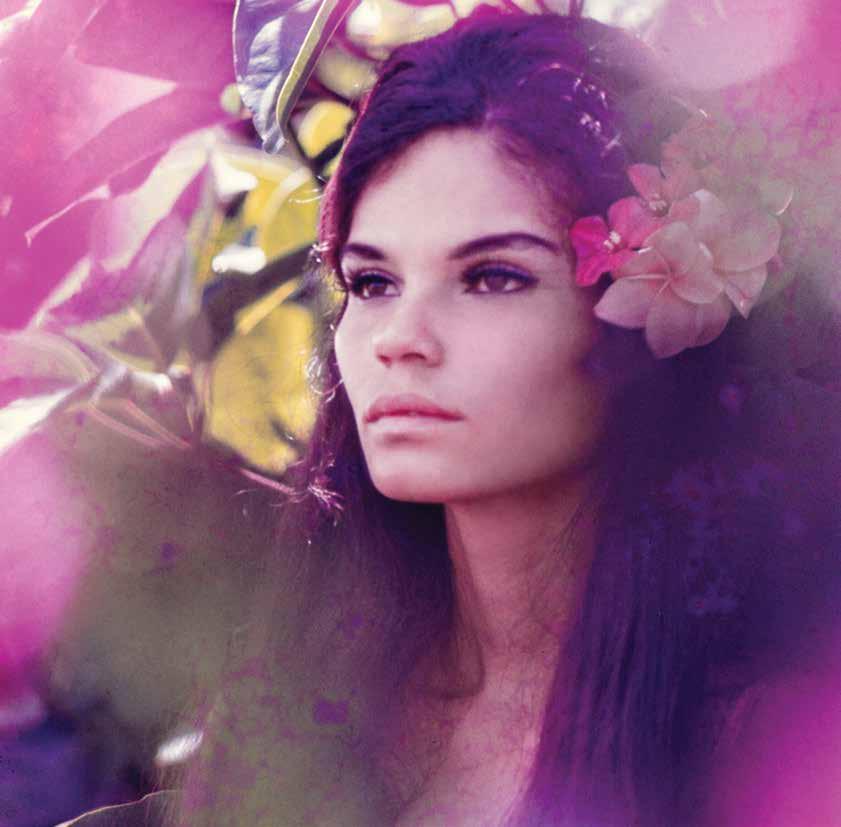
FALL 2014
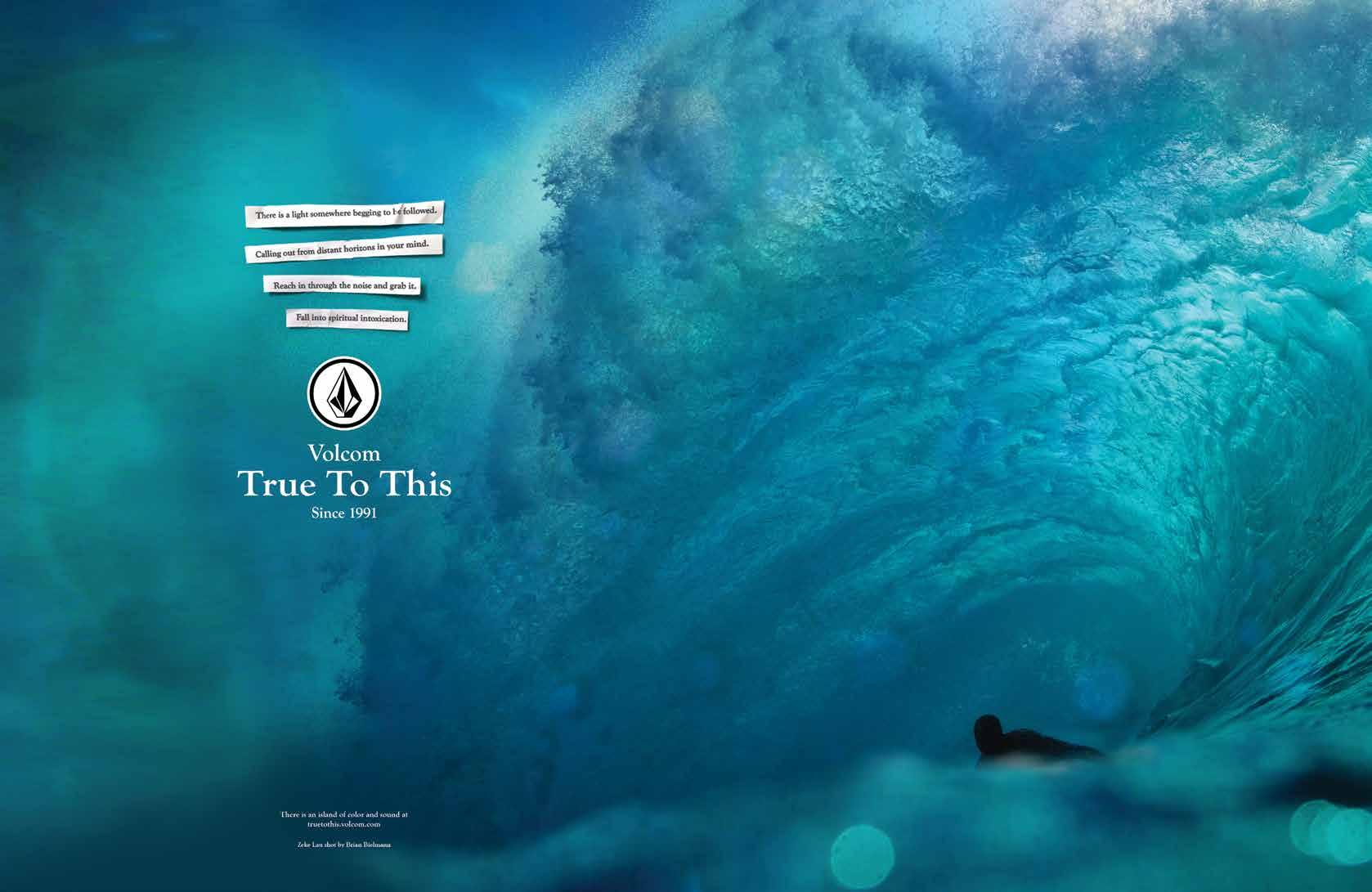

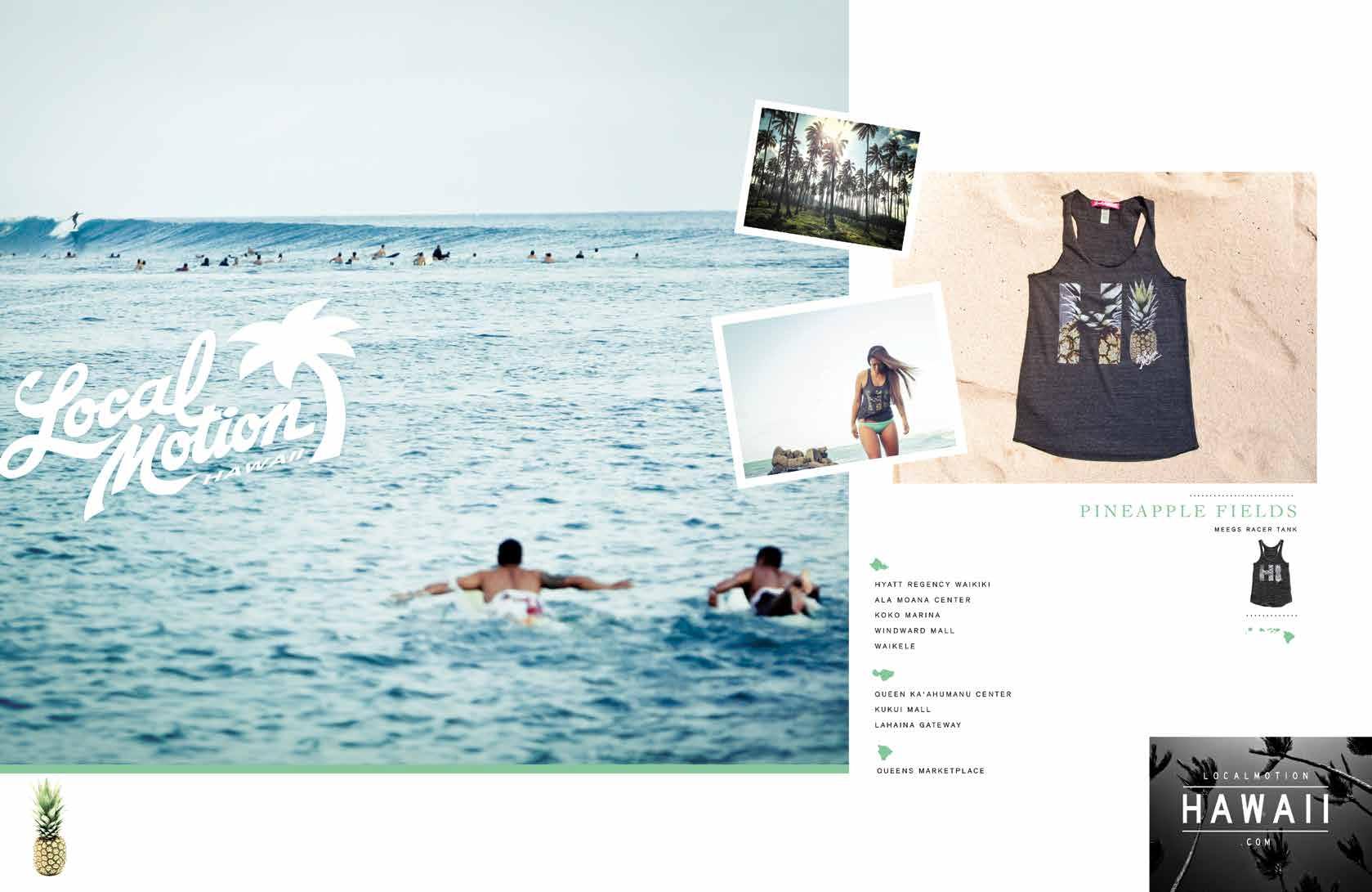

36
STARSHIP HAWAI‘I
Less than two centuries ago, Hawai‘i was a sovereign nation. Community discussions during the last year indicate that it may one day regain that status, but many questions remain. Editor-at-large Sonny Ganaden wonders, does Pacific science fiction have the answers?
TABLE
OF CONTENTS | FEATURES |
44
A GOLDEN LINEAGE
Creators Satoru Abe and Alma McGoldrick helped shape the landscape of visual arts in Hawai‘i in the 1970s. Today, they remain devoted to making more, making better, making of and for Hawai‘i.
62
ORCHID RUNNERS
Given the diversity and brilliance of orchids, it is ironic that the flowering scene is largely comprised of elderly fanatics. Surging out of the primordial vortex of naturalists, however, is a new breed of hobbyists, arriving with fresh energy and vigorous exuberance.
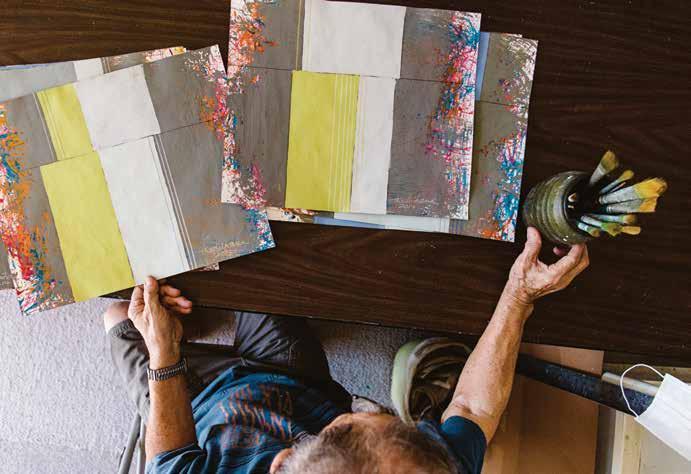
“A lot of his work has innuendos. Try look. To me, he’s a voyeur,” painter Harry Tsuchidana says about his friend Satoru Abe, one of Hawai‘i’s most inexhaustible creative forces.
68
ALOHA FRIDAY
Born in the 1960s out of a spirit of rebelliousness and personal style, Aloha Fridays set the tone for the look that has come to define Hawai‘i. Collagist Landon Tom pieces together how the casual work wear still inspires the dress of today.
6 | FLUXHAWAII.COM
52
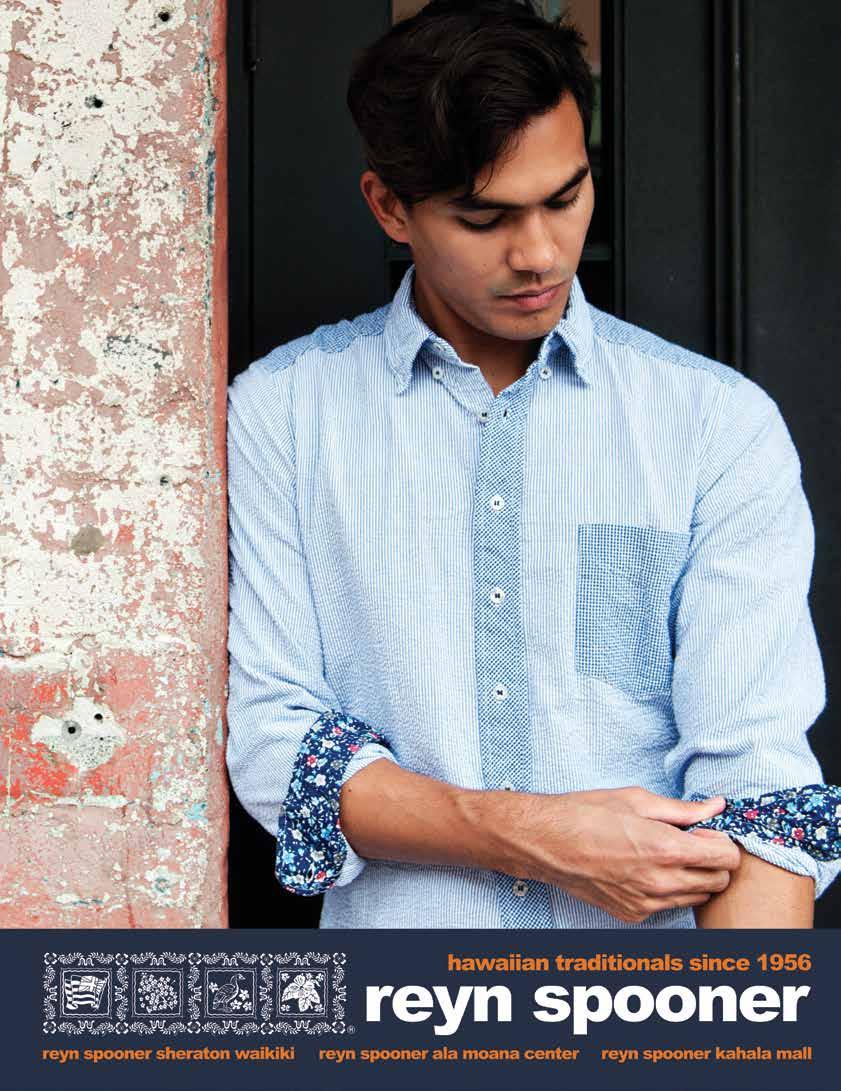



8 | FLUXHAWAII.COM TABLE OF CONTENTS | DEPARTMENTS |
LETTER CONTRIBUTORS LETTERS TO THE EDITOR 20 WHAT THE FLUX?! LET’S TALK ABOUT IT 22 LOCAL MOCO: KIMO KAHOANO FLUX FILES 25 DESIGN: SHEINFELD RODRIGUEZ A+D 28 ART: GAYE CHAN CULTURE INFLUX HOMECOMING 77 CONFETTI SYSTEM LIFESTYLE 80 LOOKBOOK: MOD SPACE 82 STATIONARY STATIONERY 90 A PERFECT DAY ON MAUI FOOD 84 ‘ULU: AN ENDURING LOVE AFFAIR 86 SHELDON SIMEON’S MIGRANT MAUI 88 JUSTIN PARK: THE HOMETOWN HERO VIEWS IN FLUX BOOKS 92 KILOMETER 99 94 THE VALUE OF HAWAI‘I 2 ARTS 96 ART DECO HAWAI‘I COMMUNITY 98 PUBLIC SOLUTIONS FOR HOMELESSNESS 100 CONFRONTING GHOSTS 108 GUIDES 28
EDITOR’S
Gaye Chan’s Eating in Public projects look to recreate the commons, where food and knowledge are freely shared.
84 25
3D-design duo Sheinfeld Rodriguez A+D live off the grid on a farm in Holualuoa.
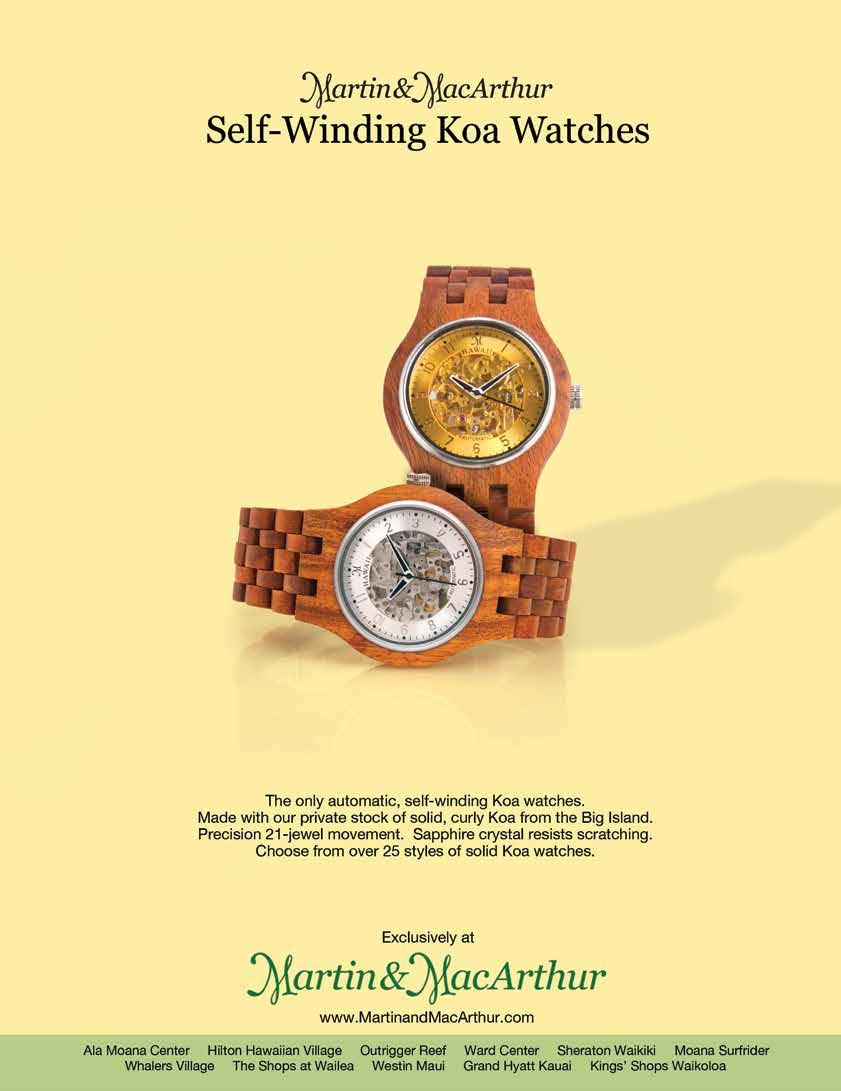
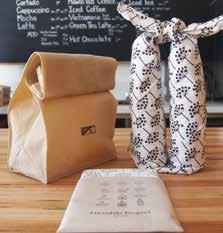
BACK TO OFFICE CRUISING ALONG
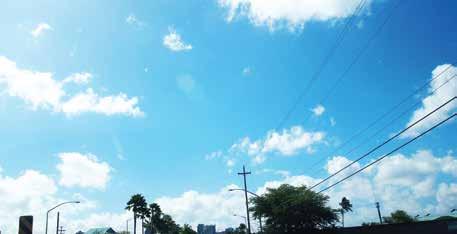
To celebrate the Aloha Friday issue online, we will be sharing some never-before-seen film photos by Alma McGoldrick (1970s photographer extraordinaire, whose story is on page 46). Joining it are a blog series documenting the ranges of alternative transportation on O‘ahu (aptly named Cruising Along) and a collection of the freshest “back to office” supplies from local shops around Honolulu.
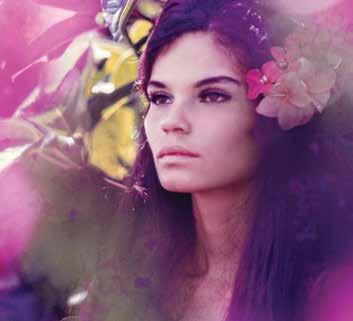
ON THE COVER:
On the cover is a photograph taken by Alma McGoldrick from the 1970s. “I can’t remember what the model’s name was, but shots of these pretty girls and flowers kept me busy when I didn’t have fashion assignments,” says McGoldrick, who made a living shooting for local designers in Hawai‘i from the 1960s through 1980s. Read about the intrepid photographer on page 46.
Also featured is custom hand-drawn lettering by University of Hawai‘i at Mānoa design professor Chae Ho Lee. “The lettering I did for Aloha Friday was inspired by English Roundhand calligraphy from the 17th century,” says Lee, whose lettering process begins with sketches and is then refined digitally. “The lettering tries to reflect a flowing easiness yet refined appearance.”
10 | FLUXHAWAII.COM TABLE OF CONTENTS | FLUXHAWAII.COM |
WE MAY BE A QUARTERLY, BUT WE’RE BRINGING STORIES ALL THE TIME ONLINE.
Stay current on arts and culture with us at: fluxhawaii.com facebook /fluxhawaii twitter @fluxhawaii instagram @fluxhawaii







EDITOR’S LETTER
| LISA YAMADA |












Five and a half years ago, I launched FLUX Hawaii during what’s now known as the Great Recession of 2009, the nation’s worst since the Great Depression in the ’30s. Of course, starry-eyed with optimism, this was of no matter. I was convinced that the market would bear a magazine of this kind—the kind that told stories others wouldn’t; the kind that reflected Hawai‘i’s vibrant culture both past and present; the kind that derided perceptions of lackadaisical living and instead promoted a people and place always moving forward, never stagnant— constantly in flux.
Of course, everyone around me balked. Traditional media scoffed. My biggest supporters were also my harshest critics. The magazine, which I consider an extension of myself, has been called despicable, fluffy, frivolous, irreverent, violent, and shocking.
Yet here we are, five and a half years later, about to take this show on the road, with distribution expanding nationwide and to Japan. Looking back at a folder on my desktop labeled “My Future,” filled with ideas, budgets, competitive analyses, marketing strategies—all the essentials of business planning 101—I found an early version of a media kit from February 2009 that noted our vision: “At the very center of the Pacific, Hawai‘i serves as a place of influx, as a bridge between the East and West. Given this unique positioning, our vision is to reorient both how our city, as well as the rest of the world, conceives of our islands.” While we’ve evolved and
grown up a lot over the years, our vision remains the same.
This Aloha Friday issue is reflective of our journey. Born in the 1960s, during a time when aloha attire was not allowed in the workplace, Aloha Fridays became a movement that grew out of a spirit of rebelliousness and personal style, popularized by those who wanted to promote Hawai‘i’s burgeoning fashion industry, as well as buck social norms. The people featured in this issue, who capture this spirit, found success by doing things their way, against all odds.
Making FLUX Hawaii what it is today could not have happened anywhere else. The support of people we’ve met along the way— who eventually turned into friends who turned into staff—is why FLUX Hawaii is possible. This place, the loneliest, most isolated landmass in the world, is teeming with opportunity, with swerve and verve, with those who were crazy enough to take the leap.
As we move into exciting new stratospheres, my hope is that you, Hawai‘i, will keep doing what you’re doing. Our future depends on it.
With aloha,
Lisa Yamada EDITOR
lisa@nellamediagroup.com
12 | FLUXHAWAII.COM
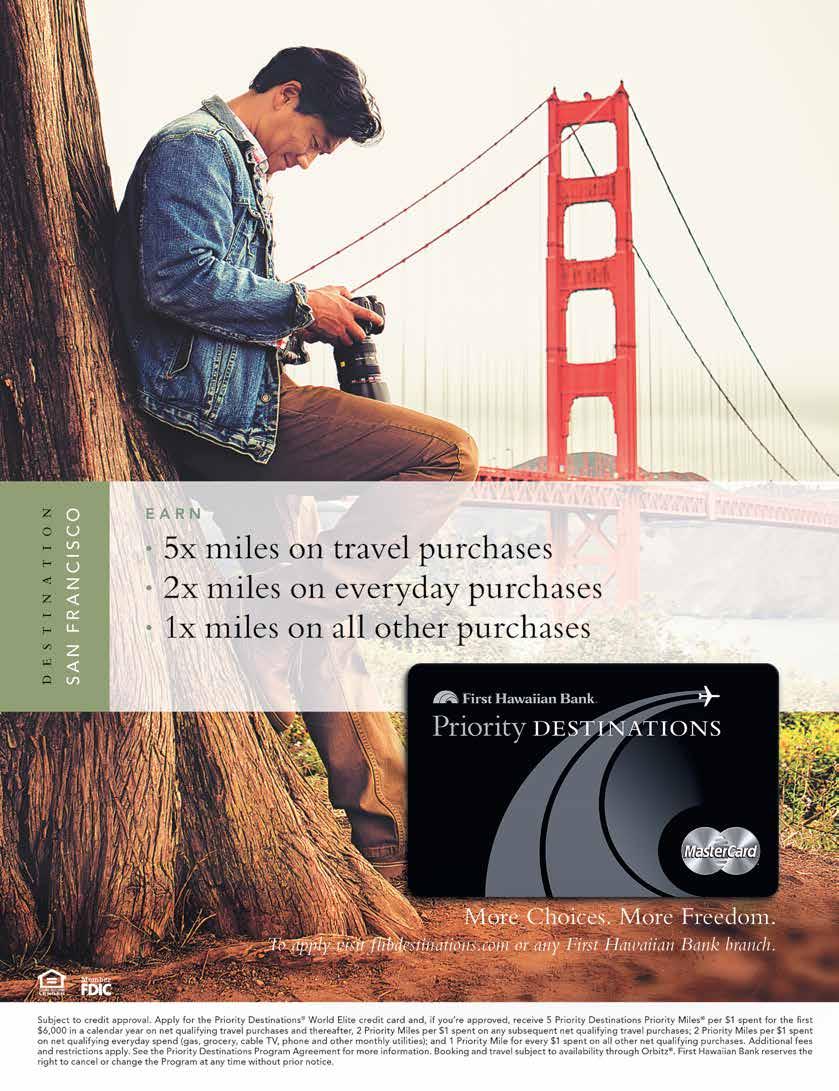
PUBLISHER
Jason Cutinella
EDITOR
Lisa Yamada
CREATIVE DIRECTOR
Ara Feducia
MANAGING EDITOR
Anna Harmon
PHOTOGRAPHY DIRECTOR
John Hook
PHOTO EDITOR
Samantha Hook
FASHION EDITOR
Aly Ishikuni
EDITOR-AT-LARGE
Sonny Ganaden
COPY EDITORS
Cole Tanigawa-Lau
Andrew Scott
IMAGES
Mark Ghee Lord Galacgac
Harold Julian
Sarah Forbes Keough
Tommy Shih
Haren Soril
Megan Spelman
Landon Tom
Aaron Van Bokhoven
Aaron Yoshino
MASTHEAD
CONTRIBUTORS
Carmichael Doan
Beau Flemister
David A.M. Goldberg
Tina Grandinetti
Kelli Gratz
Jennifer Meleana Hee
Mitchell Kuga
Jeff Mull
Sarah Ruppenthal
Bianca Sewake
Liza Simon
Haren Soril
WEB DEVELOPER
Matthew McVickar
ADVERTISING
Mike Wiley
GROUP PUBLISHER mike@nellamediagroup.com
Keely Bruns VP MARKETING & ADVERTISING keely@nellamediagroup.com
Bryan Butteling BUSINESS DEVELOPMENT bryan@nellamediagroup.com
OPERATIONS
Joe V. Bock
CHIEF OPERATING OFFICER joe@nellamediagroup.com
Gary Payne BUSINESS DEVELOPMENT DIRECTOR gpayne@nellamediagroup.com
Jill Miyashiro OPERATIONS DIRECTOR jill@nellamediagroup.com
Matt Honda CREATIVE DIRECTOR
Louis Scheer JUNIOR DESIGNER
INTERNS
Michelle Ganeku
Torrey Seabolt
General Inquiries: contact@fluxhawaii.com

PUBLISHED BY:
Nella Media Group 36 N. Hotel Street, Suite A Honolulu, HI 96817
©2009-2014 by Nella Media Group, LLC. Contents of FLUX Hawaii are protected by copyright and may not be reproduced without the expressed written consent of the publisher. FLUX Hawaii accepts no responsibility for unsolicited manuscripts and/or photographs and assumes no liability for products or services advertised herein. FLUX Hawaii reserves the right to edit, rewrite, refuse or reuse material, is not responsible for errors and omissions and may feature same on fluxhawaii.com, as well as other mediums for any and all purposes.
FLUX Hawaii is a quarterly lifestyle publication.
14 | FLUXHAWAII.COM
| FLUX HAWAII MAGAZINE |


“Someone recently told me, ‘There’s a difference between authentic and real; someone real will tell it like it is, no matter the outcome,’” says Kelli Gratz, reflecting on her interview with Alma McGoldrick on page 46. “For me, it wasn’t her resumé, nor the occasional profanity, that made Alma real, it was the interstices caught at moments of contemplation.” Gratz, who holds an English literature degree from University of Hawai‘i at Mānoa, combines her passion for creative writing with the offbeat side of culture and travel.

“I love visiting artists’ studios,” says Mitchell Kuga, who profiled New York-based, Honolulu-born Nicholas Andersen of Confetti System on page 77. “There is so much information in what goes on behind the scenes, and in some ways, I find the experience more honest and powerful than the work displayed behind glass.” A freelance writer and waiter from Honolulu currently based in Brooklyn, Kuga is an editor of SALT, a newspaper about food and pain in New York City.
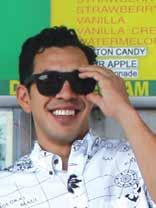
“I’m certainly not the first fanboy nerd to grow up and find himself writing about community,” says Sonny Ganaden, who wonderes if sci-fi can help us address Native Hawaiian sovereignty issues on page 36. “I understand there are ways of discussing inequality outside of blame and victimhood, so I focus on the dreamers and artists making a difference and having fun with it.” The lawyer, writer, and artist was the lead writer for the Native Hawaiian Justice Task Force Report in 2012 and was recently selected as an Orvis Artist in Residence through the Honolulu Museum of Art.

“I wanted to use imagery of factories in Hawai‘i coupled with modern fashion accessories like bags and shoes to remind us of some of the processes involved in creating these accessories,” says Landon Tom, who created the Aloha Friday-inspired collages on page 68. Growing up in ‘Aiea listening to his parents Beatles and Jimi Hendrix records, Tom’s first interaction with art came when he cut and pasted concert flyers together for his Operation Ivyinfluenced punk outfit, The Ex-Superheroes. Eventually the time-killing hobby would become the backbone of Tom’s visual art.
CONTRIBUTERS | ALOHA
|
FRIDAY
KELLI GRATZ
SONNY GANADEN
MITCHELL KUGA
LANDON TOM
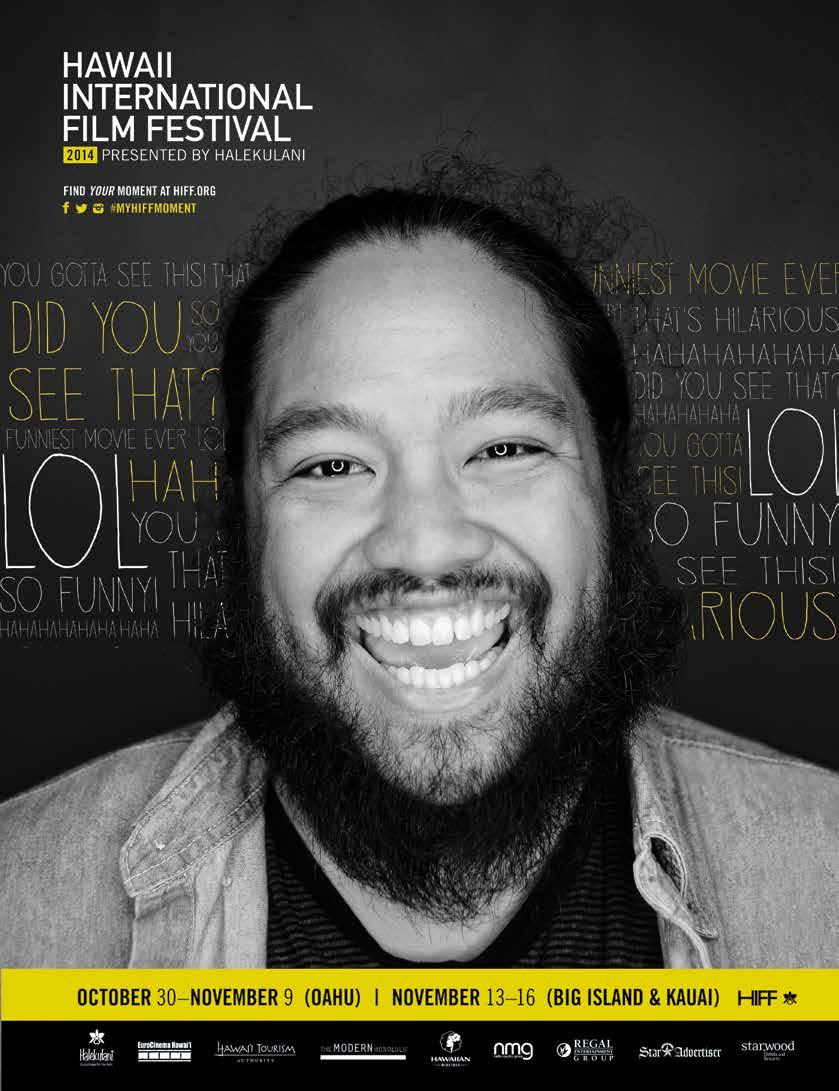
HERE
WE GO…
@SpyHI “Congrats to @NellaMediaGroup for taking @FLUXHawaii international. I’m very happy…they’ll represent Hawaii well.” << We are only as good as the people we portray in our pages.
@DJDELVE “NEW YORK FASHION WEEK IN SEPTEMBER WITH THE @FLUXhawaii CREW!” << We’re as stoked as you are to take this show on the road!
@NonPareil99 “this issue screamed #renaissance done right. great vision; good works! #nostalgic for #ThenAndNow” << @NonPareil99 got nostalgic with our Fashion Issue from spring 2013 and so did we.
@supercw “New @FLUXhawaii on my desk looking amazing as always love the Marilyn Monroe photoshoot at Michael Laughlin’s house thumbs up up up” << It’s good to be loved by you.
SMALL SPACES IN HONOLULU
As housing prices continue to rise, the need to be creative with what you’ve got is becoming increasingly essential. We asked our readers to share their small-butperfect quarters, be it boat, cottage, or downtown apartment. Spaces had to be 800 square feet or less. Here are a couple of our favorites:

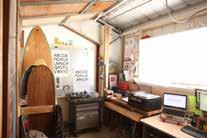
Tricia Beaman’s 540-square-foot Kaimukī living space is brightened with natural light. What she fancies about going small? “It forces you to live simply and surround yourself with only the things you love.”
In Gavin Murai’s 99-square-foot working studio in Kaka‘ako’s Lana Lane, everything is built to be space-efficient yet functional. His favorite item within? “The surfboard quiver. It’s like a tie rack; there’s something for every occasion.”
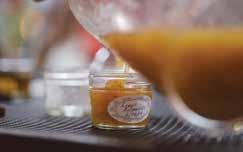
SUMMER JAM
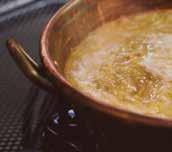
We kicked off summer and the release of our Consumption issue with a jamming workshop by Monkeypod Jam’s Aletha Thomas. With jam-infused cocktails and bites, mixed and made by Hasr Bistro, the summer truly couldn’t have been any sweeter. Subscribe now to FLUX Hawaii and stay in the know about subscriberonly events and workshops.
18 | FLUXHAWAII.COM LETTERS TO THE EDITOR | ALOHA FRIDAY |
WE WELCOME AND VALUE YOUR FEEDBACK. SEND LETTERS TO THE EDITOR VIA EMAIL TO: LISA@NELLAMEDIAGROUP.COM OR MAIL TO FLUX HAWAII, 36 N. HOTEL ST., SUITE A, HONOLULU, HI 96817.

WHAT THE FLUX
LET’S TALK ABOUT IT: LANGUAGE AND MULTILINGUALISM IN HAWAI‘I
“Just cuz you know Pidgin doesn’t mean you cannot know English. It’s like da more languages you know, da more power to you, right?”— Lee Tonouchi, Da Pidgin Guerilla
While we love to think we live in a world of equality, discrimination—conscious and unconscious— based on language still happens every day. Decades ago, the general consensus was that English was aligned with success and bilingualism stunted the brain, and thus the use of
native tongues was strongly condemned. Instead, today, research is emerging that positively correlates bilingualism and the empowerment of knowing a language with being able to effectively communicate with one’s broader communities. Take, for example, Hawai‘i Pidgin, a dialect that developed among plantation workers out of the need to communicate between numerous linguistic backgrounds. Since its inception, Pidgin has been deemed a “crude” way of speaking. But in the broader scheme, this multilingual mode allowed for the incorporation of many languages and cultures and is a tactic some argue as the best way to move ahead in the world today, where more than 50 percent of the global population is said to use more than one language in everyday life. Here, we expound upon the power of language, and the more-power-to-you potential of multilingualism in Hawai‘i.
Let the nays be heard: 1890s
A professor at Cambridge University reports that second-language acquisition halves spiritual and intellectual growth.
1895
An excerpt from the first biennial report of the Bureau of Public Instruction of the Republic of Hawaii after the overthrow of the Hawaiian monarchy states, “The gradual extinction of a Polynesian dialect may be regretted for sentimental reasons, but it is certainly for the interest of the Hawaiians themselves.” One year later, English is made the only medium of instruction in all schools, and children are soon punished if they are caught speaking Hawaiian.
2004
In a journal article entitled, “Da State of Pidgin Address,” Lee Tonouchi, who holds a master’s degree in English and is a fervent Hawai‘i Pidgin activist, tells of when he was handed a note at Big City Diner that read: “[Hawaiian Creole English] is a badge of ignorance and illiteracy. … Grow up and have some respect for the language of Shakespeare and Milton,” about his Pidgin short story “Ben the Betrayer.”
2010
A researcher from The University of British Columbia finds that in an ESL classroom in a public Hawai‘i high school, Micronesian students are strongly discriminated against by fellow students.
2013
The state of Hawai‘i is sued for making it too hard to apply for a driver’s license for those with limited English proficiency. (Shortly thereafter, tests—though not manuals—are made available in 12 languages other than English.)
20 | FLUXHAWAII.COM
Let the yays be heard:
1820s
King Liholiho sends out Hawaiians to teach the written language in the country districts.
1984
Hawaiian language-immersion preschools are opened. According to Hawaiian language expert Helen B. Slaughter, participating in Hawaiian language immersion gives students the message that they can be proud of who they are as Hawaiians.
1993
Study done of a Wai‘anae second-grade class determines that by speaking Pidgin with their teacher, students are able to articulate their knowledge, which facilitates their interest and improves their writing in standard English.
2006
Hawai‘i’s Office of Language Access is established to help the state develop plans to provide interpretation services and translated documents in languages other than English.
2011
Research by professors from University of Georgia and College of William and Mary finds that bilingualism and creativity are positively correlated—the more fluently bilingual, the more creative the student.
2013
A Time Magazine article states that “a multilingual brain is nimbler, quicker, better able to deal with ambiguities, resolve conflicts and even resist Alzheimer’s disease and other forms of dementia longer.”
FAST FACTS
28%
The percentage of Hawai‘i’s population that speaks another language at home (7% higher than the U.S. rate), according to the 2010 U.S. Census.
600,000
The number of Pidgin speakers who count Pidgin as their first or second language in 2012.
15
The number of Hawaiian-languageimmersion, English-Hawaiian bilingual, and Native Hawaiian culture immersion public charter schools in Hawai‘i.
1920
The year that Hawai‘i Pidgin, composed of languages including English, Hawaiian, Cantonese, and Japanese became the dominant dialect among plantation children.
1978
The year that English and Hawaiian are announced as the official languages of Hawai‘i.
6%
The amount of Hawai‘i’s population that is said to be linguistically isolated (no one 14 or older speaks English in the home) in 2008.
Percent breakdown of second languages spoken at home (Age 5 and older)
Source: U.S. Census Bureau, 2006-2008 American Community Survey
FLUXHAWAII.COM | 21
TAGALOG 17.7% JAPANESE 16.7% ILOCANO 15% CHINESE 9.5% SPANISH 8.4% HAWAIIAN 6.1% KOREAN 6% OTHER PACIFIC ISLANDER 4.2% SAMOAN 3.6% VIETNAMESE 2.3% OTHER 10.5%

“I still get requests for ‘Aloha Friday.’ And when that happens, I will sing it. Because this song is the song of the people,” says Kimo
of his legendary tune.
Kahoano
LOCAL MOCO
| KIMO KAHOANO |
IN THE KEY OF KIMO
ALOHA FRIDAY, THE PEOPLE’S SONG, AS SUNG BY THE LEGENDARY EMCEE
TEXT BY LIZA SIMON | IMAGE BY JOHN HOOK
As I walk through Waikīkī, I savor the irony of heading to talk story with a man who often works on balmy Sunday afternoons like this one even though he gave Hawai‘i its most tuneful tribute to weekend recreation—a jaunty little lyric called “Aloha Friday.” That man, who crooned the hit 33 years ago, is Kimo Kahoano. Today, he is hosting a hula event. Of course he is. In addition to being one of the isle’s major radio and television personalities, he is Hawai‘i’s pre-eminent emcee, an ever-enthusiastic impresario for everything from funky canoe-club fundraisers to the mega-spectacle of the Merrie Monarch competition. He’s in high demand for his ineffable presence. And that novel little ditty from decades past remains part of his cred.
“Wherever and whenever I am on stage, I still get requests for ‘Aloha Friday.’ And when that happens, I will sing it. Because this song is the song of the people. It’s not just my song,” he proclaims while on break from his duties. While he admits (with my nudging) that this Sunday would be a good day for his favorite game, golf, he says the years have taught him that while he is on the job he should simply enjoy becoming an “extension of the surrounding community.” With that, he strums his air ukulele and croons: “It’s Aloha Friday/ No work ’til Monday …” Hula notables and uniformed hotel employees pass us by and flash smiles and shakas, prompting
Kahoano to comment that Hawai‘i’s TGIF celebrations can take place on any day of the week: “It’s pau hana time. It’s about working hard, whenever we can, doing all we have to do, but still finding time to go enjoy. That’s the local story,” he says.
That local story, as Kahoano calls it, is also a story that was mostly absent from Hawai‘i’s stage performance until a period known as the Hawaiian Renaissance revived not only native cultural tradition but also inspired artistic innovation. “Aloha Friday” was the product of this era, Kahoano explains.
As the Renaissance got rolling in the 1970s, Kahoano was already an established fire-knife dancer and choreographer in Polynesian revues at the glitziest Waikīkī showrooms. However, with change in the air, he jumped to KCCN radio, joining a bunch of new DJs emboldened to make their broadcasts into a sonic boom of local identity. He also joined the storied scene at Territorial Tavern in downtown Honolulu, playing music in a band to packed houses of local fans alongside the rising kings of local satire, Booga Booga. “Crazy stuff, but we loved it because it showed in a common-sense way who we are,” Kahoano says. In 1981, his bandmate Paul Natto approached him saying he had written a humorous song; Natto suggested they go record it.
In the basement of an ‘Aiea home surrounded by sound equipment, Natto
first picked out the melody of “Aloha Friday” for Kahoano. In the spirit of the era, Kahoano let it rip, dredging up his acting skills from performance training he’d received as a Kamehameha Schools student. He improvised between choruses, making up a monologue about a bruddah who is off work and cruising for chicks but ends up shelling out his credit card to cover rounds of drinks for other guys. On top of the quasi-rap, Kahoano added in a hook of “Doobie-doobie-doo”—scat singing sampled straight from Frank Sinatra’s “Strangers in the Night”—and then, to finish it off, he and Natto boosted the tempo with the beat of Hawaiian country music. All in a single take.
The song scored plenty radio airplay in Hawai‘i and California. “Lucky that corporate approval of playlists wasn’t around then,” Kahoano says. Just the other day, the godfather of Aloha Friday says, he heard it played by request on a local radio station. Kahoano clasps his hands together as if in prayer and laughs, “I am humbled that there’s something for everybody and for every generation in that song.”
Find Kahoano on—what else—Fridays, broadcasting live from 6–8 a.m. at iheart.com/live/am-940-6087.
FLUXHAWAII.COM | 23
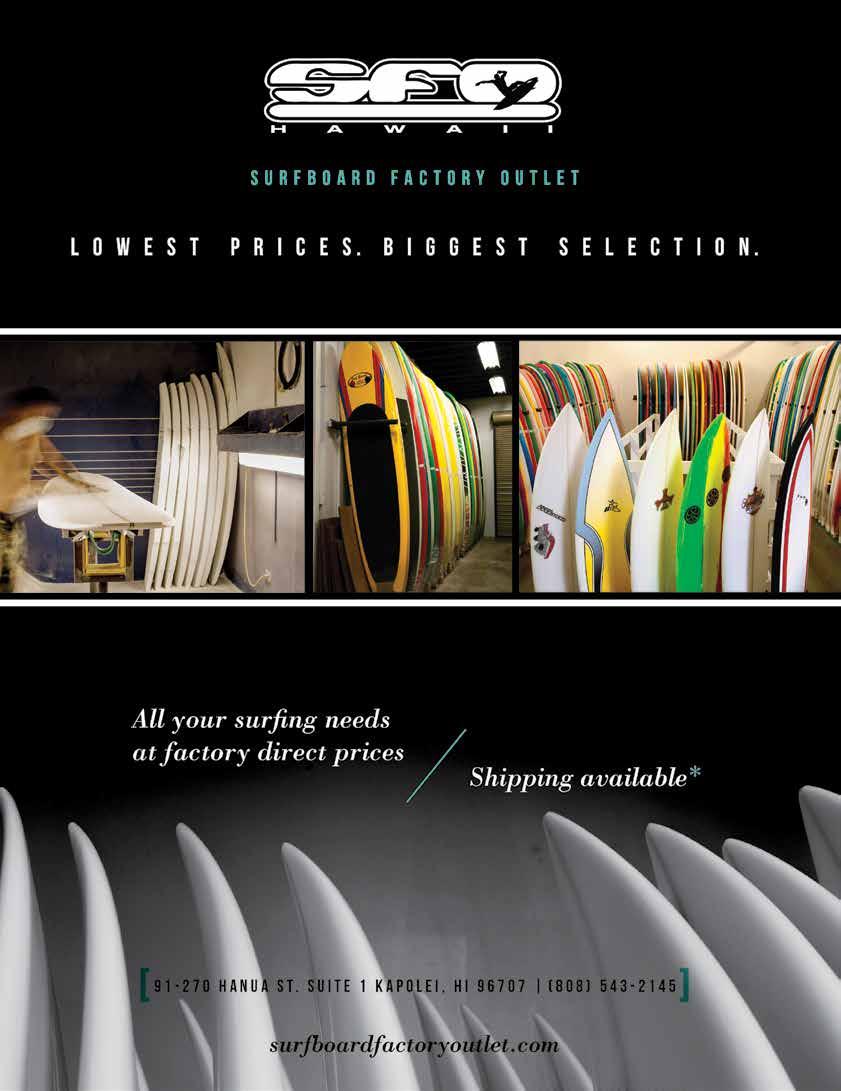

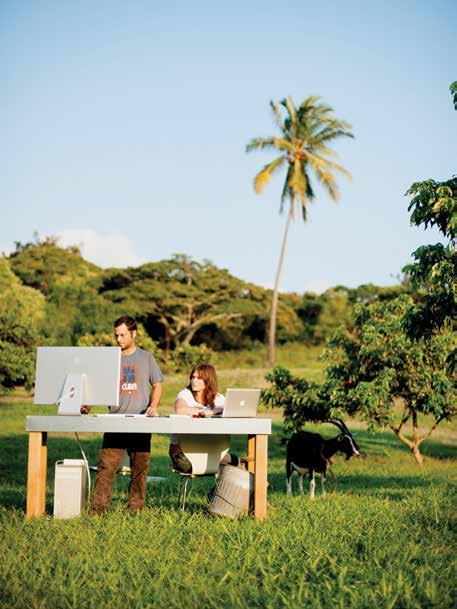
THE NATURE OF IT
TEXT BY ANNA HARMON | IMAGES BY MEGAN SPELMAN
FLUXHAWAII.COM | 25
3D-DESIGN DUO SHEINFELD RODRIGUEZ A+D
FLUX FILES | ART |

Four days a week, at 5:30 a.m., a family of three—father, mother, and 4-year-old son—wake up before the sun to practice yoga with a man who pioneered the discipline in the United States. Afterwards, on weekdays, Daniel Sheinfeld and Loomis Rodriguez, the father and mother, head off to work on various architecture projects around the Big Island before meeting up at a small rented space to work on their collaborative design projects. Next is where their story fully veers off the beaten path— when they come home, their family life is illuminated only by a single solar-powered bulb and a sky full of stars.
“Once you taste what it is to sleep without having any buzz of electricity around you, and the possibility of taking a shower while watching the stars every single night … ” Sheinfeld gushes about living off the grid on a farm in Holualoa before switching topics to the couple’s creative aspirations. Sheinfeld is a highly energetic, tech-enthused Venezuelan who dreamed of living at the epicenter of bustle, New York City, where Rodriguez is from. But instead, four years ago, the two jumped at the chance to move off the grid from Honolulu’s Chinatown to a friend’s 15-acre farm with their then-11month-old son. The three now call home a shed converted into a bedroom and living space, surrounded by goats, sheep, organic produce, a starry sky, and not much else. “True description, we have one light in our bedroom sparked by a single solar panel,”
Bracelets fashioned by Sheinfeld Rodriguez A+D printed on a 3D printer.
he says. They only recently got a muchawaited solar-powered fridge.
The husband and wife seem to have endless energy and creativity; they spend hours each day churning through various phases of Sheinfeld Rodriguez A+D projects, particularly industrial design and jewelry. Their current focus: jewelry inspired by biomimicry, one-off pieces that are essentially wearable sculptures. “Our inspiration is almost completely organic and based in nature, but the way we create it is completely opposite,” he says. They examine the molecular and genetic structure of organisms, the framework and tiny pieces that come together to make a whole. “Instead of just making jewelry that looks exactly like a pineapple, we analyze the pineapple genetically. … From the core of nature we take that essence and transfer it into these beautiful pieces,” he explains.
Their next line will examine the makeup of water, creating jewelry inspired by how it flows along the human body. They already have their sights set on a 3D scanner, so that such a piece can be designed exactly for your neck, your wrist. Already, their jewelry involves complex coding and design, which they then translate into a resin prototype printed with their 3D printer, one of the most sophisticated models in Hawai‘i, a Form 1 by Formlabs, at their space in Holualoa. From there, they send out the prototype to be 3D-printed as a wax mold, which is then cast in precious metals like gold and
silver (they hope to be able to do all this themselves by next year). Once the piece is returned, they make any final refinements with generator-powered tools back on the farm. The result is a signature Sheinfeld Rodriguez A+D design, a highly technical, highly customized, but organic-inspired work of art.
Sheinfeld celebrates a globalized, online world, which has enabled him, for example, to collaborate with a Londonbased Pakistani architect on code-generated holographic prints; a world in which they can live on an island in the middle of the Pacific but have access to advanced technology and clients around the world. On the other hand, he loves that his family has a direct connection to organic produce, nature in abundance, and friends such as one who makes organic honey from 70 hives on the shared land. Of his life off the grid and the relief it provides from his technology-driven creation, he says, “You get really connected to the earth. I don’t think we would be able to do it otherwise, because we would go nuts.”
Find select Sheinfeld Rodriguez A+D creations at Big Island Gallery M3LD, 74-5617 Piwei Pl. For more information, visit sheinfeldrodriguez.com.
26 | FLUXHAWAII.COM
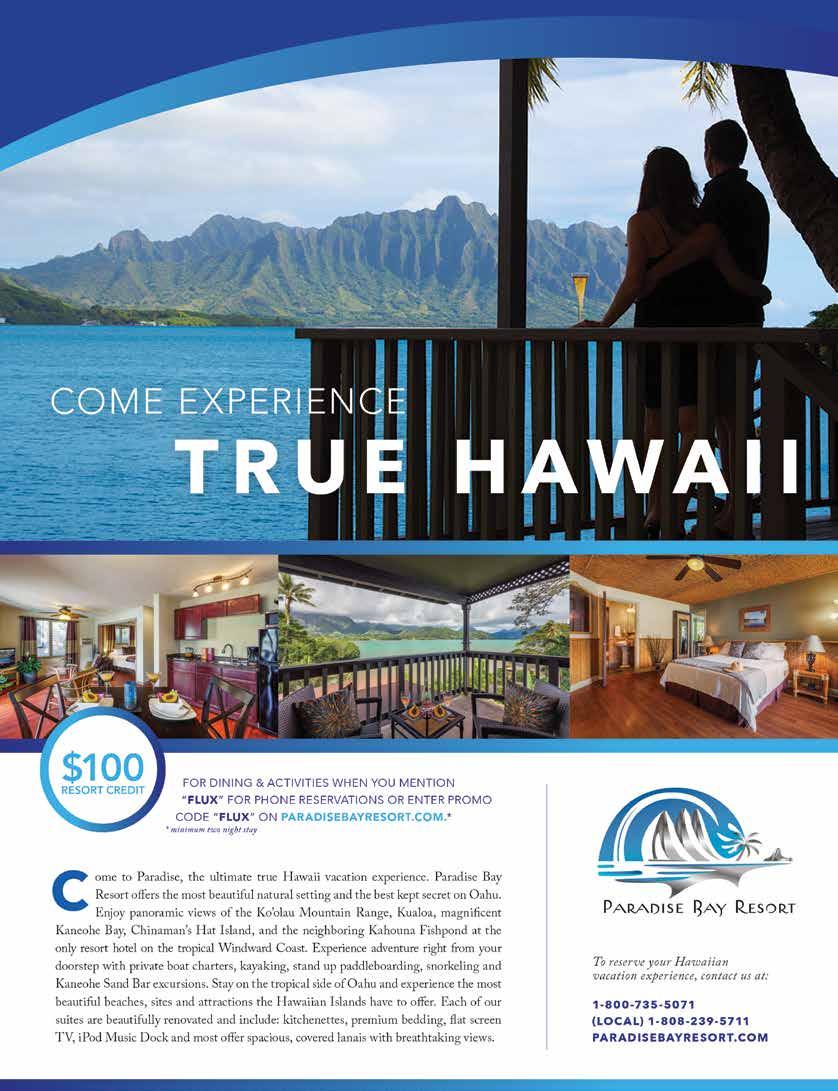
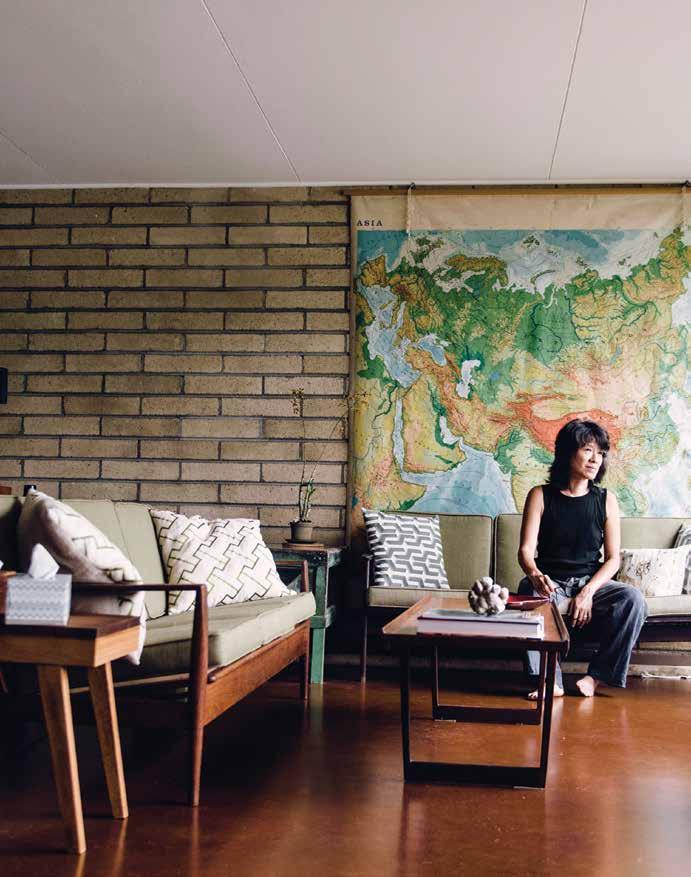
“An elderly woman came up to me and told me, ‘This is the party I’ve been waiting for my whole life,’” says UH
Mānoa art and art history department chair Gaye Chan about a recent Digger’s Dinner, where food and knowledge are freely shared.
TAKE, LEAVE, WHATEVAS
GAYE CHAN’S EATING IN PUBLIC
TEXT BY SONNY GANADEN
IMAGES BY JOHN HOOK
It is nearly impossible to overstate the influence Gaye Chan has had on the arts community in Hawai‘i. As chair of the department of art and art history at University of Hawai‘i at Mānoa, she has prodded countless students to pursue their ideas, identities, and conceptions of art. In her own work, she interrogates what it means to engage in dynamic communities, testing the boundaries of politics and economy. She confronts what those in the art and academic worlds consider normative leadership styles. She throws the most interesting potlucks in Hawai‘i. She has gained enough followers on Instagram to denote a letter: 14K and counting.
At the first public Digger’s Dinner, held in March 2014 at the Commons Gallery in the heart of UH Mānoa, all of Chan’s recent experiments regarding art and community were tested. A proponent of rules in art, Chan laid out the requirements for participating in the potluck: “Participants’ contribution must be primarily made from ingredients that they have either grown, hunted, fished, foraged, bartered, found, been gifted, or stolen. Digger’s Dinners are exercises in recreating the commons, where food and knowledge are freely shared. Participants will be asked to introduce their dish and where the ingredients came from. Any leftovers will be freely distributed the next day.”
TAKE: Act without shame.
LEAVE: Share without condition.
WHATEVAS: Trust without apology.
Most participants were game to the rules of a potluck in an academic art gallery. But there was a big difference between the event and often stuffy contemporary art shows: People were happy! The space was packed with current and former students, university people, defiantly non-university people, and members of the community who had heard about the party on the radio, read about it in the paper, or were tagged in an Instagram post. In lieu of an art show, when the tropical heat makes a joke of layered fashion and kitschy sales of Hawaiiana make contemporary art sales feel like a struggle, contributors stood in a long line to share their recipes and the myriad ways of overcoming the rules. Of course the sound system was a jerryrigged art contraption that didn’t work, but no matter, the food was delicious. Some questions went unaddressed over the microphone: Is this a potluck or an art show? Is this an attack on capitalism or a promotion of locally grown food? An incitement to petty theft? Chan, the orchestrator, seemed happy with the ambiguity. “An elderly woman came up to me during the event and showed me the newspaper clipping from the arts section of the paper,” she remembers. “She told me, ‘This is the party I’ve been waiting for my whole life.’”
The idea for the Digger’s Dinner developed organically over the last several years of Chan’s artistic practice. Years prior, Chan and her partner, Nandita Sharma, a professor of sociology at UH Mānoa, lived and worked out of a home in the Enchanted Lakes neighborhood of Kailua, where they began to call their communal art/sociology/anarchy experiments “Eating in Public.” In a strip of grass abutting a fenced-off lake for Enchanted Lake residents, they planted papaya trees. Weeks later, they engaged in a public, old-school battle via signage in front of their trees with the reluctant groundskeepers who were employed by the landowner, Kamehameha Schools. Eventually, the papaya trees were cut down and the fence extended out to the sidewalk—the public space lessened by two feet. But not all was lost: Two weeks after the trees were felled, the Enchanted Lake neighborhood assisted in creating a communal garden near where the trees had stood. “Most of us are suburbanites and don’t know a thing about farming, so there were crazy ways of harvesting,” she says. “We eventually put signs up on how to take, what herbs are used for, even recipes.”
It feels fresh, but Chan is careful to explain that she is not engaged in neologism. She is continuing the work of those over the last several centuries who
FLUXHAWAII.COM | 29
FILES | ART |
FLUX
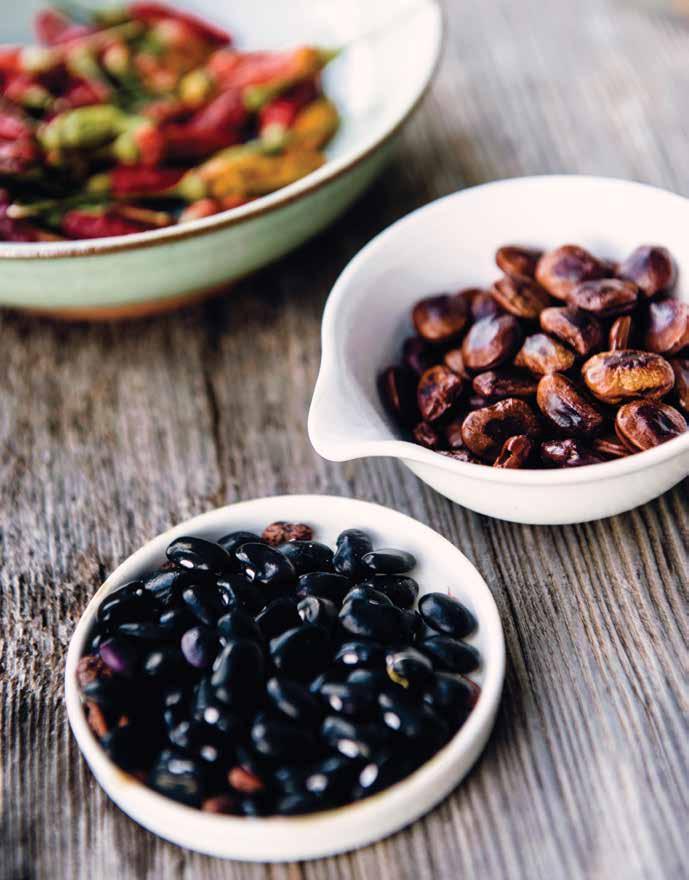 Gaye Chan takes inspiration from 17th-century commoners who engaged in activist planting at the outset of the private-property revolution. “We’re not exactly continuing the work of the diggers, we are the diggers,” she says.
Gaye Chan takes inspiration from 17th-century commoners who engaged in activist planting at the outset of the private-property revolution. “We’re not exactly continuing the work of the diggers, we are the diggers,” she says.

have challenged capitalism’s capacity to ensure equitable lives. Blending the anti-authoritarian and the academic, Chan cites 17th-century commoners as her inspiration: serfs who were pushed off communal land at the outset of the private-property revolution and became farmers engaged in activist planting. As private-property owners divvied up plots and divested those without inheritance of land, public terrain became increasingly ornamental, unconnected to the necessities of food, water, building materials, and heating. Some of the displaced farmers formed the Diggers, whose signature act was to plant edible foods on their recently expropriated land. “We’re not exactly continuing the work of the diggers, we are the diggers,” Chan says. “We are continuing the same project: the return of our commons.”
Eating in Public includes other projects with similar reach. For the last several years, members have built seed stations and placed them in public places throughout Hawai‘i and abroad: schools, libraries, community centers. By last count, there are approximately 880 seed sharing stations located across the islands. There may be more, created by autonomous cells of diggers. An online gallery tour shows them to be quite cute. Painted with hokey plants, plastered with stickers, they are the opposite of what might be considered contemporary fine art, the type of thing a fine artist might use as inspiration.
By respecting this existing culture, Chan and her loose group of collaborators have highlighted the capacity of contemporary art to cast a light on the practices of ordinary lives. For local reference, one does not need to reach back to pre-contact Hawai‘i to find communities who bartered goods and services outside of modern capitalism. Most folks do some sort of trade: babysitting for a ride for a dinner for a place to crash for a week with friends. The barter economy (or hook-up economy) is the social lubrication of personal debt that ties many of us to each other, especially in lower socio-economic and artistic communities. Today’s Hawai‘i is also filled with the types of people who wouldn’t ordinarily consider
themselves contemporary artists: hula dancers, aunties who make costumes for hālau, uncles who work on sustainable gardens, and crafters who fill Honolulu’s Blaisdell Arena for annual fairs.
For Chan, Eating in Public is only a portion of a life in contemporary art. While on sabbatical during 2013 to develop her work and spend time with her ailing father, she took to Instagram. A lifetime of thinking about photography, content, and composition was at play immediately. Taking note of musician John Cage’s ideas considering the boundaries of art, she devised a couple for herself: no filters, nothing but pictures from her phone. Before long, a discarded orange peel on cracked asphalt became a metaphor for depression, a defaced political sign became a symbol for protest, and countless images of people showed life as it is in Hawai‘i and the places she travels. “I like to take photos of nothing,” she says blithely of what may be the medium that has made her most famous. A closer inspection reveals that the images are in sets: a series of fence images, a series of fruits, a series of people covering their faces awkwardly, plenty of coincidences, another medium with which to test theories of art and community.
There is a danger in giving some definition to an individual who is adept at defining her own work. As an ideating leader in a community of artists, it can be said that she is concerned with delimitation—the ways to transcend the boundaries created by political, economic, and aesthetic systems. In a TEDxHonolulu talk last year, Chan concluded with a directive: “If you like our ideas, contact us. Better yet, don’t contact us. Take them and run as far, smart, and fast as you possibly can.”
For more information or to keep up with Chan’s projects, visit nomoola.com.
32 | FLUXHAWAII.COM
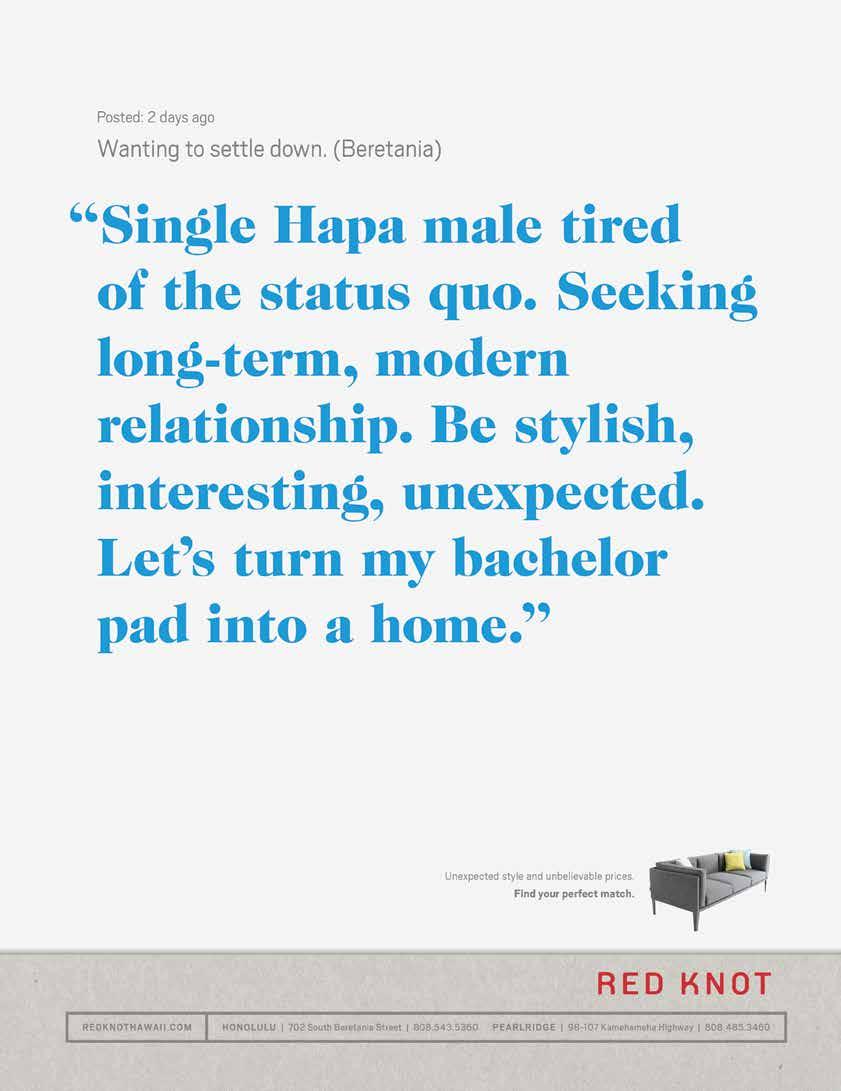
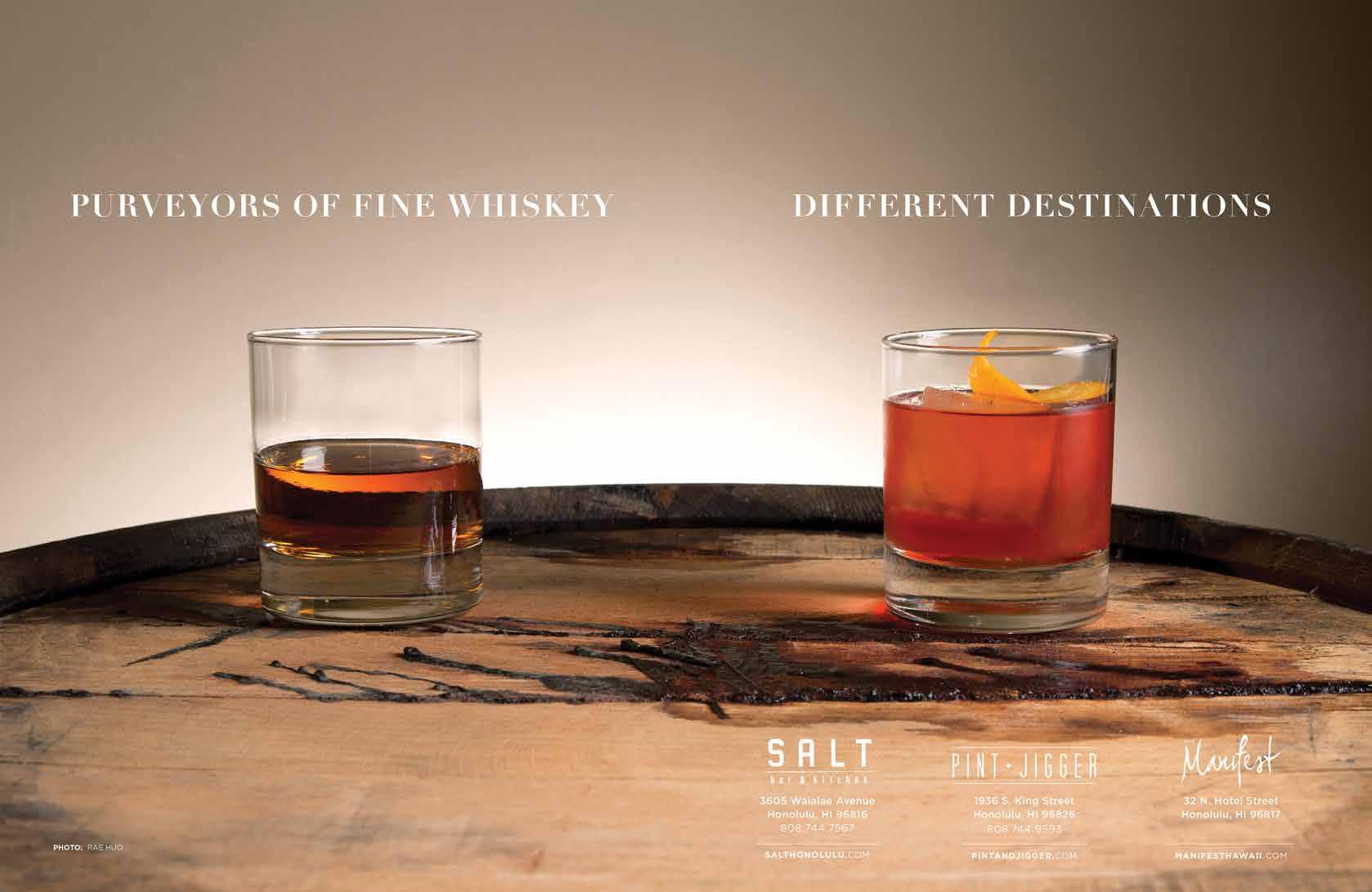

 “Year 7,750, The Wu‘ugone Seed City within the Houdese Womb-World,” 2014, Solomon Enos. Pencil and digital. Opposite: “Year 31,009, A Light-Blood Class Human Seed Ship in transit to the Abūchato‘onalūpapa System via Dream-Space,” 2014, Solomon Enos. Acrylic and digital.
“Year 7,750, The Wu‘ugone Seed City within the Houdese Womb-World,” 2014, Solomon Enos. Pencil and digital. Opposite: “Year 31,009, A Light-Blood Class Human Seed Ship in transit to the Abūchato‘onalūpapa System via Dream-Space,” 2014, Solomon Enos. Acrylic and digital.
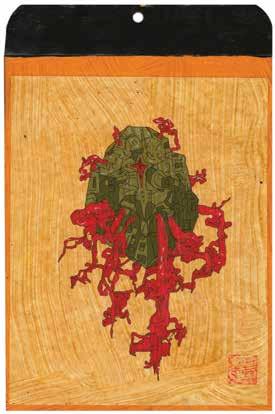
STARSHIP HAWAI‘I:
IS SCI-FI THE ANSWER?
RE-ENVISIONING HAWAI‘I’S
TRAUMATIC PAST PROVIDES A NEW HOPE FOR THE FUTURE.
TEXT BY SONNY GANADEN | IMAGES BY JOHN HOOK ARTWORK COURTESY OF SOLOMON ENOS
FLUXHAWAII.COM | 37
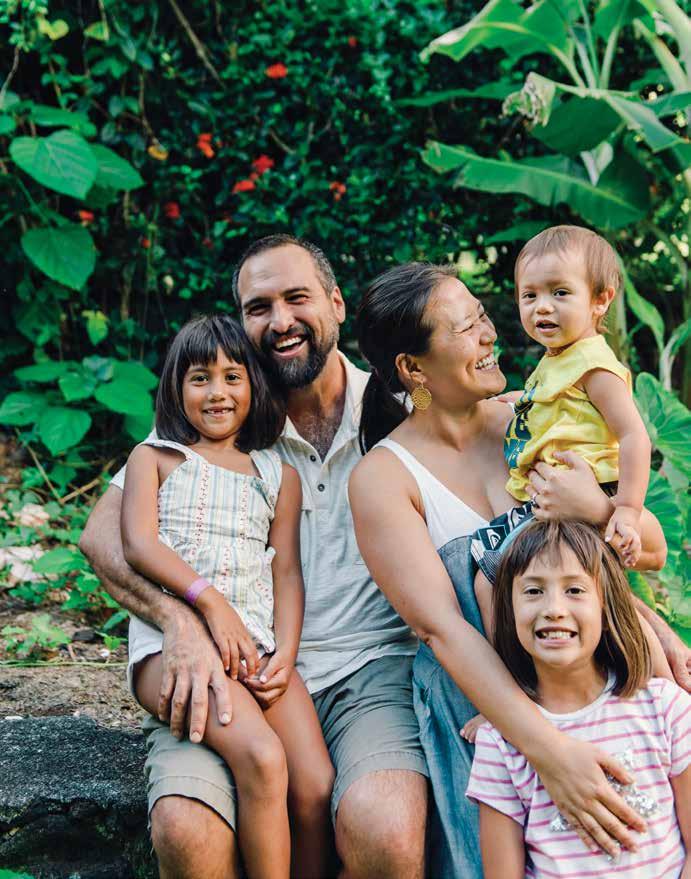
“I think to change things on the consciousness level, we need to get somewhere mystical,” says Solomon Enos, whose recent body of work is inspired by his Native Hawaiian heritage as well as the science fiction of his generation.
What’s more sci-fi than Hawai‘i? The earth created anew from the depths; an imprisoned queen deposed by a violent oligarchy that derived power from afar; a language nearly lost; night marchers; night rainbows; the most technologically advanced military scattered across an improbable archipelago; multicultural dystopian inequality; and from the highest peak, the last place on the planet where we can truly see the stars.
One hundred twenty-one years ago, Hawai‘i was a sovereign nation. Community discussions during the last year indicate that it may one day regain that status. This process will only succeed if it incorporates the complex legal and cultural arguments crafted by the most progressive minds in the Pacific, and maybe, the fantastical images of Pacific art. Considering the history of Hawaiian leadership, this process will be peaceful despite great contention and will acknowledge the transience of our moment in time and space.
The current political system warrants the metaphors of science fiction. What would happen if an endogenous political system was developed in a lush tropical environment, overthrown by the hegemony of military and industry, and reestablished over a century later? We are about to participate in a great adventure. We are about to experience the awe and mystery that reaches from the inner mind to—the outer limits.
THE EMPIRE STRIKES
The events of the 1970s in Hawai‘i, now collectively referred to as the Hawaiian Renaissance, are still vividly remembered. When the U.S. Department of the Interior held informal listening sessions throughout the islands in the summer of 2014 to hear, among other things, what the community thought of federal recognition for a Native Hawaiian government, most testifiers set their phasers to kill. The hearings were, by many accounts, a wreck. The overwhelming majority of testifiers, most of whom were Native Hawaiian, voiced a deep sense of distrust of the federal government. And no wonder: The community is overrepresented in homeless populations, the criminal justice system, and negative health indicators, the imbalanced socio-economic conditions common to indigenous communities around the world. The Department of the Interior has since held hearings with Native Hawaiians throughout the continental United States. The response has been the same: ‘A‘ole, no, to federal recognition. There are valid reasons to advocate for federal recognition, all of which have been argued to death since the introduction of the Akaka bill 15 years ago. The current protections afforded to Native Hawaiians in housing, health care, education, employment, and culture through the Office of Hawaiian Affairs, the Department of Hawaiian Homelands, Kamehameha Schools, and other smaller organizations have been under constant attack from lawsuits based on state and federal equalprotection laws. Federal recognition would both preserve state-funded institutions providing support to Hawaiians and extinguish claims of nationhood. For most who have testified, it isn’t worth it.
An op-ed co-written by Ilima Long, Jon Osorio, and Andre Perez in the Honolulu Star-Advertiser titled “It’s an international rights issue, so U.S. must step back” sums up many of the arguments: “These actions violated our rightful existence under international law in the 1890s, and now violate our collective right of self-determination and individual human rights,” the activists wrote. “The Department of the Interior and the State of Hawai‘i should not
attempt to influence or interfere with the nation-building that has been ongoing among kanaka for the past 30 years.” In advocating for a sovereignty movement that is peaceful, they requested simply that the federal and state governments do not interfere with a process that grows at its own pace and according to its own ideals. “We do not want just any governing body,” they concluded. “We want the restoration of our independent government and we deserve nothing less than that.” What this governing body might look like once the process is completed is as yet unknown, but sci-fi helps reimagine the past, as well as the future.
THE FORCE IS WITH YOU
That speculative fiction has real relevance to our discussion of subjective politics should come as no surprise. Author Junot Diaz has been extolling the merit of genre narratives in the wake of his 2007 Pulitzer Prize-winning novel, The Brief Wondrous Life of Oscar Wao, which follows the tribulations of a sci-fi-loving Dominican nerd in New Jersey and Santo Domingo. “Without our stories, without the true nature and reality of who we are as People of Color, nothing about fanboy or fangirl culture would make sense,” he says in a podcast in 2013. “What I mean by that is, if it wasn’t for race, X-Men doesn’t make sense. … If it wasn’t for the history of colonialism and imperialism, Star Wars doesn’t make sense. If it wasn’t for the extermination of so many Indigenous First Nations, most of what we call science fiction’s contact stories doesn’t make sense. Without us as the secret sauce, none of this works, and it is about time that we understood that we are the force that holds the Star Wars universe together.”
The possibility of alternate universes makes absolute sense to some in the sovereignty discussion. In Hawai‘i’s small contemporary art circles, Solomon Enos is something of a celebrity. He works as fast as he speaks and has been known to sketch complex murals with a brush on a stick in minutes. Though much art in Hawai‘i is sold in galleries aimed at the visitor market, Enos is one of a handful of local painters making a living as an indigenous artist without pandering to outsiders’
FLUXHAWAII.COM | 39
concepts of native culture. But Enos’ work also sells in tourist markets: His paintings line the halls of Aulani, the Disney resort, and several Waikīkī hotels. He has illustrated books, prints, and paintings for businesses and community groups. “I’ve loved Frank Herbert, Ursula K. Le Guin, Kurt Vonnegut for years now,” Enos says of his inspiration. “They created worlds, what-if narratives.” Having grown up with both the mo‘olelo of his grandmother and the science fiction of his generation, his paintings can be as beautifully grotesque as H.R. Giger’s (who inspired, among other things, the noir look of Aliens) or as eerily romantic as Alan Lee’s Lord of the Rings illustrations. “I figure by looking back at our narratives, there’s a lot of my, and our, reality that depends on the same sort of what-ifs. I’d say this is a sort of activist escapism. When I put the book down, I can engage with the world in a better way.”
Over the last two decades, Enos’ most ardent passion has been Polyfantastica , a science fiction-inspired narrative that spans 40,000 years of Hawaiian history. He has completed nearly 400 images representing centennial vignettes, which are the prospective book covers for a narrative that reaches far into the future. “At that point, good guys and bad guys become moot,” he says. “We’re in the process of uploading it all online to make the narrative accessible and workable by anyone with a computer. It’s been a garage project, but we’re getting to a critical mass now.” Enos’ hope is that other Pacific sci-fi buffs will assist in the project and fill in the narratives he has begun to illustrate—an activist fan-verse, a Polynesian sort of Dungeons and Dragons
Enos lets his what-if scenarios play out with his recent Human Seed Ships series. In dozens of paintings, he imagines a Hawai‘i where Polynesians never encountered Captain Cook in 1776 and the archipelago goes undiscovered by the rest of the world until a global apocalypse. When ships do wash up in Hawai‘i, they are filled with the corpses of environmental refugees and hyper-modern technology. “Then these Hawaiians are affected not by disease, but by fear, the things we’d have to flush out of our system if we were contacted or not,” he explains. The resulting paintings are fascinating. With
Enos’ skill as a draughtsman and painter, they are Salvador Dalí-level trips that draw from the Polynesian-centric world to create a pantheon of characters. “What does nationalism mean in the future? What about sovereignty? I’m trying to be as long-viewed as possible. I think to change things on the consciousness level, we need to get somewhere mystical. We knew we could navigate to islands because we knew they were there. Now we have to navigate through the current future. It’s not American or Eurocentric. As much as I love Lord of the Rings, I realize we need our own way of telling things. One-third of the world is the Pacific Ocean. It’s time we hatched our avatars, our origins, our crazy.”
A NEW HOPE
“The sovereignty discussion of the last year has been as spirited as it’s been in decades,” professor Kamanamaikalani Beamer tells me at his office in University of Hawai‘i at Mānoa’s Hawaiian Studies building, “but I’ve never been as optimistic.” Beamer’s new book, No Mākou ka Mana: Liberating the Nation, discusses the intelligent and creative ways in which the ruling ali‘i of the Hawaiian Kingdom engaged with aggressive foreign powers, blending Hawaiian governance with ideas from the West. It also diligently explores ways in which natives were at times complicit in 19th-century imperialist agendas.
“No Mākou ka Mana is not concerned with what missionaries or foreigners did for or to Oiwi (natives), but rather what Oiwi did for themselves, in the midst of depopulation and constant threats of colonialism,” he writes in the introduction. “I believe that living cultures are dynamic and always in a state of change. I believe the dichotomies of the traditional and modern, with all their connotations, are false. They compose the conceptual shackles that preserve European hegemony and often reinscribe links between the colonizer and the colonized, occupier and occupied.” Many of the people Beamer researched were non-Hawaiian patriots for the Hawaiian Kingdom. Though imported labor and capitalism played a role in racial and economic stratification, the citizens of the kingdom were enfranchised people with
universal suffrage, all races cooperating in government—so thoroughly different from the governments of that era.
In lieu of a deep textual analysis of a little-known anti-annexation letter signed by Queen Lili‘uokalani, which she addressed to the British government, Beamer presents it in its original form. “It’s a gorgeous letter, isn’t it?” he says with wonder. “Probably not written in her hand, but it’s clearly her thoughts. Something like that, it’s best to just present it directly,” he says.
The letter articulates what residents of this archipelago, Hawaiian and nonHawaiian alike, have accepted as an inconvenient history. This is now taken as fact: The kingdom resisted takeover using peaceful, diplomatic means; the United States did not execute a valid treaty of cession or annexation, as was required in 1898 for an annexation to be valid under international law. Beamer spares no criticism of the provisional government that took over the kingdom in a series of events that, by modern analysis, was a takeover supported by the American military—the men who formed a Republic as megalomaniacal grabbers of empire.
The takeover was as much cultural as it was political. The way Beamer describes it, annexation was akin to a Star Trek temporal disruptor bomb, the kind that warps the space-time continuum, destroying past, present, future, everything. After annexation, Native Hawaiians experienced the taking of land by non-native peoples under quasilegal arrangements supported by racism and xenophobia, resulting in a collective downward social mobility in their own homeland. But throughout this experience, the record kept in Hawaiian was tight, like a time capsule that has taken a century to open, and academics in Hawai‘i and throughout the nation have been accessing decades of communal dialogue. The translations are chilling in their prescience and erudite analysis of global political events. “It wasn’t until I was fluent [in Hawaiian] that I could get it,” says Beamer, pointing to a Honolulu newspaper clipping from the 1890s taped to his office door that discusses the annexation. “‘News from America’ is what this part translates to. Their readership realized that America was a foreign place. It’s part of why I structured this mo‘olelo this
40 | FLUXHAWAII.COM
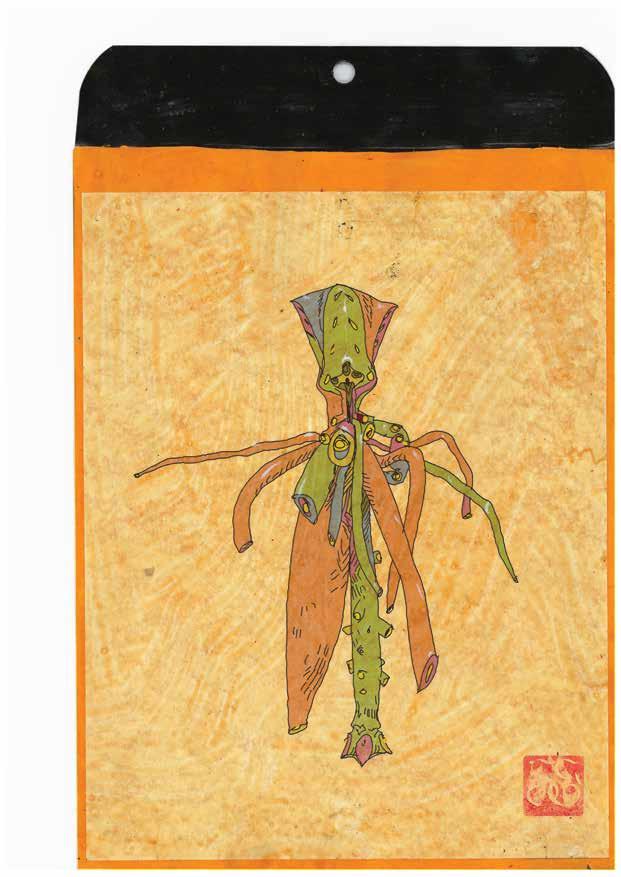
“Year 31,009, A Smell-Thought Class Human Seed Ship in transit to the Huāpajitu Nebula via Dream-Space,” 2014, Solomon Enos. Acrylic and digital.

“How do I, as a native person, work with the tools around me? I’m a family man and come from entertainers, farmers, activists. But here I am using an iPad in air conditioning,” says
Kamanamaikalani Beamer, whose new book No Mākou ka Mana is out now.
By refusing to see Hawaiian leaders merely as passive victims, Beamer comes to grips with the need for modernity, for future-thinking, and for mediating value systems in an inhospitable universe.
way: to tell the story of Hawaiians doing things their way, in their own voices.”
By relying on the narrative of history, Beamer eschews the patchy inadequacy of American jurisprudence to highlight substantive equality and effectuate justice. The sovereignty conversation has painfully moved past America’s problematic, possibly intractable, issues with race. The equal protections afforded by the state and American constitutions, for which a civil war was fought and countless Americans marched in the streets decades ago, have proven inappropriate tools to remedy a problem rooted in political history. The movement that was the impetus for the civil rights era, community organizing directed at specific empowered targets, and the critical legal scholarship that developed as a result over the last several decades—these are indeed helpful. This organizing influenced the world: from the Māori land march of 1975 to South African apartheid resistance to the environmental and sovereignty movements in Hawai‘i.
“We haven’t yet contextualized Hawai‘i in terms of pacifist struggles around the world, but that’s exactly what this was. This was one of the first non-colonized, non-European modern nations in history. And it’s a story about myself as well,” notes Beamer. “How do I, as a native person
navigating this space, work with the tools around me? I’m a family man and come from entertainers, farmers, activists. But here I am using an iPad in air conditioning.”
Beamer and his colleagues have used technology to both archive and research original documents, many of which are in ‘Ōlelo Hawai‘i. By referring directly to native voices, No Mākou ka Mana adds to the literature written in the intervening decades since occupation, the basis of which reconstruct a historical framework. By fully articulating the rich legal, cultural, and social history of the nation of Hawai‘i prior to overthrow, the academic work of Haunani-Kay Trask, Jon Osorio, Noenoe Silva, and dozens of others become the foundation upon which to rebuild a nation. By refusing to see Hawaiian leaders merely as passive victims, Beamer comes to grips with the need for modernity, for future-thinking, and for mediating value systems in an inhospitable universe.
The community of social-justice nerds agree. A course titled “Political Science Fiction” at UH Mānoa uses the Star Trek universe to discuss the fluidity of identity and political systems. Bryan Kamaoli Kuwada, an English-department PhD candidate who concentrates on Hawaiian translation, recently published “Of No Real Account,” a fantasy adventure story featuring Hawaiian mythology, in the
literary journal Hawai‘i Review. “Sci-fi’s a way to get past the whole crabs in a bucket, pulling each other down while trying to get out metaphor,” he says at a Hawaiian sovereignty event over the summer. “That’s old. We need new stories. Plus this kind of writing is actually fun.”
Though fictional, Enos’ paintings and Kuwada’s stories speak to the trepidation some feel about the future of a Hawaiian state and its relationship with America. No one is sure how this will work out. But the arts community has answers that are at least more interesting than temporal politics, with creative ideas about the worlds we should inhabit rather than the dismal one we do. With so much of our modern lives regarding communication and technology predicted decades ago by science fiction, it is possible, necessary even, to apply the same utopian fantasy to political systems.
Nerds know how the story ends: Not without struggle, the destructive, inequitable rulers are defeated. Peace and order eventually reign throughout the galaxy. Our heroes are explorers who embark on intrepid missions of peace. Optimistic adventure takes precedent over conquest, as do exploring new worlds, seeking out new life and new civilizations, going where no one has gone before.
FLUXHAWAII.COM | 43
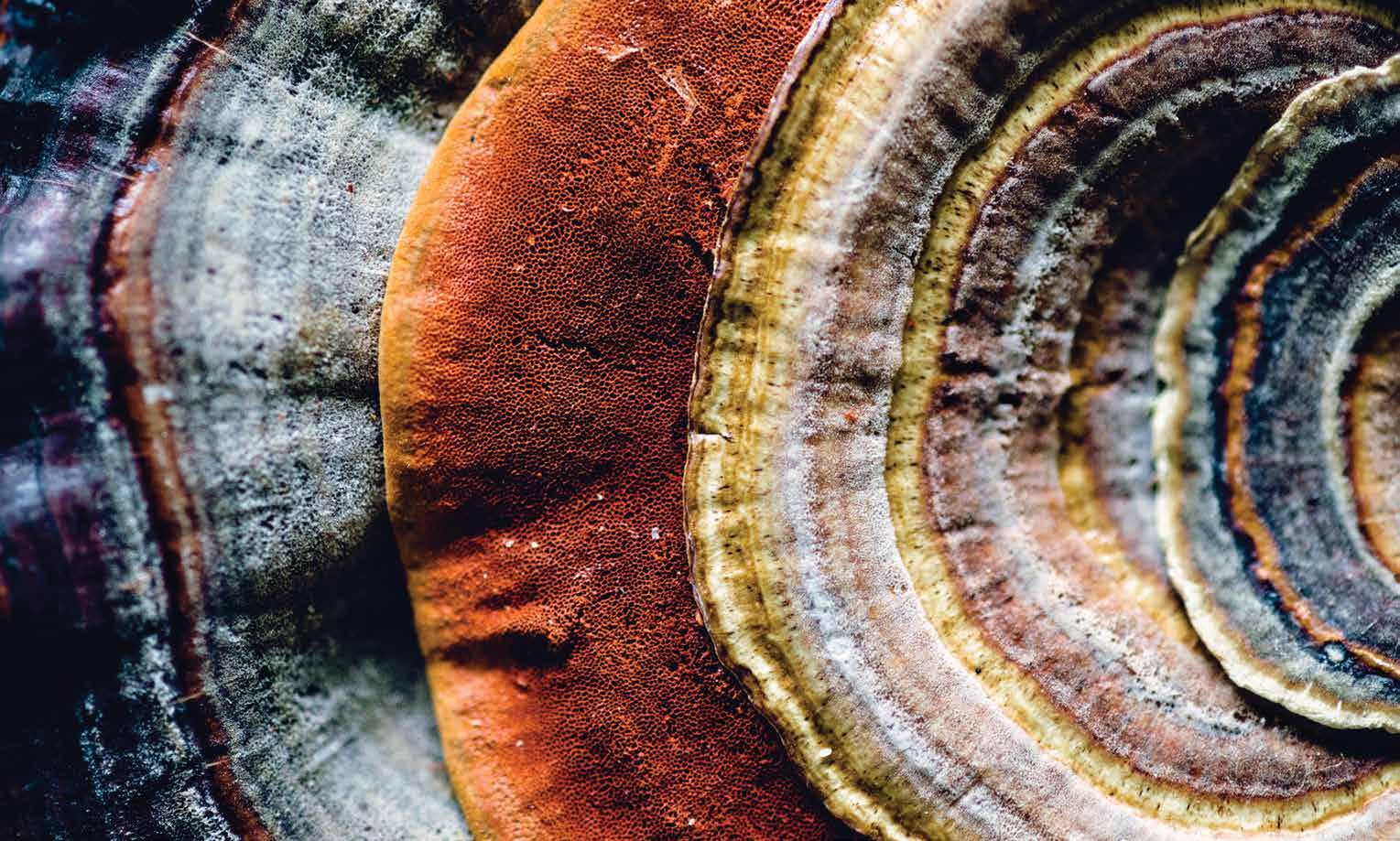
A GOLDEN LINEAGE
CREATORS SATORU ABE AND ALMA MCGOLDRICK HELPED SHAPE THE LANDSCAPE OF VISUAL ARTS IN HAWAI‘I IN THE 1970S. TODAY, THEY REMAIN DEVOTED TO MAKING MORE, MAKING BETTER, MAKING OF AND FOR HAWAI‘I.
44 | FLUXHAWAII.COM

FLUXHAWAII.COM | 45
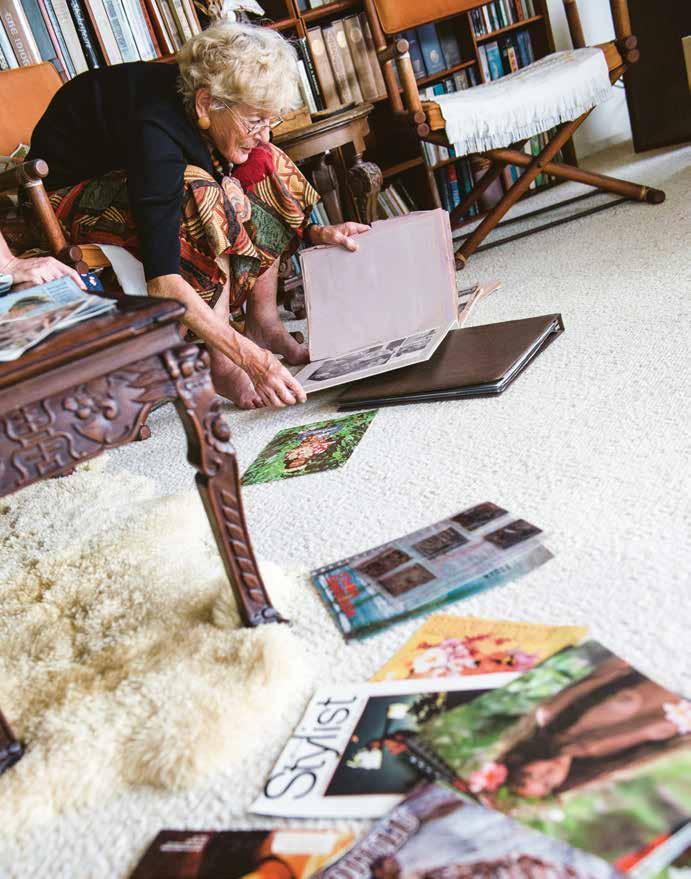
“I’ve always enjoyed working with natural materials. Nature, above anything else, is my greatest love,” says Alma McGoldrick, whose enduring images shaped the way people viewed fashion in the islands.
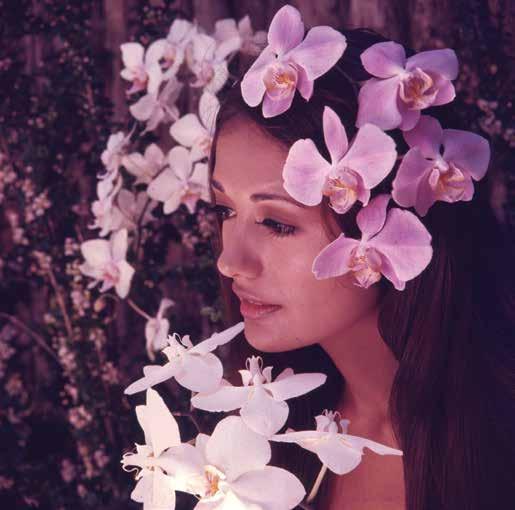
PORTRAIT OF A LADY
AFTERNOON TEATIME WITH LEGENDARY
CAMERAWOMAN ALMA MCGOLDRICK
FLUXHAWAII.COM | 47
TEXT BY KELLI GRATZ | IMAGES BY JOHN HOOK
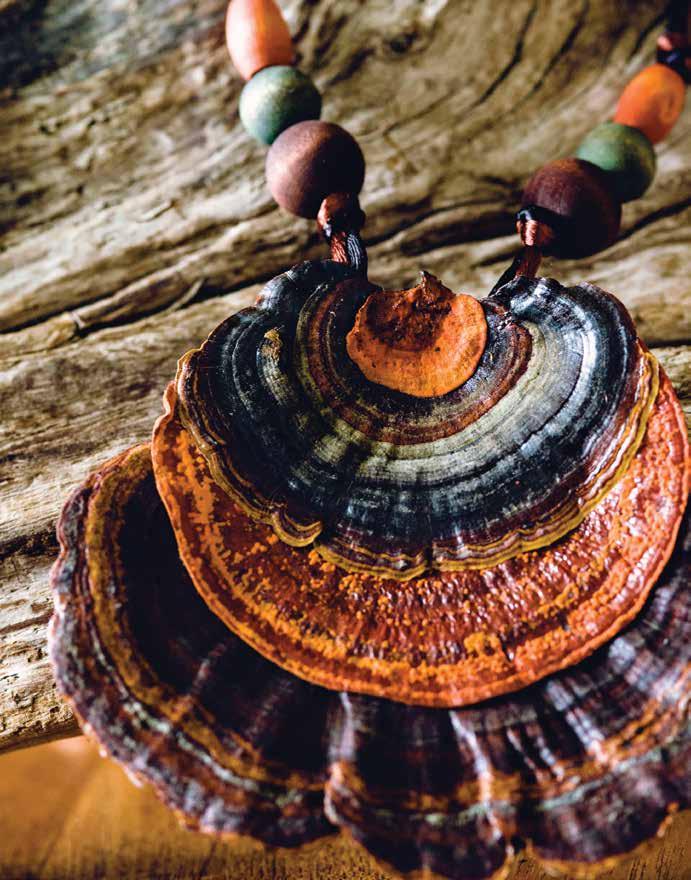 Even in her mid-80s, Alma McGoldrick still hikes to collect the fungus for her exquisite hand-made jewelry.
Even in her mid-80s, Alma McGoldrick still hikes to collect the fungus for her exquisite hand-made jewelry.
“Would you like some sugar?” Alma McGoldrick says in typical British fashion: in the middle of a sentence, over a pitcher of tea. She muddles fresh mint just picked from the balcony of her home in Kailua, where she has lived for the past 30 years, and mixes it into the brew. Good books and interesting small antiquities crowd the walls and shelves, and binders filled with aged snippets of a young, blond Englishwoman gripping a flashgun and Rolleiflex cover the tabletop as afternoon tea commences. “I have about an hour to spare before my Bocce ball practice,” she says. “For years, it’s been hard to get a good team together because everyone either moves away or dies on me,” she says with a laugh. “But now we finally have one, so it makes it competitive.”
Her strong British accent and racy argot are easily explained by her upbringing in Surrey County, England. Her dress, however, can be likened to her travels: loose-fitting harem pants from the Arabian Peninsula and a black top made in Southeast Asia, complemented by a gorgeous, hand-made fungus necklace from her jewelry line Tree Shells, which is what she calls the fungi she sources from the Hawai‘i rainforests. “I’ve always enjoyed working with natural materials,” says McGoldrick. “Nature, above anything else, is my greatest love.”
Naturally then, her stories extend far beyond the shores of Kailua beach to the banks of the Middle East and Europe, where she worked as a staff photographer for the Women’s Sunday Mirror, a subsidiary of the London Daily Mirror. “The year was 1955, and it was the most exciting time of my life,” she recalls. “I got all the fun jobs—photographing Salvador Dalí, Prince Aly Khan, Arlene Dahl, Gina Lollobrigida. I covered a sheikh’s marriage to his fourth wife and a pre-Lenten festival in Cologne. I even went to a nudist island off of Germany.”
Before this, McGoldrick worked as an elementary school teacher with a penchant
for natural beauty. “I hated teaching!” she says with a gasp. “I knew it wasn’t for me, but everyone kept telling me to stick it out, so I did the two years to get the certification and then quit right then and there.” She enrolled at the Guildford School of Photography and did freelance work before she went to the Mirror. Two years later, in 1957, she came to Hawai‘i on the arm of her first husband, Joseph McGoldrick, whom she had met when he was head of U.S. Navy intelligence in Europe. “I fell in love with the rich and ethnic differences it offered. My favorite location was Sandy Beach. Models’ hair would go flying up in the air, and there was a nice light that bounced up from the water’s edge.”
As McGoldrick’s photography career grew, changes in consumerism and new feminine ideals were causing major shifts in fashion photography. The elegant, submissive prude gave way to the single girl who loved adventure. And right at the forefront of this revolution was the grande dame herself. “For quite a long time, I did pin-ups,” she says of the bikini-clad women she photographed. “I would take them to Pacific Business News, and the editor took what he liked. Then the women’s libbers got to them, and they stopped running them. I remember an article that was written about me saying, ‘What does this woman do every morning to excite businessmen in Hawai‘i?’”
Her photography career waned in her 50s when her focus shifted from capturing images to raising her two children, traveling, and jewelry design, an interest that had been piqued during a photo session years before. “My friend had given me macramé necklaces for a shoot I did, and my daughter saw them and loved them,” she says. “At the time, I didn’t have any macramé, but I had some extra fungus from a collage I did so we used that instead.”
Now in her mid-80s, McGoldrick is determined to keep doing what she’s always done: snorkeling (at least) twice a week, trespassing through private property to get
“just the right color of fungi” needed to fulfill orders from Martin and MacArthur, and perfecting her savasana and downwarddog poses. “I don’t shoot anymore, except for my photo club,” she says. “It’s quite pathetic actually, but we do try to get out there every once in a while.” While she professes that navigating through the murky waters of old age can be tiresome (severe vision loss in one eye, a fractured vertebrae, and peripheral neuropathy), the rambunctious trailblazer in the trenches of Beirut or Kathmandu still shines through.
Looking through archives of contact sheets, cover shots, and one-pagers of gorgeous models posing in alohawear by Tori Richards, Malia, and Nali‘i, you can’t help but wax nostalgic for the Hawai‘i of then. From the folds, she pulls out an old Honolulu Magazine cover featuring a young model, topless but for an array of colorful flowers. A faint smile brightens her face. “My favorite portrait has to be this one,” she says. “It took forever to get the flowers to stay put in the right places.” She looks at the image, hands it to me, than moves on to the next. Her energetic conversation tells of a successful life, a life far from over. For McGoldrick, nature continues to fuel her fire, extending outward to the tips of her fingers, energizing whatever she touches—be it a camera body or bracket fungi—and rendering it beautiful.
FLUXHAWAII.COM | 49

As changes in the
our website to view
including
new feminine ideal arose in the ’60s, photographer Alma McGoldrick’s images shifted from the elegant, submissive prude to the single girl who loved adventure.
Visit
more of McGoldrick’s work,
this shot she took of beads of papier maché by Baba Kea for Honolulu Magazine, as well as never-before-seen film scans.
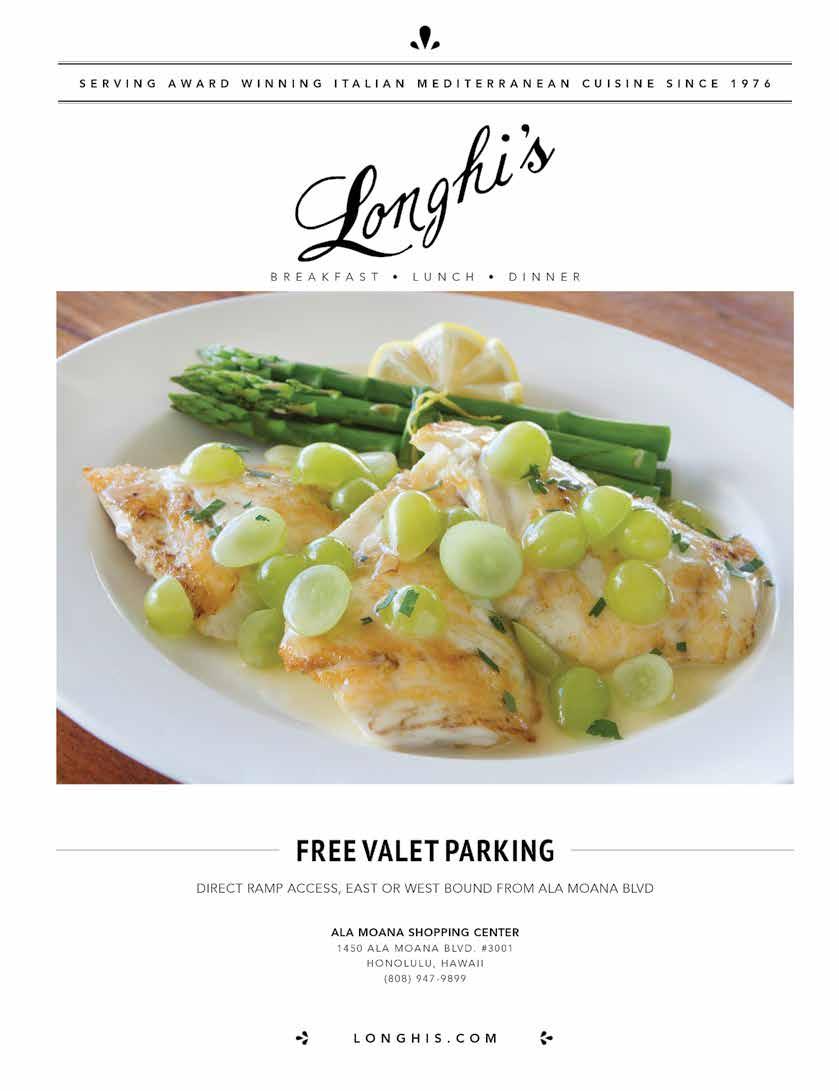
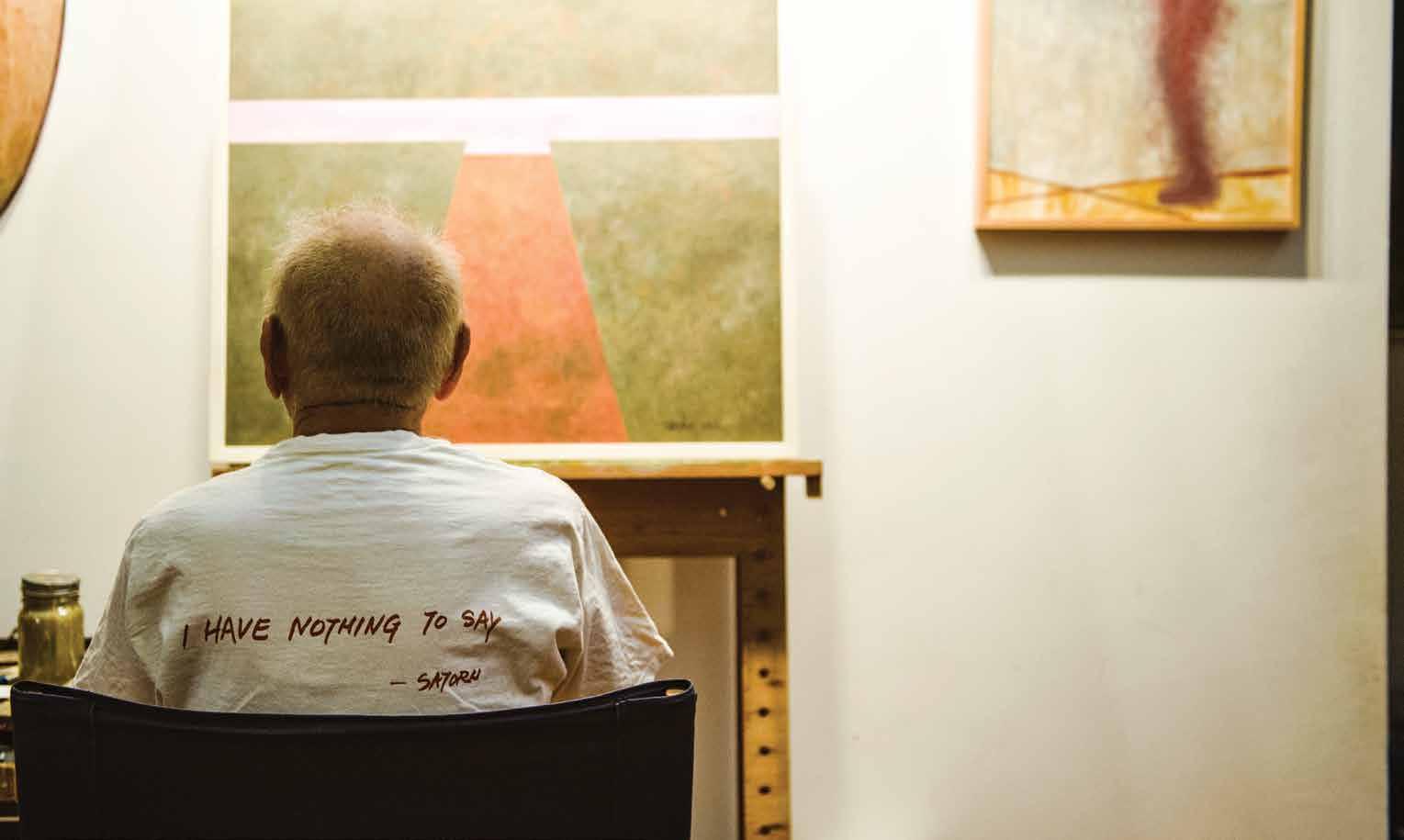
52 | FLUXHAWAII.COM

IN SEARCH OF SATORU
A REFLECTION ON THE INFLUENCE OF ONE OF HAWAI‘I’S MOST INEXHAUSTIBLE
CREATIVE FORCES
FLUXHAWAII.COM | 53
TEXT BY LISA YAMADA | IMAGES BY JOHN HOOK
“There’s a number 10 thread that goes through art history, a thin line that goes from one generation
to the other—like Rembrandt, Picasso, all different works of art. I always wanted to be part of that and strive for it.
Does the world put Satoru into
that?
We don’t know yet, because time is the judge.”
—Harry Tsuchidana
On a warm Saturday morning, a steady stream of people trickles in and out of Satoru’s Art Gallery, a plain two-story walk-up behind Old Stadium Park in Mo‘ili‘ili. News of the gallery’s imminent closure after nearly a decade has gotten around, and patrons, friends, and family have come to pay their respects to the beloved artist, browse the immense collection of his sculptures and paintings, and of course, purchase.
The gallery’s namesake, Satoru Abe, pauses to take a picture with a woman. In front of them stands a wooden sculpture about two feet high with bronze petals flowering from the top; beneath it, the $20,000 price tag has been covered with a red dot. After a cursory glance around the gallery, I count five more red dots below similar pieces less than an hour into the opening. “Who do I make the check out to?” asks a man dressed in slippers and shorts. When I first asked Satoru for an interview on his influence as one of Hawai‘i’s most prolific artists, he humbly declined. “No, no, I talked too much already,” he says. And he has talked plenty. Google “Satoru Abe” and his life is in plain view: how he grew up in Honolulu
as a Japanese American; how he, at the age of 22, “saw the light” while working as an assistant pasteurizer at Dairyman’s (now Meadow Gold); how he struggled as an artist to make ends meet in New York and met the love of his life, Ruth, while they attended Arts Students League; how he, upon his move back to Hawai‘i in 1950, rose to acclaim with the Metcalf Chateau, his gang of local boys that included Tadashi Sato, Bumpei Akaji, Bob Ochikubo, Jerry Okimoto, Edmund Chung, and James Park, all of whom have since passed but were pivotal in introducing abstract expressionism (the playfully rebellious form that arose in New York City after WWII) to Hawai‘i; how he honed his artistic ability at New York’s Sculpture Center and returned to Hawai‘i in the ’70s; and how he, over the next four decades, would become one of Hawai‘i’s most beloved—and most commissioned— artists of all time, passionately devoted to his work and to the work of others.
And since a man cannot be all things to all people, I talked to four of those who know Satoru best about the influence of Hawai‘i’s most renowned of artists. Slowly, an impression began to emerge.
SATORU: THE FRIEND
“His work, it’s like a multiple orgasm,” 82-year-old painter Harry Tsuchidana tells me. “Because he get lot of things going on in it. Mine, I have one orgasm; after that you smoke.”
For those who know Tsuchidana, conversations like this are typical. In the 180 minutes I spend at his home studio in Salt Lake, our talk runs the gamut of hysterical to obscene. We talk about astrological signs and how they’re excellent conversation starters; how he learned to draw by tracing comic books and that he’s older than Batman by seven years but younger than Superman by ten; and how the work that will stand out most after Satoru has passed will be cock. “Chicken?” I ask sincerely. “No, penis!” he says with a high-pitched snicker. I can’t tell if he’s joking or not. Then he says, quite seriously, “When one dies, people gonna focus on some work that was so different from the
rest and that was it. … A lot of his work has innuendos. Try look. To me, he’s a voyeur. Of course,” he says, reflecting, “I’m reading into it.”
Tsuchidana first encountered Satoru by happenstance on his first day living in New York. “‘You guys was rejected’— that was my opening line to them,” says Tsuchidana, who remembered Satoru’s and sculptor Jerry Okimoto’s names after they had applied for Corcoran Gallery of Art’s biennial exhibition in Washington, D.C., where Tsuchidana had been working as a janitor. “I never did meet them before; I just saw them and felt intuitively that these were the guys—what’s the chance, yeah?” Just as Satoru and Okimoto were about to walk away from the young hassler, Tsuchidana called out, in true local fashion, “‘I know Sugar’—that’s Tadashi Sato—so they came back and said, ‘Oh Sugar, he’s at 109th Street,’” where all the artists were living at the time.
Tsuchidana was the youngest of the bunch. By the time he got to New York to pursue art in 1956, the boys from the Metcalf Chateau were already securing their spots in the art world. Satoru worked tirelessly on the third floor of Dorothea Denslow’s Sculpture Center while gaining prominence through group shows around the city (including a sculpture exhibition at the Museum of Modern Art); in 1963, he was awarded a prestigious Guggenheim Fellowship.
Roving New York with Satoru and the others, Tsuchidana was privy to some of the city’s finest galas, like the opening of the Guggenheim in 1959, and to meeting celebrity collectors like Burgess Meredith, who came to Tadashi Sato’s apartment to look at art. Mostly, though, the lives of the artists comprised of playing cards, drinking from time to time, and talking about anything other than art. “You remember Willie Mays, the baseball player?”
Tsuchidana says. “[Satoru] was so intrigued by him.” “Why?” I ask. “Well, because he was the best.” This support system for a bunch of Asian guys from Hawai‘i proved essential for their growth as artists in a place that occasionally alienated them. Periodic bouts of prejudice were combated by potluck dinners with the gang.
54 | FLUXHAWAII.COM
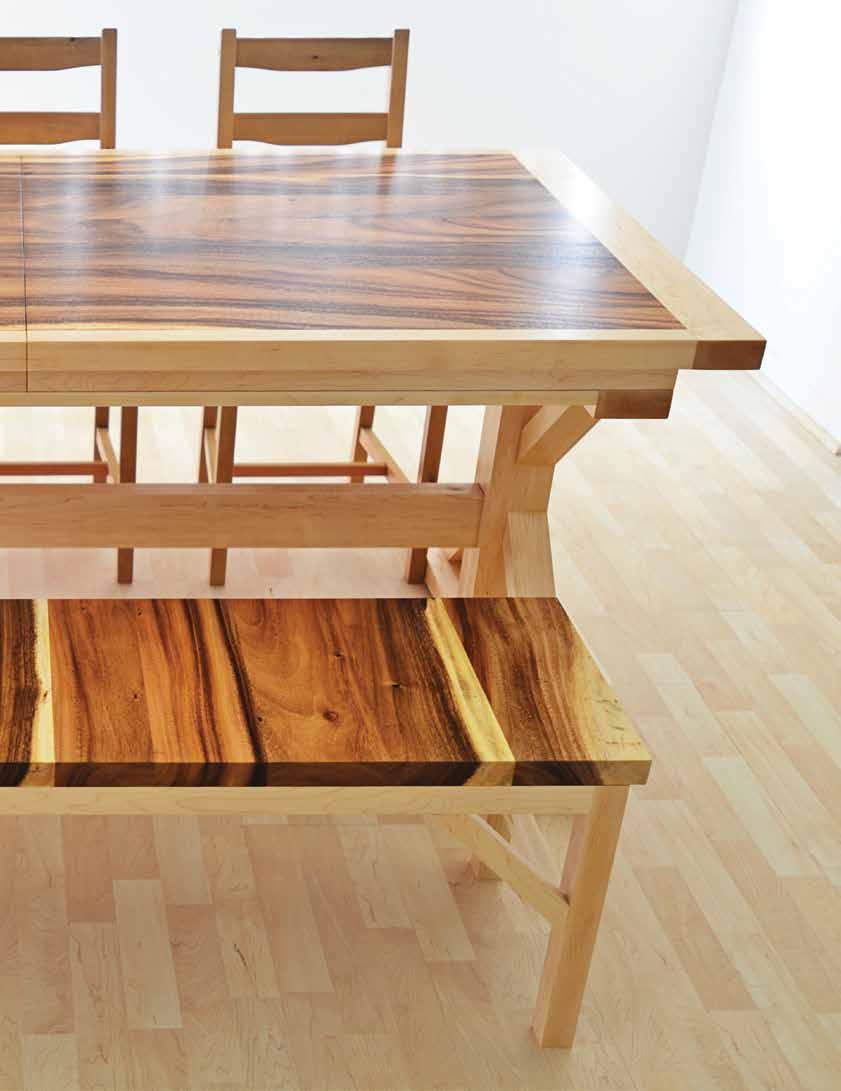

for inquiries: 808.728.6143 dson808@gmail.com @dson_woodinc Wood, Inc. custom handcrafted furniture by DAE W. SON woodinchi.com
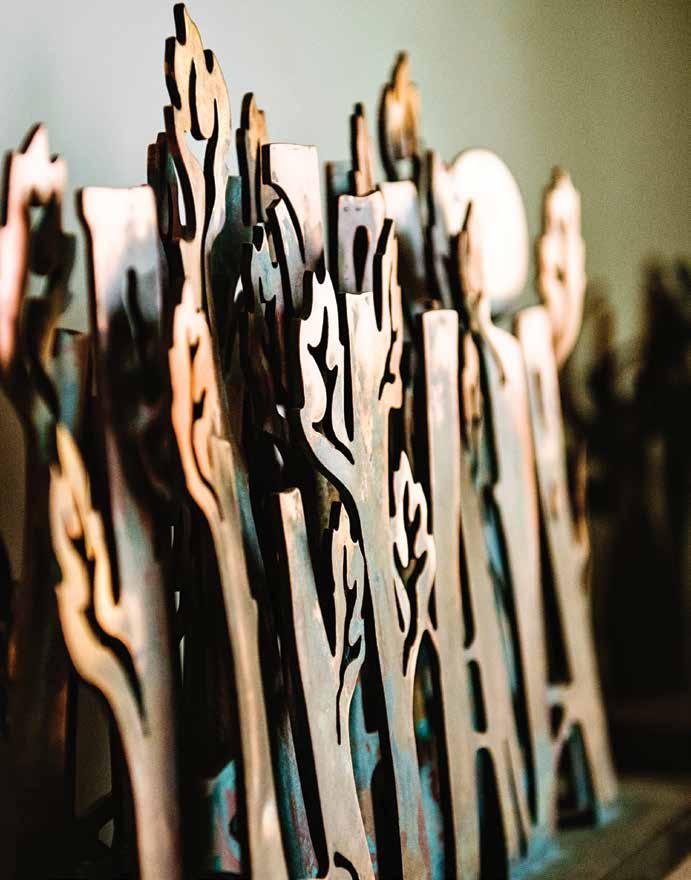
“All of his art is about growth, the things around us like the moon, the trees, the roots,” says Abe’s only daughter Gail Goto, who has shared her father’s
home since 1988.
Kaimukī


Even in their 80s, Harry Tsuchidana and Satoru Abe are still creating new works every day. “I always believe that if you create continuously, you evolve,” says Tsuchidana, shown
in his Salt Lake studio.
Tsuchidana moved back to Hawai‘i in 1959 after receiving the John Hay Whitney fellowship, which granted him $2,500 (roughly $20,000 today) to further his studies in art. By this time, his paintings had evolved from abstract figures to studies in balance inspired by “Mondrian’s horizontal line,” a style he continues today. When Satoru returned to Hawai‘i in 1970, he was a well-established artist. “It was a perfect time for him, just ripe for him to have commissions,” says Tsuchidana, referring to the establishment of the State Foundation on Culture and the Arts and its Art in Public Places program, which dedicated 1 percent of construction costs for new state buildings to the arts. Because of this, Satoru’s sculptures grace many of the state’s most prominent buildings, including Honolulu International Airport, Aloha Stadium, and dozens of public schools and colleges.
Decades later, Satoru and Tsuchidana are still creating work every day; Satoru, grinding and soldering in his garage in Kaimukī; Tsuchidana, up at 3 a.m. to draw and paint at his apartment in Salt Lake, where dozens of large canvases fill one room and what must be tens of thousands of drawings neatly stored in plastic bins and Longs plastic bags fill another. “I always believe that if you create continuously, you evolve. Bumpei Akaji once said to me that I’m producing too much, but I don’t feel that way. The fact that I draw every day—I’m all greased up.” He and Satoru both.
SATORU: THE FATHER
“The bridge column, National Geographic, the Smithsonian—he always reads that cover to cover,” Gail Goto, Satoru’s only daughter, tells me from the kitchen of the Kaimukī home she has shared with her father since 1988. “J-dramas—we always watch our J-dramas together.” Around us is evidence of a life spent in support of other artists. Satoru’s work, which overflows from bookshelves and bathroom closets, sits alongside pieces he’s bought from friends (an enormous wood vase by Jerry Okimoto, small ceramic pots by Toshiko Takaezu) and aspiring artists (a portrait of Satoru painted
by Kamea Hadar, a trail of ants on canvas by Otto) alike, filling just about every spare space of their home.
Since Satoru was forced to forfeit his driver’s license the previous week, on his 88th birthday, Goto has become the unofficial chauffeur for her dad’s busy schedule, taking him to an art opening at Kapi‘olani Community College’s Koa Gallery, yoga on Thursdays, art drop-offs around town. The relationship between father and daughter has strengthened over the years; Goto remembers growing up as the only child of an artist father, which was like anyone with a parent preoccupied with an all-consuming job would. Even when he wrote letters to his daughter while she was in architecture school, he would sign it, “Satoru.” “I guess he didn’t know his place in my life then. It was just ‘Satoru,’ not ‘Dad.’ … You feel a little shortchanged when you’re younger, but as you get older, you realize that’s why he’s good at what he does, because he devoted all of his effort into doing what makes him what he is.” What he is, Goto realizes now, is kind. “He always thinks about other people. And sometimes that, in my viewpoint, shortchanges him, but from his standpoint, he doesn’t feel like he’s being disadvantaged. He used to tell me, ‘Gail, in life, it’s better to be taken advantage of than to take advantage of people.’”
Her father’s kindness was in no shortage when it came to Ruth, the love of Satoru’s life. The budding romance began while they were attending Art Students League in 1948, and despite being an artist herself, “everything my mom did was in support of my dad,” says Goto. They moved back and forth between New York and Hawai‘i before eventually settling down in a Quonset hut in Mākaha after Satoru received a grant from the Hawai‘i State Foundation on Culture and the Arts in 1970. “My mom said those were the best years of her life,” Goto recalls. “Large acreage, farming, and the outdoors— my mom loved going to Pokai Bay and swimming.” But not soon after they moved, Ruth suffered an aneurysm, then a stroke, and the other debilitating effects that come with trauma to the brain. Now, it was Satoru’s turn to support his wife, which he would do for the next 13 years. “It was
really hard on my dad because he was the one solely taking care of her,” says Goto. “I think he really missed her when she got ill and passed on.”
As we talk, Satoru is busy in the garage, working on his latest commission for a residential tower in Kaka‘ako. “All of his art is about growth, the things around us like the moon, the trees, the roots,” says Goto of what she refers to as “additive art.” “It’s about the addition of stuff, reusing and fashioning the drop-offs—what he calls the cutouts—into new sculptures. … What he has is something that we all want to be and do, and that’s to be better.”
SATORU: THE SUBJECT
“The piece that Satoru has in his yard,” John Morita begins, referring to a large bronze sculpture originally meant for a Hiroshima memorial. “That is …” he trails off before nodding his head solemnly and giving a thumbs-up. “It’s got all the elements: sophistication, size, significance, all intertwined—friendship,” he says of what he calls one of Satoru’s few political pieces, a departure from his mostly noncontroversial subject matter.
Morita, who studied photography and printmaking in San Francisco, knows a thing or two about political art. He spent years documenting the First Palestinian Intifada, an uprising against Israeli occupation in the region, in the 1980s. Mainly though, art to him is about telling a story, a notion he has remained fervently dedicated to regardless of the medium or message. One of his ongoing projects is documenting an artist family in San Francisco—for more than 40 years.
Morita’s fascination with Satoru’s story began in 2008 after he attended a gallery opening Satoru arranged for his friend, the late Jerry Okimoto. He became curious about the kind of person who would be entrusted with the selling of 16 of Okimoto’s ceiling-high wooden sculptures, for which he took no commission. “The family thought Satoru was the only person who could sell it for them,” Morita says. And he did. “The state foundation purchased a couple, the city purchased a couple, his friends purchased a couple—I think he’s got only a few left that
FLUXHAWAII.COM | 59

SATORU: THE SELLER
SATORU: THE MAN
haven’t sold.”
Since then, Morita has spent nearly every Saturday for the past six years visiting Satoru’s gallery, capturing the comings and goings of the diverse group of people who pass through. He has trailed Satoru at art openings, award ceremonies, and his home, casually pointing a handheld camcorder in the direction of anyone who might have a provocative clip. The 106-minute rough-cut edit of a documentary is shaky at times, but the picture that emerges in Morita’s years-long slice very clearly portrays a man who cares in earnest about the success of the people around him. In the video, Satoru is seen giving a critique to a young girl’s drawings of elephants, purchasing the work of his mentor Isami Doi, going the extra mile for a friend. “I have to sand about 20 pounds more,” Satoru is seen saying as he grinds away at a 90-pound clam sculpture made by Okimoto. “Lots more grinding to do to get it finished so I can sell it for him.”
Walter Dods, the former chief executive of First Hawaiian Bank, has close to 100 Satoru Abe pieces in his personal collection. This includes one of the artist’s most iconic, which he can enjoy every day: Placed at the crossroads of commerce at the corner of King and Bishop streets, “Eternal Garden,” five large tree-like sculptures fashioned from bronze, sits in front of First Hawaiian Center, where he still has an office with a view. It’s kittycorner from a piece by Bumpei Akaji and by no accident. Across the street, in Bishop Square, is a work by English sculptor Henry Moore, while another by Bernard Rosenthal stands at the Bank of Hawaii building. “I wanted to get the local boys back in balance,” says Dods. Despite the many pieces that fill his home and office, as well as the Honolulu Museum of Art partnership gallery in the lobby of First Hawaiian Center, which he established, Dods initially had to be dragged “kicking and screaming” into the art world. “I was a Saint Louis High School grad who had no culture in my background,” says the Kuli‘ou‘ou-raised Dods. But once his friend Wesley Park forced him to take a look, he couldn’t turn his eyes away.
“The work of this group was forged under the stress and fire of the Second World War,” says Dods. “I hope other groups replace them, but it’s hard to find that. … In terms of sculpture, I’d say Satoru was one of the top three or four to come out of Hawai‘i and just a special human being.” For Dods, it’s essential that the arts continue to be supported. “Art and culture is the soul of a community. … You have your social problems—housing and homeless are critical issues—but I don’t see them as mutually exclusive [with art]. … Hawai‘i lacks a vibrant arts and culture community, but what we do have is special, and we need to nurture it.”
Two weeks after Satoru initially declined my interview request, he’s finally ready to talk. “The birth certificate says that I was born 88 years ago, but for me, life started 66 years ago, in 1948, when I said I gon’ be an artist,” he says. “The first 10 years, all struggling. I don’t know what I doing, basically, but lot of emotion in the work. And the composition was poor; the technique and the colors were poor. But after that, one day I realized that I’m very unique, that if I don’t create these things, they’ll never be existing in the world. So that’s the ego that keep me going. Today, I make things without preconceived ideas. I just pick up the metal and wood and start. Along the way, your sensibility comes into play. But when I finish the work, I still surprise myself, and that’s my biggest joy.”
Despite his age, the artist continues to work with vigor. “I think I’m good for two more years,” says Satoru, who long thought he would die at 88, a most auspicious number. “I reach 88, so now I’m getting greedy; I want 90.” With a recently renewed passport good until 2024, Goto suggests her father will be here until he turns 98. “No, no, no, I’m not up for the Guinness World Record. I don’t want my last years to be—” he says, making a choking face. “See for me, if you’re not productive, doesn’t make sense living. … But little secret, I think, is you can almost live as long as you want to. If your mind is there, I think you can.”
Ten years from now, it’s hard to say with certainty what the art scene in Hawai‘i will look like or what legacy Satoru will leave behind. All this is of little importance to Satoru. Despite a lifetime dedicated to the arts, at the end of it all, Satoru wants to be remembered simply “as a good man.” If the last six decades is any indication, when we all look back in the years to come, what we see will be great.
60 | FLUXHAWAII.COM
Storyteller John Morita has been documenting Abe for nearly six years.
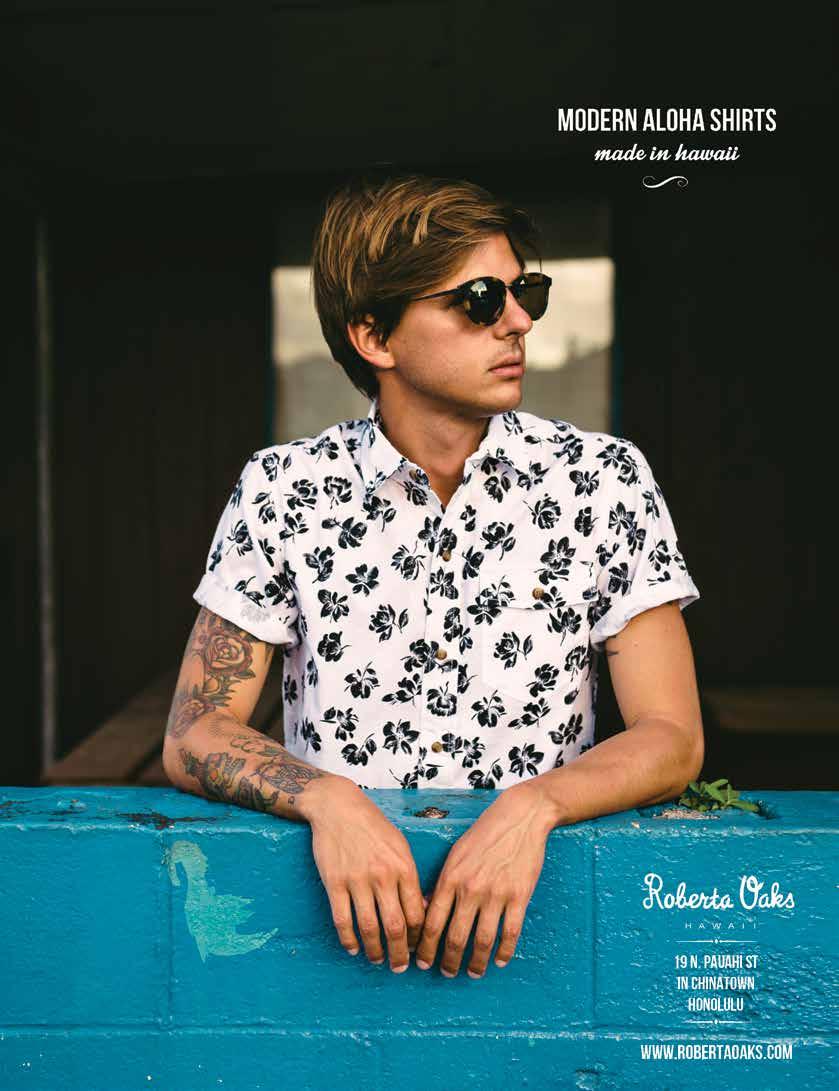

ORCHID RUNNERS
A NEW EVOLUTION OF ORCHID ENTHUSIASTS TAKES ROOT AND BREATHES LIFE INTO THE SEDATED SCENE.
62 | FLUXHAWAII.COM
TEXT BY CARMICHAEL DOAN | IMAGES BY AARON VAN BOKHOVEN

FLUXHAWAII.COM | 63

The form, color, and shape. Simplified, these are the three qualitative attributes that most people look for in an orchid when judging its beauty and inherent worth. Orchidaceae is the most common and diverse of flowering plant families in the botanical kingdom. Typically, or perhaps stereotypically, their beauty tends to draw fans and enthusiasts from the elderly and retiree communities who have the time, patience, and experience required to grow the plant. It is ironic, given the astounding diversity and natural brilliance of the flower, that local orchid societies are generally comprised of a single demographic within the hobbyist culture. Surging out of the primordial vortex of naturalists, however, a new breed of hobbyists is arriving with fresh energy and vigorous exuberance, shattering the mold of grandpa puttering out back with the trowel.
Traditionally, when most people
think of orchids in Hawai‘i, it conjures up connotations of the larger growing farms such as Kawamoto Farms, Akatsuka Orchid Gardens, Carmela Orchids, and H & R Nurseries in Waimānalo. In Hawai‘i specifically, the storied love affair horticulturists have with the flowering beauties spans back decades, including Steven Perlman and his crusade to restore the three indigenous species of orchid back to prominence (Anoectochilus sandvicensis, Liparis hawaiensis, and Platanthera holochila). Now, on the outskirts of the hobbyist scene, there lurks a growing presence of youth and renaissance.
Brad Hamasaki and Aaron Padilla are two such revolutionaries. They are the next evolution of the orchid-growing community on O‘ahu. Applying traditional methods, youthful vim, and a healthy dose of modern sensibility, the pair are exposing the art of orchid growing for what it is:
an exercise in patience, an affirmation in the overflowing natural beauty around us, and an opportunity to share the trials, tribulations, and successes with each other.
Brad Hamasaki, 35, is a project manager for Lyle Hamasaki Construction and has been collecting orchids for almost four years. As the face of the revolution, he is a striking herald of a new generation of orchid hobbyist culture, a massive hulk of a man whose yeti-like appendages contain the gentle touch required to coax the flowers into bloom. He is a soft-spoken, easy-going giant with a penchant for bringing things to life.
What started off as an impulse-buy at his first orchid show has since evolved into an obsession. “Orchids are notoriously difficult to bring to bloom; that’s why they are so rewarding,” says Hamasaki. He took this new interest and ran with it, diversifying from growing just orchids into an even healthier intrigue of odd plants
64 | FLUXHAWAII.COM
Brad Hamasaki (shown on the previous page) and Aaron Padilla (shown above) are part of a new set of orchid growers who are shattering stereotypes.

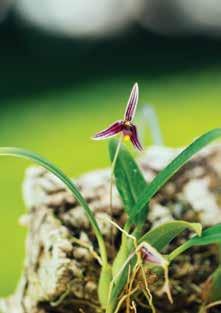
in general, including the amorphophallus, also known as the corpse flower. He began going to Oahu Nursery Growers Association shows at Thomas Square Park and Lyon Arboretum to hunt down and purchase plants. Like a kid with a new toy, he was buying as much as he could, and more. Now it is at the point that he barely has room for anything else at his house.
Hamasaki’s first foray into the botanical arts was growing herbs and spices on the lanai of his apartment to supplement his cooking hobby. As his interest in orchids and other horticultural endeavors grew, he adapted his experiences to suit the individual needs of his burgeoning orchid collection. Though Hamasaki is something of a purist and displays a visible distaste for the hybridization and bastardizing of species, he ad-libs the orchid-growing process to fit his busy lifestyle. For some of his plants that require rigorous and extensive caretaking, Hamasaki has rigged up varying apparatuses to aid with the watering and upkeep as he keeps up with the demands of his general construction
job. Most traditionalists in the growing community wouldn’t dare play with such delicate necessities, exhibiting little variance in techniques they’ve developed over the decades, but Hamasaki doesn’t give a damn. For this messenger from the future of orchids, his ends justify the means. “A lot of the orchids I like have developed very specific evolutionary traits, and that’s what draws me to them,” says Hamasaki, who is well-versed enough to spout the virtues and characteristics of his favorite species at the drop of a hat. (At the moment, it is the Bulbophyllum epicranthes.) “Really, I just like weird stuff,” he says.
With a voracious appetite for the oddities that arise from the seemingly infinite possibilities of Darwinian evolution, Hamasaki seems to straddle the lines of both generations, resulting in an entirely different beast. Outside of the standard channels of the orchid societies in Hawai‘i, he finds himself both drawn to and pushed away from his older contemporaries. “I’ve had many occasions where I’ve gone to an orchid show, and the other growers will be like, ‘Wow, you collect orchids, but you’re so young!’” he says. “There is a whole knowledge base there that I don’t get to tap into, but their experience is invaluable considering how long the process is to actually bring an orchid to flowering.”
That’s where Aaron Padilla comes in. “I call him my orchid guru,” says Hamasaki. Aaron Padilla is the excitable and passionate curator of education at the Honolulu Museum of Art Spalding House. A bookish, smaller individual, Padilla is an artist known for his cloud sculptures and organic interwoven pieces. He is at once articulate—a thoughtful advocate for orchid-growing culture— and introspective, an optimist about the qualities of hobby growing.
Padilla grew up around nature, and the natural world has had a profound effect on his philosophy, hobbies, and his art
as well. “I’ve always been around plants. My parents had a greenhouse where they grew orchids and anthuriums, so I grew up playing around in there.” Padilla’s initial interest in the natural world, however, began with fish. This translated into a job at a pet shop, where he would meet the man who would later become his mentor. “Aaron, you don’t want to get into orchids. It’s like crack!” he remembers the mentor telling him.
Years later, Padilla has become one of the tireless zealots forwarding the art with his intimate knowledge and his passion for creating. At a spry age of 39, he is one of the engines driving this renaissance and is acutely aware of the differences between his contemporaries and their elder rivals. “This young group that is burgeoning now has a youthful energy to it. There’s a little bit of a competitive nature to it so we push each other to be better growers. Of course we have our failures just as much as our successes, but it only drives us to be better and learn more.”
The orchid-growing process is a long and involved one, but immersing oneself in horticulture requires a slowing of pace and a devotion to learning. “To make art you have to do research, you have to have the technical background and expertise, then you have to apply that to achieve a completed piece,” says Padilla. “With orchids, it’s the same thing; you have to nurture it and give it the best possible environment to thrive with your knowledge and energy.”
Despite the amount of nurturing that goes into orchid rearing, Hamasaki says the plants have had a profound effect on him and his views on life. “Orchids have definitely changed me. I used to be all about the immediate-reward experience, but orchids have taught me patience.”
Padilla reiterates that optimism: “I believe there is an orchid for everybody.” Their efforts, in time, will also prove that there is more to an orchid grower than his or her shape, color, and form.
66 | FLUXHAWAII.COM
A budding plant from the “orchid guru’s” collection.
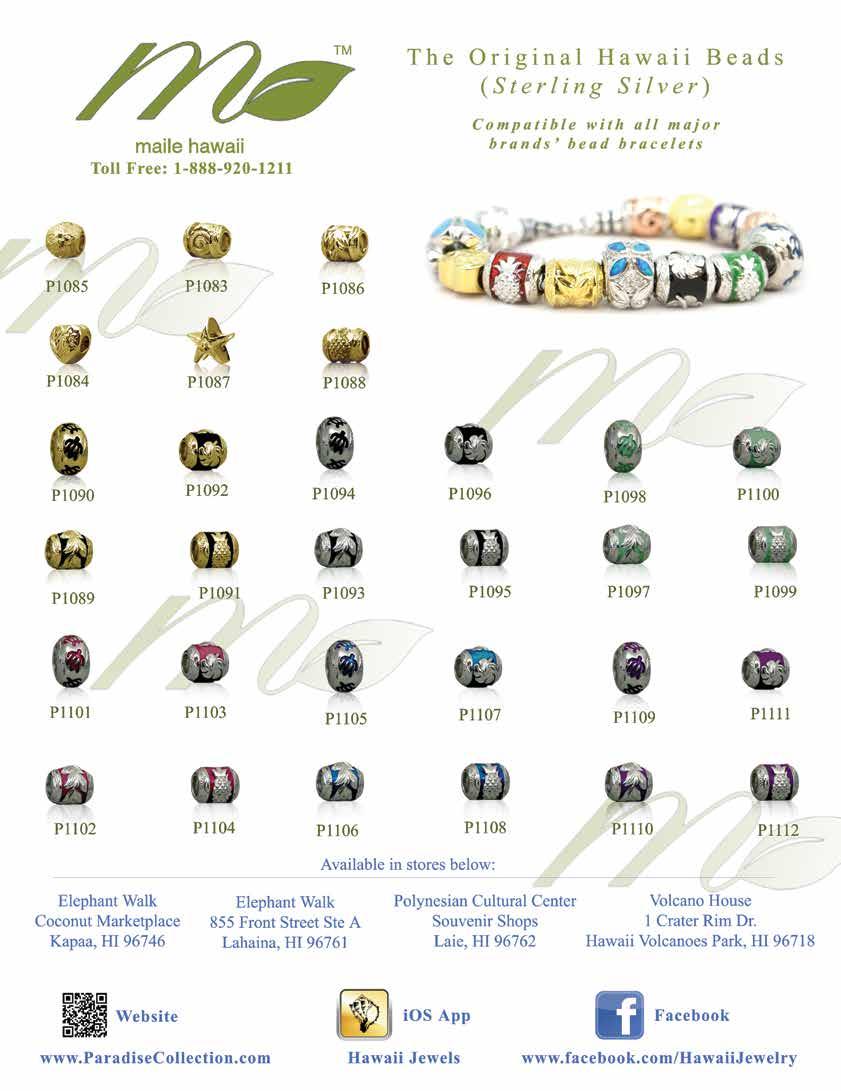
BORN IN THE 1960S OUT OF A SPIRIT OF REBELLIOUSNESS AND PERSONAL STYLE, ALOHA FRIDAYS SET THE TONE FOR THE LOOK THAT HAS COME TO DEFINE HAWAI‘I.
ALOHA
FRIDAY NO WORK
 FROM LEFT TO RIGHT: ROBERTA OAKS BROOKLYN BLACK AND WHITE FLORAL SHIRT; REYN SPOONER HAWAIIAN INDIGO BLUE AND WHITE STRIPED SHIRT; ROBERTA OAKS TIKI NIGHTS BLACK AND YELLOW FLORAL SHIRT; ROBERTA OAKS ALOHA TUESDAY BLUE AND PINK FLORAL SHIRT; ROBERTA OAKS PAUAHI PUNCH BLUE AND WHITE FLORAL SHIRT; ROBERTA OAKS NAVIGATION IVORY SHIRT; ROBERTA OAKS SERGIO GREEN AND BLACK FLORAL SHIRT; REYN SPOONER BLUE FLORAL SHIRT; ROBERTA OAKS AUKAI BLUE CANOE SHIRT; REYN SPOONER MUSTARD CANOE SHIRT.
FROM LEFT TO RIGHT: ROBERTA OAKS BROOKLYN BLACK AND WHITE FLORAL SHIRT; REYN SPOONER HAWAIIAN INDIGO BLUE AND WHITE STRIPED SHIRT; ROBERTA OAKS TIKI NIGHTS BLACK AND YELLOW FLORAL SHIRT; ROBERTA OAKS ALOHA TUESDAY BLUE AND PINK FLORAL SHIRT; ROBERTA OAKS PAUAHI PUNCH BLUE AND WHITE FLORAL SHIRT; ROBERTA OAKS NAVIGATION IVORY SHIRT; ROBERTA OAKS SERGIO GREEN AND BLACK FLORAL SHIRT; REYN SPOONER BLUE FLORAL SHIRT; ROBERTA OAKS AUKAI BLUE CANOE SHIRT; REYN SPOONER MUSTARD CANOE SHIRT.
ALOHA
FRIDAY ’ TIL MONDAY
 COLLAGES BY LANDON TOM
ALOHAWEAR IMAGES BY HAROLD JULIAN
COLLAGES BY LANDON TOM
ALOHAWEAR IMAGES BY HAROLD JULIAN

 FROM LEFT TO RIGHT: EDIE PARKER BAG, FALL 2014; TIFFANY & CO. RINGS; CHARLOTTE OLYMPIA GOLDFISH CLUTCH, FALL 2014; KOTUR GOLD CLUTCH, FALL 2014; BALLY YELLOW BAG, FALL 2014; MOSCHINO CHEETAH HEEL, FALL 2014; APERLAÏ BLUE AND WHITE HEEL, FALL 2014; THAKOON RED, BLUE, AND WHITE FLORAL DRESS, RESORT 2015; CHRISTIAN DIOR BLACK AND PINK FLORAL DRESS, RESORT 2015.
FROM LEFT TO RIGHT: EDIE PARKER BAG, FALL 2014; TIFFANY & CO. RINGS; CHARLOTTE OLYMPIA GOLDFISH CLUTCH, FALL 2014; KOTUR GOLD CLUTCH, FALL 2014; BALLY YELLOW BAG, FALL 2014; MOSCHINO CHEETAH HEEL, FALL 2014; APERLAÏ BLUE AND WHITE HEEL, FALL 2014; THAKOON RED, BLUE, AND WHITE FLORAL DRESS, RESORT 2015; CHRISTIAN DIOR BLACK AND PINK FLORAL DRESS, RESORT 2015.
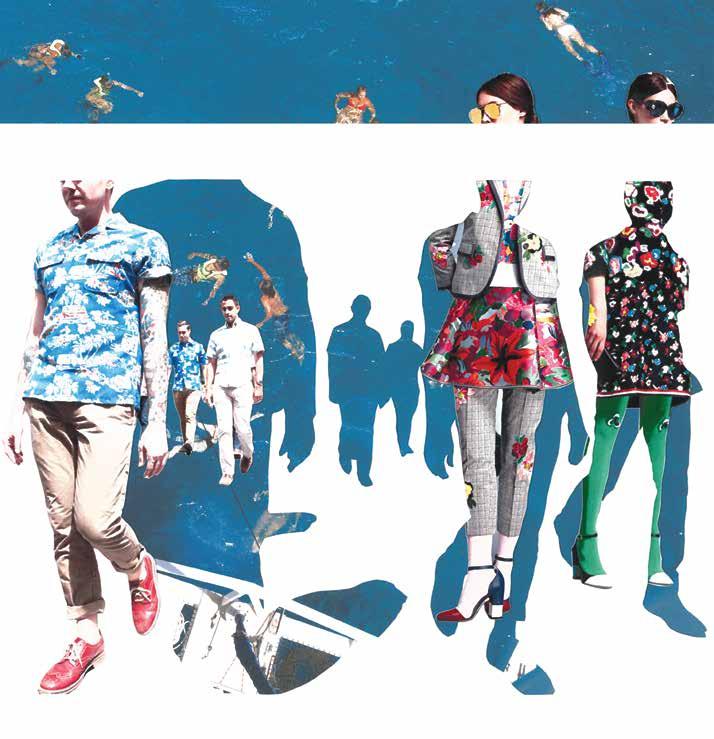 LEFT, FROM LEFT TO RIGHT: REYN SPOONER BLUE FLORAL SHIRT; ROBERTA OAKS AUKAI BLUE CANOE SHIRT; REYN SPOONER
HAWAIIAN INDIGO BLUE AND WHITE STRIPED SHIRT; THOM BROWNE RED FLORAL SKIRT, PANTS, AND BLAZER AND BLACK
FLORAL DRESS, RESORT 2015. RIGHT, FROM TOP TO BOTTOM: ZAC ZAC POSEN CLUTCH, FALL 2014; ALEXANDER MCQUEEN BLUE FLORAL DRESS, RESORT 2015; J. MENDEL STRIPED DRESS, RESORT 2015; BALLY YELLOW BAG, FALL 2014; CHELSEA
PARIS GRAY BOOT, FALL 2014; KOTUR GOLD CLUTCH, FALL 2014.
LEFT, FROM LEFT TO RIGHT: REYN SPOONER BLUE FLORAL SHIRT; ROBERTA OAKS AUKAI BLUE CANOE SHIRT; REYN SPOONER
HAWAIIAN INDIGO BLUE AND WHITE STRIPED SHIRT; THOM BROWNE RED FLORAL SKIRT, PANTS, AND BLAZER AND BLACK
FLORAL DRESS, RESORT 2015. RIGHT, FROM TOP TO BOTTOM: ZAC ZAC POSEN CLUTCH, FALL 2014; ALEXANDER MCQUEEN BLUE FLORAL DRESS, RESORT 2015; J. MENDEL STRIPED DRESS, RESORT 2015; BALLY YELLOW BAG, FALL 2014; CHELSEA
PARIS GRAY BOOT, FALL 2014; KOTUR GOLD CLUTCH, FALL 2014.

 FROM LEFT TO RIGHT: ALICE+OLIVIA FLOWER PANT AND BLAZER, RESORT 2015; ALEXANDER MCQUEEN RED FLORAL DRESS, RESORT 2015; CHRISTIAN DIOR BLACK AND PINK FLORAL, RESORT 2015; THAKOON FLORAL DRESS, RESORT 2015; ALICE+OLIVIA FLORAL PANT AND CROP TOP, RESORT 2015; THOM BROWNE SKIRT AND SWEATER, RESORT 2015; THOM BROWNE MULTI-FLORAL DRESS, RESORT 2015; THAKOON SKIRT AND SHIRT, RESORT 2015; CHRISTIAN DIOR BLACK AND PINK FLORAL, RESORT 2015; THAKOON FLORAL JACKET AND PANTS, RESORT 2015; CHRISTIAN DIOR SKIRT AND TOP, RESORT 2015.
FROM LEFT TO RIGHT: ALICE+OLIVIA FLOWER PANT AND BLAZER, RESORT 2015; ALEXANDER MCQUEEN RED FLORAL DRESS, RESORT 2015; CHRISTIAN DIOR BLACK AND PINK FLORAL, RESORT 2015; THAKOON FLORAL DRESS, RESORT 2015; ALICE+OLIVIA FLORAL PANT AND CROP TOP, RESORT 2015; THOM BROWNE SKIRT AND SWEATER, RESORT 2015; THOM BROWNE MULTI-FLORAL DRESS, RESORT 2015; THAKOON SKIRT AND SHIRT, RESORT 2015; CHRISTIAN DIOR BLACK AND PINK FLORAL, RESORT 2015; THAKOON FLORAL JACKET AND PANTS, RESORT 2015; CHRISTIAN DIOR SKIRT AND TOP, RESORT 2015.
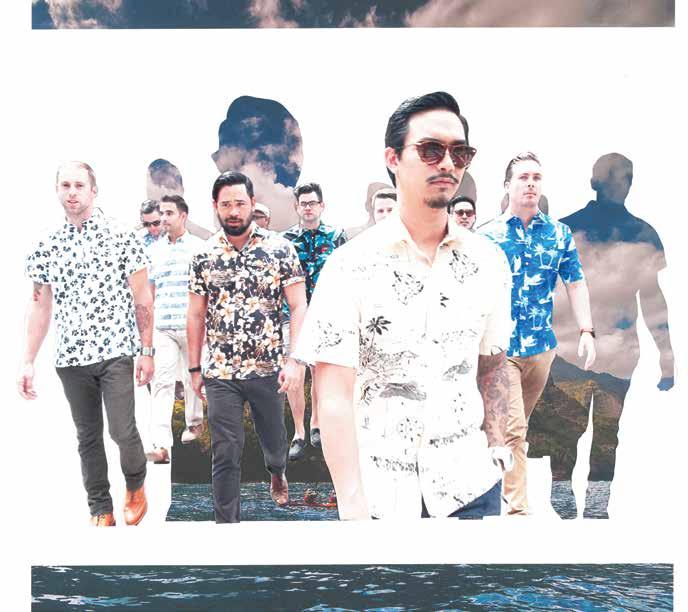
THIS GROUP OF DASHINGLY HANDSOME MEN ALSO HAPPENS TO BE COMPRISED OF SOME OF HAWAI‘I’S MOST ASPIRING YOUNG PROFESSIONALS. PICTURED
LEFT TO RIGHT: JUSTIN RIDGELY, OWNER, VOLCANIC ROCK GYM; ERIC CORDEIRO, PRODUCER, SIGNAL BY THE HAWAII INDEPENDENT; JOE BOCK, COO, NELLA MEDIA GROUP; WARREN DAUBERT, PARTNER, HUMANHAND DESIGN CONSULTANCY; DAVID A.M. GOLDBERG, WRITER, LECTURER, AND MEDIA DEVELOPER; TRAVIS FLAZER, OWNER, HOUND & QUAIL; KYLE LITTLE, COFFEE BAR MANAGER, HONOLULU MUSEUM OF ART; BRANDON REID, OWNER, THE MANIFEST; MATT HONDA, CREATIVE DIRECTOR, NELLA MEDIA GROUP; JEFF MULL, HAWAI‘I EDITOR, SURFER MAGAZINE.

DESIGN / FOOD / LIFESTYLE
CULTURE INFLUX
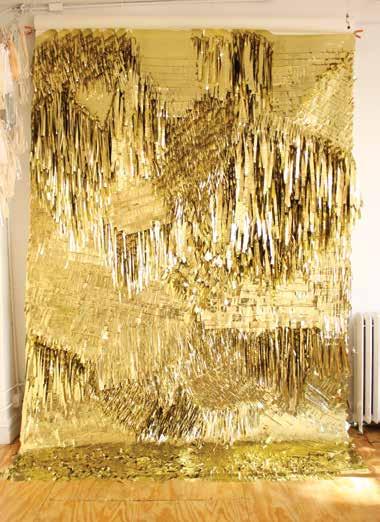
TEARING IT UP
MAKERS NICHOLAS ANDERSEN AND JULIE HO DISCOVER THAT THE WORLD IS ALWAYS A LITTLE BRIGHTER WHEN IT’S FILLED WITH CONFETTI.
TEXT BY MITCHELL KUGA
IMAGES COURTESY OF THE MUSEUM OF ARTS AND DESIGN
FLUXHAWAII.COM | 77
HOMECOMING
Most artists cringe at the thought of their work getting bashed in, tossed around, and torn up. But for Nicholas Andersen and Julie Ho, the duo behind New York-based Confetti System, destruction is a highlight.
Hung high over the stage of a recent dance party for MoMA PS1’s Warm Up 2014 outdoor music series were two Confetti System piñatas, geometric focal points for sets by DJs like Norway-based Cashmere Cat. Amid the mayhem, organizers whacked both piñatas—but only one broke, sending a giant cloud of confetti through the breeze. The other piñata accidentally soared into the crowd, bouncing beach-ball style through the sea of drunken revelers. Sunlight refracted off the golden strips of metallic foil before the piñata was finally punctured, sending bursts of confetti into the sky.
“It was better than we could have ever planned,” says Andersen at Confetti System’s Brooklyn studio. The moderate space, located just off the Williamsburg Bridge, hints at an orderly chaos: plastic containers labeled “store bought fringe,” “misc trimmings,” and “rope/string/wire”; colorful stacks of paper with names like “island pink” and “paradise blue”; a tub of Elmer’s glue surrounded by tape and scissors; an open box of Band-Aids nearby.
Andersen and Ho transform these everyday materials by hand into experiential landscapes that are usually textural, occasionally shiny, and always fantastical. Since their inception in 2008, Confetti System has designed customized window displays for the opening of J.Crew’s international flagship store in London, embellished a sculpture of the New York Times “T” for the cover of the newspaper’s magazine, and provided confetti for Beyoncé’s “1+1” video. Other clients include Opening Ceremony, Mercedes-Benz, and The American Ballet Theatre.
For the Museum of Arts and Design’s inaugural biennial, which features 100 New York City makers (on view through October 12th), Confetti System installed two pieces that reflect their signature aesthetic. “Fringe WallCopper” features gold fringe assembled in textural flurries of amorphous shapes that wrap around the elevator doors. It is Confetti System’s take on a deconstructed piñata, transforming the museum’s typically staid lobby into a something out of Warhol’s Factory. The adjacent wall holds “Catalogue 01,” a garden of pastel flowers constructed out of paper and fabric and punctuated with tassels of silver metallic foil. The sprawling pieces took two weeks and five pairs of extra hands to construct.
This floral display is the newest aesthetic direction for Confetti System and a nod to the artists’ upbringings. Ho, who was born in Taiwan and raised in Queens, recalls a youth surrounded by Asian temples and shops in Chinatown crammed with “special objects that get lost,” she says. “When we started, we realized we were both inspired by very simple objects, and we wanted to create our own versions of them.” Andersen, a graduate of Moanalua High School, was born and raised in Hawai‘i.
Florals are the newest aesthetic direction for Confetti System, and a nod to their upbringings.

View Confetti System’s metallic fringe in the lobby at the Museum of Arts and Design in NYC through October 12.
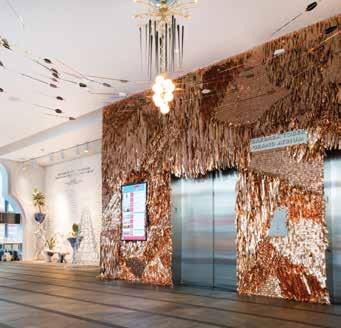
78 | FLUXHAWAII.COM


“It was better than we could have ever planned,” Nicholas Andersen recalls of the bursting piñata at MoMA PS1’s Warm Up 2014.

Growing up in Honolulu, Andersen recalls visiting the Bishop Museum on school field trips and being fascinated by the display of Native Hawaiian crafts. While others kids rushed through, Andersen stopped to ponder the intricacies of the featherwork and the craftsmanship of the flower lei. He sees some of Confetti System’s work as extensions of this childhood allure, likening the stripping of metallic foil for their party tassels to the techniques employed for tī leaf skirts and comparing their leather and silk necklaces to Hawaiian lei.
The pair, who met through friends in New York City in 2001, instantly bonded over shared experiences growing up as Asian Americans in cultural melting pots. The idea for Confetti System arose after the two began hosting decorating parties and lei-making get-togethers. “Having that sort of similar cross-cultural mash-up of everything—everywhere you look there is another culture mixed with another context—and being able to relate to each other in that way was important,” says Andersen, who is half Filipino. “And that joins Hawai‘i and New York in a very special way that doesn’t happen everywhere in the world. It’s nice to have that reference for us to share.”
For more information, visit confettisystem.com.
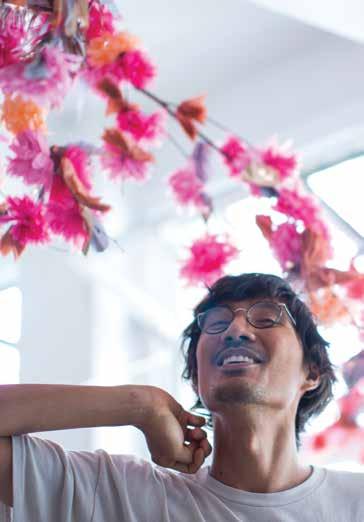
FLUXHAWAII.COM | 79
IMAGE BY SARAH FORBES KEOUGH
DESIGN / FOOD / LIFESTYLE
CULTURE INFLUX
MOD SPACE
AS ALOHA FRIDAYS WERE TAKING ROOT IN HAWAI‘I IN THE 1960S, AND MEN WERE THROWING CAUTION—AND SUITING—TO THE WIND, MOD FEVER WAS SWEEPING BRITISH SUBCULTURE. HERE, OUR TAKE ON HOW THE MOD-MOOD CAN SLIP INTO THE FUTURE.

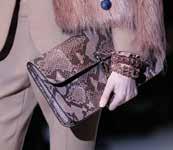
Taking inspiration from this era, Gucci’s Fall/Winter 2014/2015 collection by Frida Giannini at Milan Fashion Week was outta sight.
Sophisticated yet playful, the collection featured knee-high boots in python and taupe, paying the perfect complement to the A-line dresses in subdued hues. But it was the menswear-inspired pieces, with clean tailoring and slim fit, that made the boldest statements. Paired with square-heeled loafers, bold, embellished accessories, shaggy fur coats, and tinted glasses, they brought out the boss in us all.
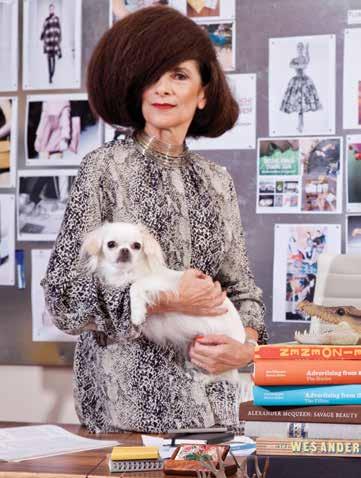

80 | FLUXHAWAII.COM
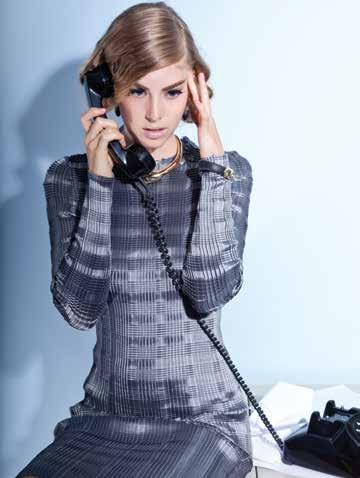
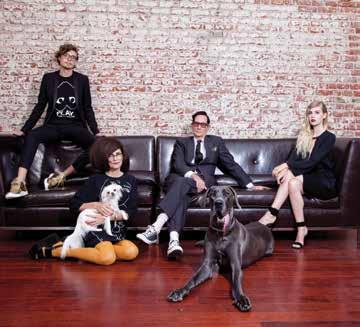


With Hawai‘i on the forefront of space exploration (a mock mission to Mars on Mauna Loa, a monstrous telescopic addition to Big Island’s 13 existing observatories), it gives us cause to wonder what our tropical island paradise might look like under a sci-fi lens, both figuratively (editor-at-large Sonny Ganaden poses one realm on page 36) and literally.
If we have our way, it’ll resemble Ferragamo’s Fall 2014 collection at Milan Fashion Week, filled with pod-like outerwear (those in Hawai‘i never lamented the islands’ lack of dramatic seasons more); refined silhouettes in black, gray, and gold; and sleek pleated skirts and dress.
OPPOSITE PAGE:
DEE LANVIN SHIRT AND PANTS, NORDSTROM; VINTAGE NECKLACE AND BRACELET, BARRIO VINTAGE.
ALEX K TOPMAN BLAZER, NORDSTROM; REYN SPOONER SHIRT.
THIS PAGE:
ALEX B ALEXANDER WANG PLEATED TOP AND SKIRT, NEIMAN MARCUS; ALEXIS BITTAR NECKLACE, BRACELET, AND EARRINGS, NEIMAN MARCUS; VINTAGE PHONE, HOUND & QUAIL.
FROM LEFT TO RIGHT, ALEX K TOPMAN BLAZER AND PANTS, NORDSTROM; COMME DES GARCONS PLAY SHIRT, NORDSTROM; NIKE SHOES, KICKS HAWAII. DEE STELLA MCCARTNEY DRESS, NEIMAN MARCUS; JEFFERY CAMPBELL SHOES, NORDSTROM; VINTAGE BRACELET, BARRIO VINTAGE; GLASSES AND STOCKINGS, STYLIST’S OWN. MICHAEL REYN SPOONER POCKET SQUARE; BURBERRY BELT, T GALLERIA; SUIT AND SHOES, MODEL’S OWN. ALEX B GIORGIO ARMANI TOP, BELT, AND SKIRT, NEIMAN MARCUS; SAINT LAURENT SHOES, NEIMAN MARCUS.
FLUXHAWAII.COM | 81
DESIGN / FOOD / LIFESTYLE
CULTURE INFLUX
STATIONARY STATIONERY
LOCAL PAPER PRODUCTS THAT ARE REVIVING THE LOST ART OF LETTER WRITING AND OTHER HANDMADE GOODS
TEXT BY BIANCA SEWAKE
IMAGES BY HAREN SORIL
In a day and age when communication moves at 4G speed and products are mass-produced, there is something special about receiving made-by-hand goods. Here’s a look at several talented people in Hawai‘i who are creating local, handmade paper products:
NICO MADE
“They’re perfectly imperfect,” says owner Nicole Ferrara. From the floral prints to the fishes in the sea, each quirky hand-drawn card is inspired by life in the Pacific. “Not only do our cards have fun and bright and cheery prints that really make you think of Hawai‘i and the tropics,” says Ferrara, “but they also help put a smile on people’s faces when you go to the mailbox or open a gift.” nicomade.com
MAU-HOUSE
“I try to keep it pretty simple,” says owner Andrew Mau, who carves his designs into rubber stamps and uses permanent ink to create a simple, patterned card. “I’m not trying to make a cheeky greeting card as much as I am trying to make that one really basic card you always have in your drawer.” mau-house.com
PASSION FRUITS DESIGN
Passion Fruits Design owner Tram Nguyen designed her first line of cards after being inspired by “the beauty of the things in this world, from flowers and nature to people in all walks of life,” she says. Nguyen uses watercolor, pen and ink, and digital methods to create her paper products. @passionfruitsdesign
and
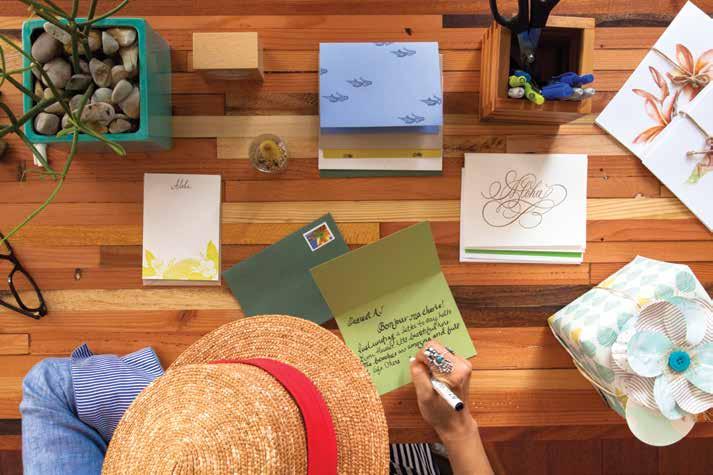
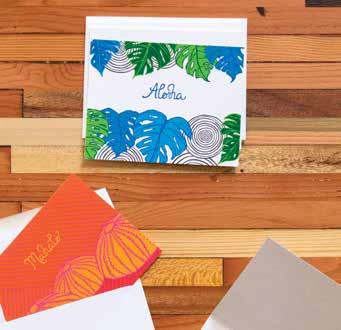
82 | FLUXHAWAII.COM
Shown left to right: Miemiko / Co., Mau-House, Island Penman, Wrappily,
Passion Fruits Design.
Shown left: Nico Made.
Shown right: Mau-House.


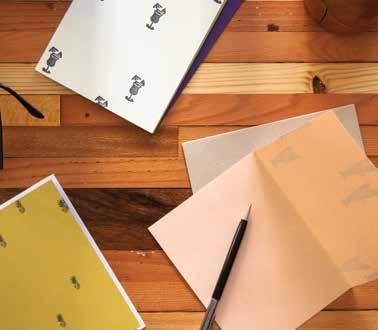
ISLAND PENMAN
“I really couldn’t find nice, non-touristy cards that weren’t printed on some plastic-y paper or that didn’t have a dolphin on it,” says UH Mānoa design professor and Island Penman founder Chae Ho Lee. He sketches every letter before translating it to the computer. Then, each card is printed by a company on Maui that does letterpressing.. “The machine creates different impressions on the paper depending on how much ink you put, so there’s a uniqueness to every card.”
islandpenman.com
BRADLEY AND LILY FINE STATIONERY
After designing a card for her son’s birth announcement, Bradley and Lily Fine Stationery founder and South Shore Paperie owner Stacey Nomura began getting requests from friends for things like wedding invitations. With business growing, Nomura and her husband purchased an antique letterpress and named the company after their son and daughter. “Everything I saw growing up [in California] was really classic and tailored,” she says. “Here, it’s fun and bright and colorful. So I like to mix the two together.” bradleyandlily.com
EVERYTHING IS JAKE!
“It all started when my wife wanted some artwork for our house,” says owner Nick Kuchar. “I started doing these surf-styled travel posters of different locations we’ve been to in Hawai‘i.” He begins by sketching his ideas by hand or digitally using a Wacom Tablet, then he overlays different textures and distresses the prints to give the posters his signature nostalgic look. everythingisjake.com
MIEMIKO / CO.
“I just want people to feel some kind of joy and also use it to connect with others,” says Cari Nakanishi, whose foray into stationery came after creating invitations for friends. After learning to operate a letterpress, Nakanishi serendipitously received one of her own as a gift. She uses her cast-iron letterpress to create products such as cards and wedding invitations. miemiko.com
WRAPPILY
“After every party, I found myself trying to smooth out the wrapping paper,” says Wrappily owner Sara Smith, who is based on Maui. Since standard wrapping paper is not recyclable, Smith brainstormed solutions for a more eco-friendly approach and hit upon printing reversible designs on newsprint, which can be recycled up to seven times. She collaborates with local designers to create fresh and contemporary designs. wrappily.com
FLUXHAWAII.COM | 83
PALATE FOREPLAY
A LOVE AFFAIR WITH ‘ULU AND ALL ITS VARIED FORMS
TEXT BY JENNIFER MELEANA HEE
IMAGES BY TOMMY SHIH
There are a few formative experiences I missed while growing up in Honolulu: learning how to surf or use power tools; radical destructuring of leaf piles; and enjoying the spectacular fruit that is ‘ulu, also known as breadfruit. I left Hawai‘i for college, the Peace Corps, and a man I met online before returning home and becoming a cook. Only while working in a local kitchen did I begin the most enduring love affair of my life—with ‘ulu.
‘Ulu has a long history in the islands. According to Hawaiian mythology, the god Kū saved his family (and the entire community) during a period of famine after burying himself in the ground and transforming into an ‘ulu tree. It arrived to the islands with Polynesian voyagers, who canoecarried the staple crop, and flourished, used as a food source and material for construction and crafts.
Despite this historical validation, ‘ulu is far from today’s media darling. At first and every glance, the bumpy, oozy fruit looks wholly unsexy. But once you experience all its bounty, simply saying ‘ulu becomes intense palate foreplay. Mature ‘ulu is classy enough to be found in the entrées of Hawai‘i’s top chefs; overripe, it transforms into a creamy, indulgent dessert ingredient.
You can tell ‘ulu is maturing by its increasingly unattractive appearance. The vibrant, green skin turns crusty and yellow, sappy and smooth. Super-ripe ‘ulu has the consistency of soggy dough, while moderately ripe ‘ulu is firm enough to be cubed or sliced, then fried or steamed
Moderately ripe ‘ulu can be cubed or sliced, then fried or steamed and tossed into soups, breakfast hash, or this hearty Moroccanstyle curry.
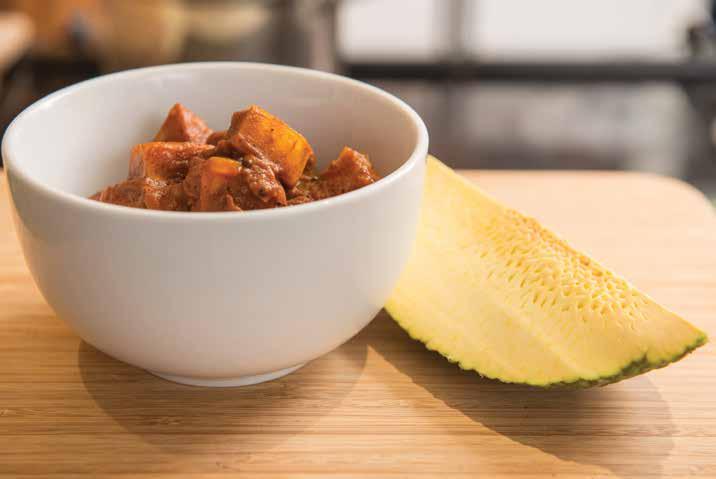
Super-ripe ‘ulu pulp makes for yummy chia muffins. Find the recipe online at fluxhawaii.com.

LIFESTYLE
84 | FLUXHAWAII.COM
DESIGN / FOOD /
CULTURE INFLUX


and tossed into soups, breakfast hash, or salads. You can also dehydrate thin slices, dipping the chips in chili, honey, or guacamole. I like to simply blend an overripe ‘ulu with coconut milk, bake it until the top is crisp, and scoop spoonful after spoonful of the warm, sweet custard into my mouth. While I have yet to roast ‘ulu in an imu, it’s on my vision board between photos of Everest and 100 frolicking baby goats.
‘Ulu, which is rich in carbohydrates and potassium, is occasionally available at Kokua Market for $1.99 per pound or at farmers markets from vendors such as Otsuji Farm, but I’ve found the best way to acquire it is to let it be known on the coconut wireless that you have an unconditional ‘ulu love, whenceforth ‘ulu, baby goats, and Everest will appear in your life with abundance.
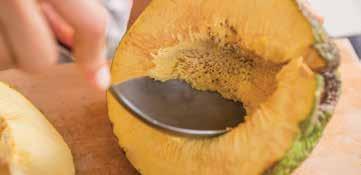
1. Wash, then slice in half vertically along the edge of the stem.
2. Pull or cut out the core and the brown, fibrous area surrounding it.
3. Keep an eye peeled for seeds to remove. The amount and location of the macadamia nut-sized seeds vary.
4. If the ‘ulu is super-ripe (very soft when gently squeezed), simply scoop out the insides. With moderately ripe ‘ulu, cut into bite-sized chunks and slice off the skin before roasting or steaming until tender. Pre-cooked ‘ulu freezes well for future use.
MOROCCAN-STYLE ‘ULU CURRY
Gluten Free and Vegan
12 servings:
• 4 tablespoons coconut or olive oil
1 medium onion, diced
large cloves garlic, minced
1-1/2 tablespoons cumin seeds
1 large carrot, diced
1 large ‘ulu, cubed
1 4.5-ounce can diced tomato • 1 tablespoon tomato paste • 6 cups water
• 1 15-ounce can chickpeas, white beans, or lentils
• 1 cup dried apricot, diced
• 2 vegan bouillon cubes
• 3 tablespoons agave
• 2 tablespoons lemon juice
• 1-1/2 tablespoons coriander
• 1-1/2 tablespoons cinnamon
• 1 teaspoon turmeric
• 1 teaspoon ground cloves
• 1/2 teaspoon allspice
• 1/2 teaspoon cayenne
• 3 bay leaves
• 2 teaspoons black pepper
• 1 teaspoon sea salt
1. In a large pot, heat oil over medium heat and sauté onions for 10 minutes. Add garlic, cumin seeds, and carrots and sauté for another 5 minutes, stirring frequently.
2. Add all remaining ingredients. Bring to a boil for a few minutes before reducing heat to low. Stir frequently to keep bottom from burning.
3. Simmer for around 20 minutes, stirring occasionally, until ‘ulu can easily be pierced with a fork. Adjust seasonings as needed. Enjoy with whole grains or naan.
FLUXHAWAII.COM | 85
HOW TO PREPARE ‘ULU:
•
• 8
•
•
•
•
A TASTE OF HOME
MAUI-BASED CHEF SHELDON SIMEON SHARES THE FLAVORS OF HIS FILIPINO AND HAWAI‘I HERITAGE AT MIGRANT MAUI.
TEXT BY SARAH RUPPENTHAL
IMAGES BY JOHN HOOK
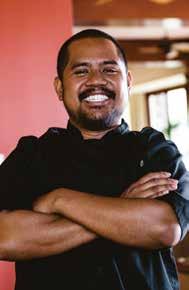
He has cooked for A-list actors, music legends, and captains of industry, but when you meet Sheldon Simeon, you’ll find a chef grounded in cultural heritage. Simeon first dabbled in cooking as a kid in his family’s kitchen in Hilo. Discovering he had a knack for turning local flavors into culinary delights, he followed in his chef brother’s footsteps and enrolled in culinary school. “I originally wanted to be an architect,” Simeon admits, flashing his trademark megawatt smile. “But cooking just seemed like a more natural fit.”
Simeon quickly became a household name as the executive chef of Lāhainā’s now iconic Star Noodle and later as the executive chef of Mala Wailea, heralded for creating dishes that combined Hawaiian cuisine with Asian influences. Simeon eventually joined the ranks of the

86 | FLUXHAWAII.COM
DESIGN / FOOD / LIFESTYLE CULTURE INFLUX
A Top Chef fan favorite, Maui-based chef Sheldon Simeon serves up cuisine inspired by his Filipino heritage at his restaurant, Migrant Maui.

culinary elite as one of the final three contenders on Top Chef: Seattle, the very first chef from Hawai‘i to compete in the popular Bravo franchise. He may have lost the competition, but he won the hearts—and appetites—of Top Chef viewers across the country, earning the show’s coveted “fan favorite” award. To top it off, Simeon was crowned The People’s Best New Chef 2014, Northwest and Pacific region by Food & Wine magazine.
You can sample Simeon’s culinary genius at his new restaurant, Migrant Maui. Living up to its namesake, Migrant serves up modern, local cuisine inspired by the Filipino meals and recipes of Simeon’s youth infused with the heritage of the Chinese, Japanese, and Portuguese immigrants that came to work on Hawai‘i’s plantations. He says he owes his passion in the kitchen to his grandparents, who were immigrants to Hawai‘i, as well as his father, who taught him how to cook. “My dad has always been, and will always be, the best chef,” Simeon says.
On the Migrant menu, you’ll find a range of tantalizing options utilizing local ingredients, including brick oven-blistered shishito peppers, hibachi hanger steak, pancit noodles, and French onion tsukemen (ramen with a twist). With his menu, Simeon hopes to encourage his guests to embark on an epicurean adventure. “I encourage all visitors to go out and try authentic Hawaiian cuisine,” he says. “Seek out big, bold adventures for your palate, because Hawai‘i has so much to offer.”
Migrant’s catchphrase is “Come my house. Eat.” And indeed, Migrant emulates the warmth of Simeon’s childhood home, the site of vibrant family gatherings. “This is how you’d eat at my house,” says Simeon. “Plus, it’s part of our history and culture here. In the plantation days, people brought what they wanted and shared it with others.”
Without question, Migrant is a tribute to Simeon’s trailblazing style. It’s no easy task, but it’s clear that chef Simeon is up for the challenge. “I’ve learned it’s important to take chances and put your heart into what you do,” he says. “My advice to anyone in any field is to seize any opportunity that comes your way—and always be true to yourself.”
Migrant Maui is located at the Wailea Beach Marriott Resort and Spa, 3700 Wailea Alanui Dr., and is open seven days a week, from 5–10 p.m. (Migrant’s “Be Happy Hour” runs from 4–6 p.m. and the lounge is open until 11 p.m.). For reservations, call 808-875-9394 or visit migrantmaui.com.
FLUXHAWAII.COM | 87
HOMETOWN HERO
NATIONAL CHAMPION BARTENDER
JUSTIN PARK PORES OVER THE DETAILS.
TEXT BY LISA YAMADA
“I’m just happy to be here,” Justin Park remembers gushing to Julio Cabrera, the rock-star Miami bartender who had recently graced the cover of GQ magazine. Park, the Honoluluborn-and-raised bar manager of Chinatown’s The Manifest, had just faced 15 of the nation’s top bartenders. And it boiled down to this, he says, imitating the announcer: “The winner of the United States Bartending Guild’s Shake It Up Competition, earning the right to represent the United States in the USBG World Cocktail Championship”—“it’s like the World Cup of cocktails,” interjects Park into his story—“is Justin Park!” And the crowd goes wild.
Two weeks after returning from cocktail’s largest national stage, which took place this past March, Park is still glowing like a kid in a candy store. After sweeping both technical and overall categories, an unprecedented feat, Park is now officially the best bartender in the nation, and soon, quite possibly, the world. The Las Vegas contest served as a qualifier for the World Cocktail Championship 2014, which takes place this September in South Africa and will feature 60 of the world’s best bar men and women vying for global cocktail supremacy. Park will be there, representing Hawai‘i— “from this little bar to the world,” he says.
Rumblings of Park’s ascent first began in 2012, when he began crushing local competitions including Bombay Sapphire’s Most Imaginative Bartender Invitational, the Bacardi Oakheart
Justin Park will represent Hawai‘i to the world when he takes on 60 of the world’s best bartenders at the World Cocktail Championship 2014 in South Africa.
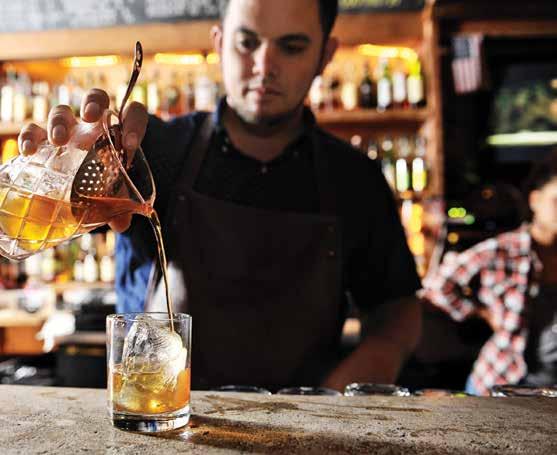

LIFESTYLE
88 | FLUXHAWAII.COM
DESIGN / FOOD /
CULTURE INFLUX
A true artist, Park never stops creating.
IMAGE BY JOHN HOOK
IMAGE BY JONAS MAON


Iron Bartender, and Don the Beachcomber’s Mai Tai Mix-Off. His imaginative cocktail creations and impassioned showmanship won the hearts and taste buds of the judges and general public alike. But, as Park would learn while competing in Portland at the USBG Campari Best Aperitivo Cocktail Contest, it wasn’t just about crafting a good drink, but how one creates it. “Everyone always asks me what drink I made, but it wasn’t just that,” he says. “Taste is so relative, but what’s not relative? The technique … how I made it, how I presented myself, how I presented the drink, how it tasted.”
He would go on to win the Campari event, earning one of 78 spots with a chance to compete in Shake It Up. But his acceptance wasn’t guaranteed yet. “The reason why I feel I should be chosen,” Park recalls writing in his application essay for the competition, “is because I’ve succeeded at a national level coming from a small market due to my own passion and desire for it. My market is so small, there’s not major bartenders I can look up to and find knowledge from—I have to seek it out. So being an ambassador for the USA and the USBG, that’s a quality you can’t teach somebody.” Needless to say, he was one of the 15 accepted.
Park’s drink for Shake It Up featured Wild Turkey 101 as a base, mixed with yellow chartreuse, apple brandy, blackberry-muddled honey, an egg white, and a bit of lemon juice, topped with a spray of angostura bitters and apple slices cut to look like a wing. “The category I got was ‘fancy cocktail,’ which can be anything,” he says. “Personally, when I think fancy cocktail, I think of how it can wow visually, because the taste of a drink should always be fancy.” Park practiced the complex drink repeatedly until he knew exactly where each tool would be placed after he finished using it.
This work ethic and dedication to perfection is much of what has made The Manifest, known for its large whiskey selection and imaginative drinks, a favorite work/play area for both artists and entrepreneurs alike. “I read and practice, then read some more and practice some more,” he says. “It’s like going to school, learning and slowly building, then when you get an idea of what ingredients go together, you start creating.”
Watching Park create, whether in a competition or behind the bar at The Manifest, it’s clear he loves what he does, that boyish grin never leaving his face. Not just a maker of cocktails, Park is an artist. Some may roll their eyes at this, but like any artist, Park simply can’t stop playing with ideas, discovering something new to make or do. Whether he’s crafting handmade leather goods and aprons, like the ones his bar staff dons, or paintings using bitters as his color pop, Park’s creativity does not end at the bottom of a glass—albeit a carefully selected, intricately etched one—but extends into every facet of his life.
Find Justin Park behind the bar at The Manifest, located at 32 N. Hotel St. For more information, visit manifesthawaii.com.

(THAT’S 30% OFF THE COVER PRICE!)
$16 ANNUAL SUBSCRIPTION
TO SUBSCRIBE: FLUXHAWAII.COM/SUBSCRIBE
DESIGN / FOOD / LIFESTYLE
CULTURE INFLUX
A PERFECT DAY ON: MAUI
TEXT
AND IMAGES BY
HAREN SORIL
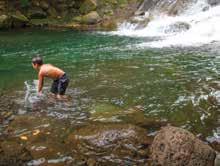
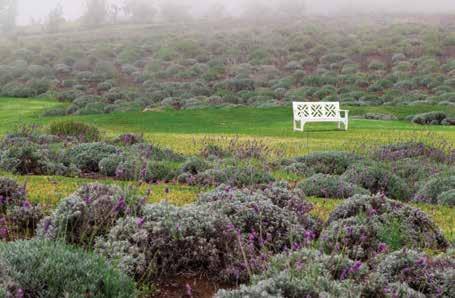
A
Growing up on Maui, I hardheadedly thought there was nothing to do on the island (kids will be kids, right?), but I proved myself wrong on a recent trip home. For both the adventurous traveler and the callous local like myself, Maui is the place to be. In just one day, cultural activities can be mixed with stops at favorite local eateries and coldwater streams, making for a great escape from the stresses of our daily routines. From sunrise to sunset, living local on Maui is an experience that will have anyone falling in love—or back in love— with the Valley Isle.
Get off to a good start: Hidden on the curved slopes of Upcountry Maui in the historical plantation town of Haiku is Colleen’s At The Cannery. Open sharply at 6 a.m. daily, this restaurant’s menu offers a diverse list of contemporary American breakfast items such as eggs benedict, sandwiches, breakfast burritos, and healthy alternatives for vegetarian or vegan diners, perfect to get energized and begin the day’s adventures.
If you’re looking for lighter fare, try the lavender scones at the Ali‘i Kula Lavender Farm, where clouds envelop the lavender landscape like a scene from a Twilight movie. The farm boasts more than 40 varieties of lavender and various plants such as protea flowers and succulents. Grab a cup of lavender tea or coffee at the shop before joining a tour through the fields and gardens. The relaxing scent of lavender will set a good mood for the rest of your trip.
Mid-morning mellow: Take a drive from one mountain to the next and enter ‘Iao Valley. Hiking to the nearby ‘Iao Needle peak, visitors will find extravagant views of West Maui’s uninhabited valleys and waterfalls. Take a quick dip in the ‘Iao Stream and cool off in the coldest fresh water on the island. Then, visit the Hawai‘i Nature Center within the park for more information about their nature walks and an in-depth history of Hawai‘i’s culture.
Afternoon away: After the morning’s activities, venture into the town of Kīhei for lunch. Home to local markets, restaurants, and South Maui’s famous bar-hopping nightlife, Kīhei is filled with a melting pot of eateries. The best pick for
lunch is Cafe O’ Lei, which sits atop the Rainbow Mall and serves a wide variety of food options ranging from island-style cuisine and comfort food to a raw bar and the best sushi on the island.
Sundown: The drive on the way to West Maui’s Kā‘anapali Beach traverses magnificent views of the Pacific Ocean and is a wonderful short trip for sightseeing and taking pictures. Sometimes, whales can be spotted breaching out of the water, so have a camera handy and your eyes peeled. At the end of Kā‘anapali Beach is Black Rock, where locals often jump off into the water for fun. Stick around for the sunset, and let the warm tones in the sky help end the perfect day on Maui.
Sweet goodnight: On the way back from the day’s spectacular events, stop by Leoda’s Kitchen and Pie Shop in the small town of Olowalu. Known for freshly baked goods, Leoda’s also cooks up drool-worthy fare inspired by grandma’s home cooking, like chicken potpie and juicy burgers. Try the seared ahi sandwich for a fresh taste of the islands, and celebrate the best ending of the perfect day with homemade banana cream pie.
90 | FLUXHAWAII.COM
perfect day on Maui is not complete without a visit to Ali‘i Kula Lavender Farm, where clouds envelop the lavender landscape.
Spend the afternoon at ‘Iao Valley and cool off in the coldest fresh water on the island.
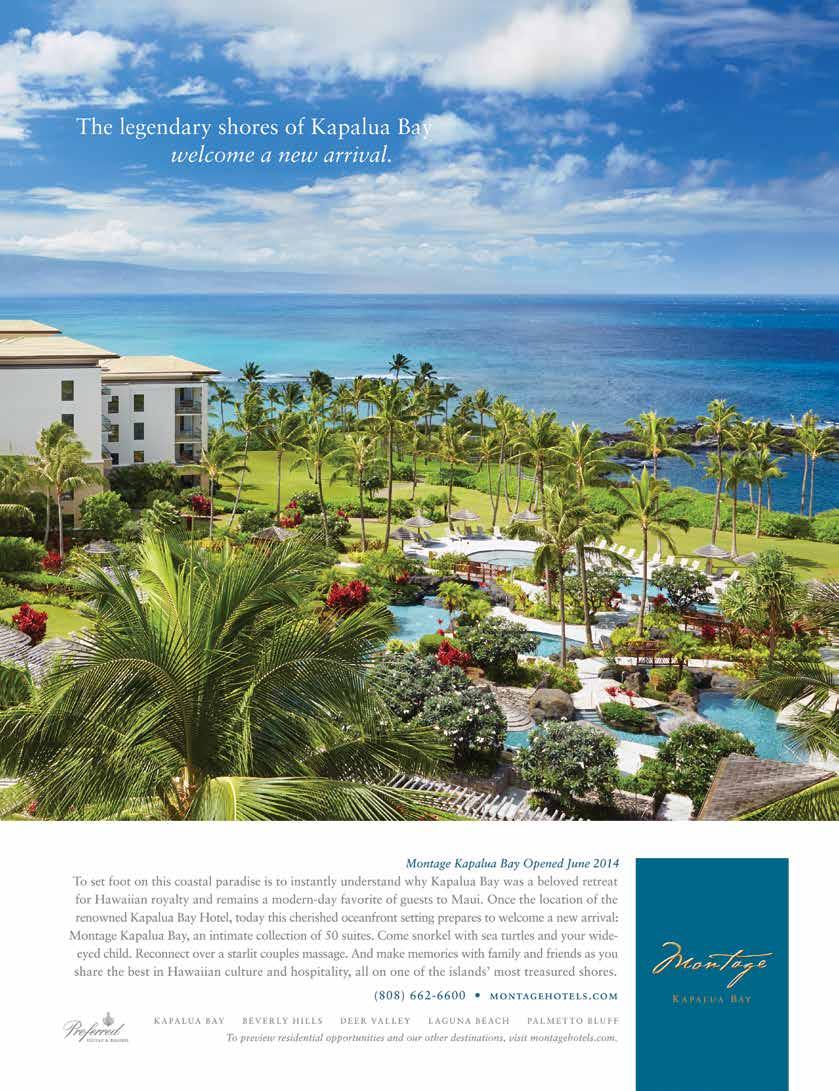
VIEWS IN FLUX
SURF IN HIGH RELIEF
LOCAL AUTHOR TYLER
MCMAHON’S PROTAGONIST SETS OUT ON A VIVID EL SALVADOR MISADVENTURE OF EPIC SCALE, FINDING ESCAPE ONLY ON THE WAVES.
REVIEW BY ANNA HARMON
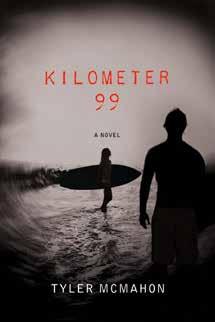
It starts with a near perfect barrel ride at a Salvadoran surf break, closed out in a heap of whitewash and a heavy dose of foreshadowing. With short chapters that pile on quickly and often end with a cliffhanger, Kilometer 99 is a fast-paced read
about a young Peace Corps engineer from Honolulu. The no-fuss writing and girlabroad theme initially suggest a charming beach read; however, it is no delightful traveler’s escape to El Salvador, no feelgood Eat, Pray, Love. Local writer Tyler McMahon’s prose instead swiftly builds the setup for an adventure that tragically devolves shortly after the scene is set.
The plot centers on Malia, nicknamed “Chinita” by a Salvadoran crackhead, a Peace Corps volunteer who headed to El Salvador for a chance to see the world. Instead, she finds herself faced with widespread destruction after an earthquake racks the country, her nearly completed water project destroyed. She and her boyfriend decide to cash out and take a surf trip around South America, only to get waylaid by a mysterious bumbling foreigner who pulls them into increasingly shadier deals.
Surf sessions and flashbacks are McMahon’s relief devices—if it weren’t for them, both Malia and the readers would walk away. McMahon’s writing stumbles slightly over a few bits of dialogue and a sex scene in which he compares a man’s bearded face with the rubbery muzzle of a horse; while the references to O‘ahu and Hawaiian words are nice to read, they can feel forced. Instead, it’s in the descriptions of the surf sessions, the vividness of El Salvador, and the intense moments when things get progressively worse that McMahon’s writing shines.
His protagonist Malia is a welldeveloped character far from the virginal victim trope still found in many novels (think 50 Shades of Grey)—instead, she is an empowered, multi-faceted young woman who at times is easy to loathe, share frustrations with, and completely understand. When a second earthquake hits El Salvador after her passport and money have been stolen—her plans to wander South America with her boyfriend shattered, and her faith in humanity and herself forcibly deconstructed—she picks
up a surfboard and heads for the ocean. “I realize then, or remember perhaps, that the surfer’s idea of perfection is different from everyone else’s,” Malia narrates. “It isn’t abstract or inscrutable, some shadow on the wall of a cave. We know what it feels like—perfection—how it looks and the sound it makes.” Only when she realizes the contrast of this paradise and the hell on land does she turn around to help.
Kilometer 99 feels like riding a train already off its tracks, and McMahon never veers. McMahon, a professor of English at Hawaii Pacific University who was a Peace Corps volunteer in El Salvador, creates an engaging narrative spiced with convincing details, from local Salvadoran food and architecture to the types of characters found in a seaside town infected by crack cocaine. In this quick read, El Salvador flashes by the window. Kilometer 99 is more destination than escape—it’s a novel, after all—and one worth visiting. Just know that it’s OK to take a surf break just as Malia does when her life is too much to handle.
Kilometer 99: A Novel By Tyler McMahon Released June 2014. 352 pp. St. Martin’s Griffin. $15.99.
ARTS / COMMUNITY / BOOKS
92 | FLUXHAWAII.COM

CONTINUING VALUE
THE FOLLOW UP TO THE VALUE OF HAWAI‘I PROMPTS DIALOGUE ON SOME OF HAWAI‘I’S MOST PRESSING ECOLOGICAL AND SOCIAL ISSUES THROUGH NARRATIVE.
REVIEW BY SONNY GANADEN
“We are ‘Oiwi and settlers who have benefitted from the Hawaiian renaissance, and still we see so many unfulfilled promises and obligations to the Hawaiian people and nation,” write co-editors Aiko Yamashiro and Noelani Goodyear-Ka‘ōpua in the preface of The Value of Hawai‘i 2: Ancestral Roots, Oceanic Visions, published this year by University of Hawai‘i Press. As a series of autobiographical essays, the book is explicit in its goal of crafting a new series of narratives of Hawai‘i. Making the rounds on public radio and community talk story sessions, Yamashiro, Goodyear-Ka‘ōpua, and their contributing authors represent the front lines of those making progressive change in the state.
When The Value of Hawai‘i: Knowing the Past, Shaping the Future was published by University of Hawai‘i Press in 2010, Hawai‘i was having some personal issues. Trailing the years of the Bush presidency with a housing crisis and unemployment rates nearing the teens, students and teachers were being furloughed, incarceration rates for indigenous peoples were heartbreaking, and affordable housing was off the table. As a series of essays written by esteemed academic and legal writers, The Value of Hawai‘i was intended to change the conversation and was distributed to lawmakers and students of all ages and positions. It’s too early to tell, but it may have worked: Public education has gotten major boosts from federal investment and state requirements, and the conversation regarding homelessness statewide is becoming gentler. The second edition of the series is written by 40 different authors, most of whom were born in the 1980s. Canoe captain and educator Bonnie Kahape‘a Tanner tells sea tales of the small voyaging canoe Kānehūnāmoku in Kāne‘ohe Bay, and the lessons it imparts to keiki. PhD candidate and University of Hawai‘i regent Jeffrey Tangonan Acido reframes the capacity of faith as a tool of equality in the Philippines and urban Honolulu. It is a collection of
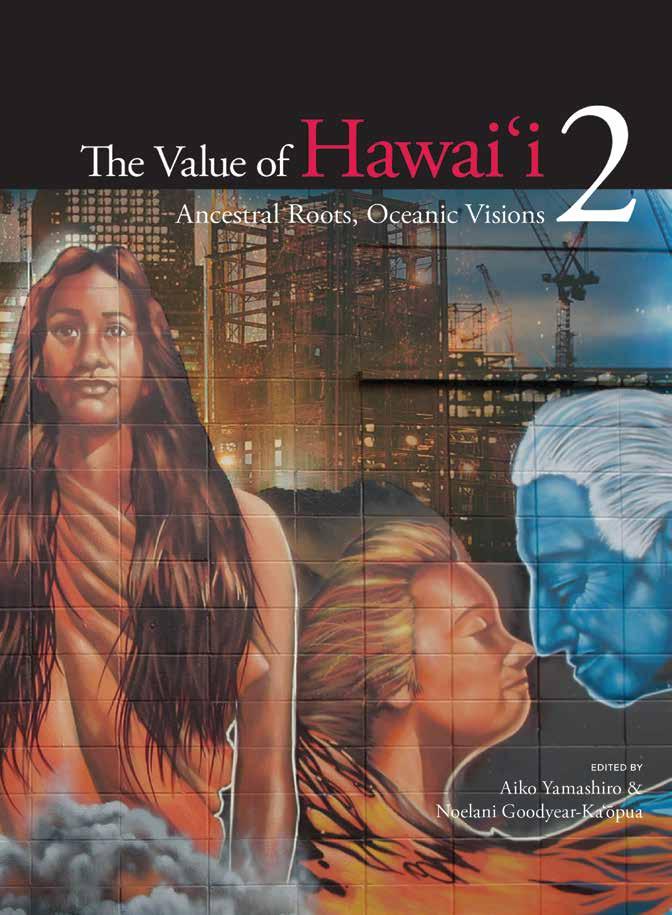
94 | FLUXHAWAII.COM

what it means to work for the people of Hawai‘i, now.
The Value of Hawai‘i volumes are, in part, a reaction to policy discussions that have been informed by The Price of Paradise: Lucky We Live Hawaii? and The Price of Paradise II, first published in 1992, which decry tax rates, business markets, and development culture across the state. Those volumes remain influential because their editors were not skittish about discussing economics or whose rights matter in an island community.
The Price of Paradise was itself a reaction to the Hawaiian renaissance and a judicial return to island values, which had been absent for half a century. Legal decisions from 1966 to 1982 by the Hawai‘i Supreme Court penned by Chief Justice William S. Richardson, the first Hawaiian chief justice since the overthrow, challenged Anglo-American notions of property law.
“Our examination of the relevant legal developments in Hawaiian history leads us to the conclusion that the western concept of exclusivity is not universally applicable in Hawaii,” the Court famously wrote in defense of the public’s access to the sea. Limits were placed on landowners’ rights to develop, improve, and exclude property. The Court granted the public access to the “upper reaches of the wash of the waves,” citing laws of the Hawaiian Kingdom.
In retrospect, as discussed in The Price of Paradise, the private-property developers won. Hawai‘i now ranks fourth among states with the most millionaires per capita. The south shores of Kaua‘i and Maui and the west sides of Hawai‘i Island and O‘ahu have seen the development of massive resorts in the intervening years. The discussions of ideology regarding property and value systems are becoming as apparent as construction cranes. Honolulu’s interior is now experiencing aggressive commercial development with questionable outcomes for the state’s middle class. “We know that our children and grandchildren will carry the full weight of ecological and social problems, such as climate change, growing economic inequality, and erosion of public safety net services, which have been left to us to address,” write Yamashiro and Goodyear-Ka‘ōpua. And the way they address those issues are the ways they have been taught by family and academia: through stories of hope, work, and joy.
The Value of Hawai‘i 2: Ancestral Roots, Oceanic Visions
Edited by Aiko Yamashiro and Noelani Goodyear-Ka‘ōpua.
Released April 2014.
320 pp. University of Hawai‘i Press. $19.99

A VERSION OF HAWAI‘I
AN EXHIBITION AT THE HONOLULU MUSEUM OF ART SHOWS HOW THE ART DECO MOVEMENT DEFINED OUR ISLAND AESTHETICS.
REVIEW BY DAVID A.M. GOLDBERG
The Honolulu Museum of Art’s Art Deco Hawai‘i brings together paintings, sculptures, illustrations, prints, furniture, and housewares whose subjects and patterns were inspired by the landscape, flora, and indigenous culture of Hawai‘i. Some of these works, particularly the murals of Eugene Savage, are being shown in public for the first time since their creation. Others, like the paintings of Madge Tennent, take on a new meaning when they are associated with those of Arman Manookian, bas-reliefs by Marguerite Blasingame, handcarved perfume bottles by Fritz Abplanalp, and massproduced souvenir figurines of topless Hawaiian women.
This chapter of modern art’s history in Hawai‘i is largely told by non-Hawaiian artists who “fell in love” with the islands’ indigenous people, culture, and ecology. In the intricate and exemplary depictions of flowers and mountain ranges by the likes of Juliette May Fraser and Lloyd Sexton, the landscape is unspoiled by civilization. When Native Hawaiians are represented, as in Eugene Savage’s murals commissioned by Matson Lines, they are portrayed as carefree primitives enjoying the bounties of the land, sea, and each other. Through epic images like these, and a plethora of more humble or kitschy examples, viewers can come to recognize the roots of the persistent commercial image that Hawai‘i sells to itself and the world.
One of a set of paintings that decorated the walls of the Green Mill Grill in Honolulu in the late 1920s,
“Men in an Outrigger Canoe Headed for Shore,” 1929, Arman Tateos Manookian. Oil on canvas. Collection of Drew Brown.
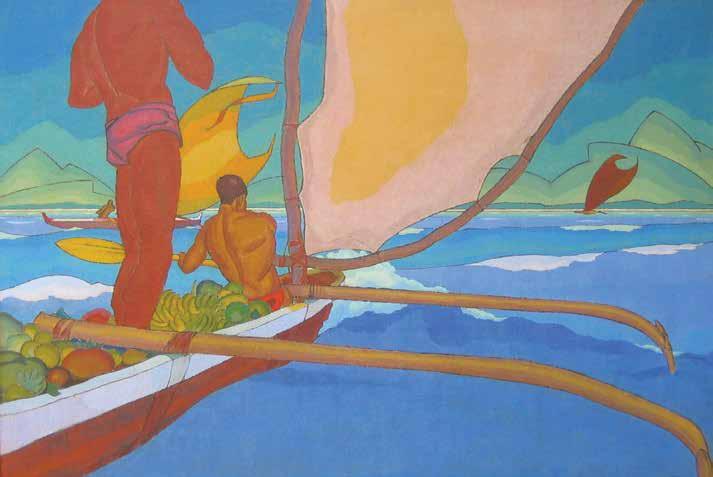
“Hawaii’s Decisive Hour,” 1940, Eugene Savage. Collection of Matson.
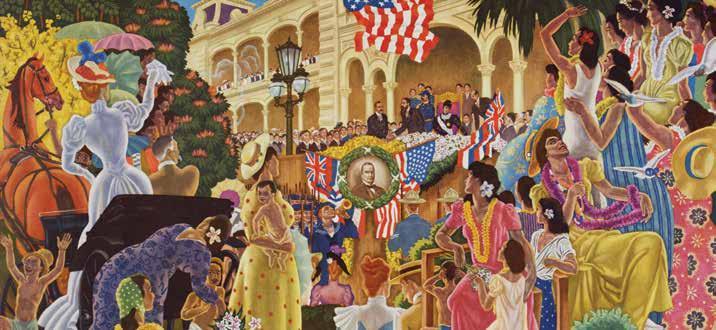
96 | FLUXHAWAII.COM
ARTS / COMMUNITY / BOOKS VIEWS IN FLUX


Manookian’s “Men in an Outrigger Canoe Headed for Shore” presents clichés found elsewhere in the show—the sea, sky and land, and the Hawaiian native laboring casually—but Manookian pushes them into a territory of abstraction and color. His canoe sails are stylized triangular gestures that echo a mountain range crossing the horizon like waves in profile. A thin line of distant beach sand reiterates the bold horizontals of the outrigger and the paddler’s oar. Anticipating the kinds of viewpoints that today are achieved with boom-mounted cameras and GoPros, the viewer hovers over the ocean, perspective vanishing where the canoe’s prow cuts a wave and the sail’s rigging intersects with the hull.
If it weren’t for the outrigger bearing a cargo of fruit, Manookian’s composition could easily be taken for a modern commercial image promoting a hotel resort, swimwear, waterman’s gear, or ocean conservation. Even if such a painting wasn’t meant to be a sales pitch, the show’s collection demonstrates how the global popularity of Art Deco’s stylistic conventions ultimately served commercial interests and established the framework of today’s visual culture. Many contemporary tourist brochures, high-end magazines, and visitors’ Instagram feeds borrows from Art Deco motifs: blooming flowers; brown, muscled men paddling outrigger canoes; women in suggestive poses; and the overloaded lū‘au table.
The work is all heavily stylized, as that’s the underlying appeal of Art Deco’s clean lines, bold geometry, and flattened perspectives inspired by Egyptian hieroglyphics. But this stylization distorts and erases history; the success (and nostalgia) that such art welcomes is achieved at the expense of actual Hawaiian culture. One need look no further than Eugene Savage’s “Hawaii’s Decisive Hour,” a depiction of Hawai‘i’s 1898 annexation by the United States, to appreciate the severity of this distortion. Savage’s tableau is precise in its rendition of ‘Iolani palace, the fantastic carriage one woman is riding in, and Queen Lili‘uokulani’s clear resignation. But it is far from accurate in other ways, as the moment was certainly not celebrated by throngs of hula-dancing Hawaiians in Western dress. By bringing this array of works together, curator Theresa Papanikolas reveals the inspiration and appeal of the Art Deco movement, but the show’s historical significance is only the tip of the iceberg. Many will see this show for the aesthetics and the nostalgia associated with so many of these images. But thanks to clear and impartial wall text, visitors will also be challenged to consider how the qualities of any given work cannot be separated from the complex politics of its subject matter nor the circumstances around which it was produced.
Art Deco Hawai‘i will be on display through January 11, 2015 at the Honolulu Museum of Art, 900 Beretania St. For more information, visit honolulumuseum.org.
FLUXHAWAII.COM | 97
VIEWS IN FLUX
PUBLIC SOLUTIONS
TO ADDRESS THE CITY’S HOMELESSNESS ISSUE, THE PUBLIC NEEDS TO GET INVOLVED.
TEXT BY JEFF MULL
ILLUSTRATIONS BY LORD GALACGAC
It’s no secret that Honolulu’s growing homeless population has created a slew of challenges for both the city and our local businesses. Whether it’s Waikīkī, Kailua, or Chinatown, finding a solution that compassionately addresses the issue has proven to be one of the most difficult tasks to face O‘ahu in some time. Earlier this year, the city passed a budget that allocated a total of $56 million to address housing issues for homeless. And while funding for programs like Housing First (in which the city essentially pays for apartments for the homeless in hopes that this leads them to services) have proven to be effective in other American cities, the mayor’s office and the city council have failed to pass such measures as multiple sit-lie bills and a bill against public urination and defecation. While city officials scratch their heads, the businesses, residents, and homeless are left to suffer.
So what are we to do? How can the people, the businesses, and the residents of one of America’s great cities take part in helping turn the tide of homelessness in Honolulu? We take action. We find a way to work with the city to spur change. We share the burden and we do our part to help solve a problem that’s affecting all of us. We get off the sidelines and into the game.
Now what does that entail? First and foremost, it means talking to your neighbors. It means brainstorming sessions over coffee. It means creating neighborhood coalitions to address the problem. In Chinatown, an area that is home to more than its share of the homeless population, we’re beginning to do just that. We’ve started a neighborhood coalition of business owners and residents, and we’re working together with different outreach
“How can the people, the businesses, and the residents of one of America’s great cities take part in helping turn the tide of homelessness in Honolulu? We take action. “

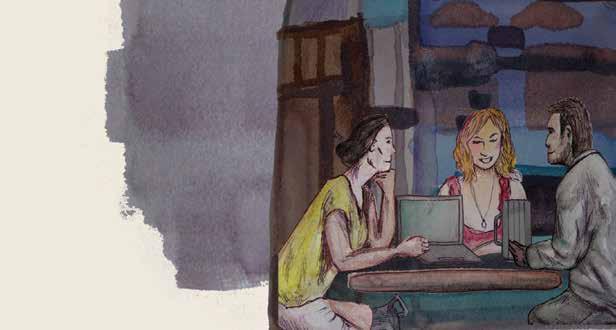
98 | FLUXHAWAII.COM
BOOKS
ARTS / COMMUNITY /


organizations to see what we can do, as private citizens, to help. We’re cleaning up graffiti. We’re sprucing up vacant buildings with new signage. We’re adopting blocks of the street and ensuring that they’re cleaned on a daily basis, and we’re communicating with organizations like Institute for Human Services and Mental Health Kokua to assist them in identifying the homeless individuals who are in need of the most help.
Right about now, I’m sure you’re wondering if our efforts are in vain. The answer is no. While we’ve yet to turn River Street into a gleaming sign of success, our efforts are slowly paying off. Various organizations that include Safe Haven, a branch of Mental Health Kokua, and IHS are teaming up to create a seven-man team who will walk the streets of Chinatown, building relationships with each homeless person and helping to deliver the services they need. (One outreach worker estimates that nearly 40 percent of the homeless individuals he interacts with eventually get help and receive some sort of treatment). We’re creating a new voice for Chinatown and we’re being heard. And it’s all because we decided to take action.
This isn’t going to be a quick solution. But this is a solvable problem. Making real change is going to require time, energy, and the coordination of the community and the government. But above all, it’s going to require getting involved. Whatever you do, do something. Because pretending that we don’t have a problem, or worse yet, hoping that someone else will solve it for us, isn’t doing the city—or the homeless on the streets—any good.

CONFRONTING PAST GHOSTS
ALL HAWAI‘I RESIDENTS MUST ACKNOWLEDGE
THEIR ROLE IN HAWAI‘I’S PAST IF WE ARE TO MOVE TOWARD A MORE JUST FUTURE.
TEXT BY TINA GRANDINETTI
ILLUSTRATION BY LORD GALACGAC
In 1976, 12 years after John Dominis Holt helped light the fire of the Hawaiian Cultural Renaissance with his famous essay “On Being Hawaiian,” he penned the novel Waimea Summer. Considered semi-autobiographical, the coming-of-age tale of Mark Hull speaks to the pain that precedes mental decolonization. In the 1930s, 14-year-old Mark, a hapa haole (part Native Hawaiian, part Caucasian) from Honolulu, spends a summer with his uncle in Waimea on the Big Island. Fascinated and disturbed by the “Hawaiianness” of Waimea—so different from bustling Honolulu—the experience shakes Mark’s conceptions of self, family, and history. Afraid of a past he does not understand, his initial eagerness gives way to a growing obsession with the ghosts that thrive in the Waimea mist, so much so that even in happier moments, he finds himself in mourning. At a family lū‘au, in a time of celebration, Mark thinks, “Hawaiian songs too often were a hearkening to the past, to your people, reminding you always of breakdown and defeat.” He wistfully notes, “I wanted to leave the scene, shake off its cloying grasp, and rush down to Kawaihae to be carried home to the comforting banalities of life in Honolulu.”
The summer of 2014 passed in Honolulu as any, in sunny increments of cool trade winds and hot days. However, this season brought new things on the wind, as
Instead of looking away, we must begin to ask how to take responsible action toward righting historically rooted injustices.
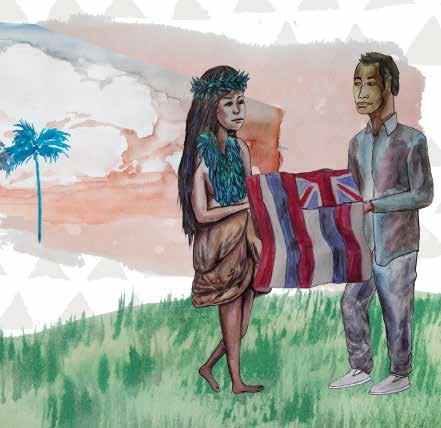
100 | FLUXHAWAII.COM
BOOKS
ARTS / COMMUNITY /
VIEWS IN FLUX


state- and federally sanctioned efforts to begin the process of federal recognition of a Native Hawaiian governing body (likening Native Hawaiian recognition to that of Native Americans) were challenged by voices calling for Hawaiian independence from the United States. To me, a non-indigenous person with a commitment to social justice in Hawai‘i, the energy was electric, yet I struggled with two impulses. One, that as a settler in an occupied nation, sovereignty is none of my business; the other, that I haven’t done enough to acknowledge my role in the present political structure.
Sovereignty can be a difficult thing for non-Hawaiians—those who have lived in Hawai‘i for generations, as well as newcomers to the islands–to talk about seriously and thoughtfully. There are many reasons for this: respect for or misunderstanding of the Hawaiian nation’s history, a feeling of being threatened by the movement, or plain disinterest. While disarticulating sovereignty issues from other social justice issues can help to protect indigenous rights to selfdetermination, the idea that sovereignty is of no import to non-indigenous people excuses us from examining our roles as settlers in an occupation nation. Instead of looking away, we must begin to ask how to take responsible action toward righting historically rooted injustices.
Occupation has a way of hurting both the occupied and their occupiers— natives and settlers alike, removed from their histories and trapped in an unjust and unequal cycle of power. Mark’s impulse to escape to Honolulu, where the “banality” of urban life allows him to sink back into indifference, is perhaps what non-indigenous people often do when confronted with issues of
sovereignty and occupation, when our cozy identities as “locals” and “kama‘āina” are replaced with harsher words like settler or colonizer. These loaded terms, however, acknowledge that our roots in Hawai‘i have come at a high cost to the Hawaiian people; their alienation from land, socioeconomic marginalization, and political occupation pay the price for our bond with these islands.
If the emotional tumult of Waimea Summer is a reflection of Holt’s experience with the fearful beginnings of decolonization, “On Being Hawaiian” affords us a glimpse of what may await us on the other side of this journey. That essay was a bold call for aloha ‘āina that would serve as a catalyst for a movement of cultural and political revitalization. But as Native Hawaiian activist and academic Noelani Goodyear-Ka‘opua writes, settlers can also engage in aloha ‘āina by “actively supporting Kānaka Maoli (Native Hawaiians) who have been alienated from ancestral lands to reestablish those connections and also helping to rebuild Indigenous structures that allow for the transformation of settler-colonial relations.”
At the end of Waimea Summer, the ghosts of colonization are too much for Mark; he flees to Honolulu, desperate to leave them behind. But Mark’s story is fiction, and the story of Hawaiian lāhui, the Hawaiian nation, promises to be different. Like Holt, whose literary legacy tells of conflict and struggle giving way to pride and love for his people, Kānaka Maoli have not fled from the ghosts of their past, but have diligently worked to bring them to the present. Now, as their struggle gains momentum, settlers must decide if if we will look back and acknowledge our ghosts as well.
102 | FLUXHAWAII.COM

FOR VSP BOTTLE SERVICE, GUEST LIST AND GROUP RESERVATIONS: CONTACT INFO@ELEVEN44HAWAII.COM FIND US, FOLLOW US @ ELEVEN44HAWAII.COM

CULINARY STAYING POWER
ROY’S HAS BEEN A DRIVING FORCE IN DINING IN HAWAI‘I FOR MORE THAN A QUARTER-CENTURY.
Since opening the first location in 1988, Roy’s has been a dining institution throughout the islands. Roy’s popularity with both locals and visitors alike is unequaled. Roy and his ‘ohana have managed to continue to evolve in an industry known for constantly changing tastes.
Chef Roy Yamaguchi inspires and empowers the executive chefs at the 30 locations worldwide to create the very best with what the local markets have to offer. At the original location in Hawai‘i Kai, overlooking the tranquil Maunalua
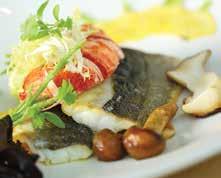
Bay, guests come for Roy’s “classics” such as the macadamia nut crusted mahimahi or the blackened island ahi, or they may be swayed by the many other fresh fish
offerings that were still swimming only hours before.
On this particular day, Hawai‘i Kai’s executive chef Chris Garnier is awaiting the arrival of a local catch of ‘opelu, which were once highly prized by the ali‘i (monarchs) of Hawai‘i but fell out of favor more recently due to people’s taste for more classic preparations of open-ocean species. Garnier will prepare the ‘opelu just the way locals like it, pan-fried to a delicate crisp. It is a perfect appetizer for sharing. Though you won’t find this appetizer on menus at other Roy’s, you will find equally unique dishes that are the inspirations of passionate executive chefs at each location.
Over the last 25 years, Roy’s has become an institution, integrating the very best of Hawai‘i’s bounty with the rich cultural heritage that is Hawai‘i.
104 | FLUXHAWAII.COM PROMOTIONAL
URBAN STYLE + ISLAND SPIRIT
Within the fun and excitement in the heart of Waikīkī, Aqua Oasis hotel has recently been transformed with a $2.5 million dollar renovation. Formerly the Waikiki Joy, the newly renovated 96room hotel offers redesigned guest rooms, common areas, and exterior landscaping that showcases an alluring blend of a fresh, urban loft that meets island paradise.
The spacious suites and loft-like units, designed by San Francisco’s Anthony

Laurino, are perfect for small groups and traveling families. Stylish guest room design elements, such as bold patterns and bright color accents, with a backdrop of fresh neutral colors and natural finishes, are reflective of the hotel’s city-based, island location. Larger junior and one-bedroom suites also feature kitchen facilities, perfect for an extended stay or as a home base for the busy traveling family. The open lobby space has also been transformed into a social hub for guests with a welcoming communal feel, especially in the mornings during the complimentary continental
breakfast hours. Guests looking to lounge under the Hawaiian sun are treated to an intimate pool area and chic sun deck surrounded by tropical plants located directly off of the upper lobby area. Tucked away beyond the front desk area is a tranquil koi pond and garden, where guests can unwind after a long day of touring the island of O‘ahu.
The hotel is located within walking distance of the area’s best beaches, fantastic shopping, exquisite dining, and exciting nightlife. Other noteworthy amenities include an on-site karaoke studio and the internationally known Kimukatsu Japanese cuisine restaurant. This is truly Waikīkī’s newest boutique hotel experience, one that is the perfect quiet getaway and retreat in vibrant Waikīkī.
For more information, visit aquaoasishotel.com.
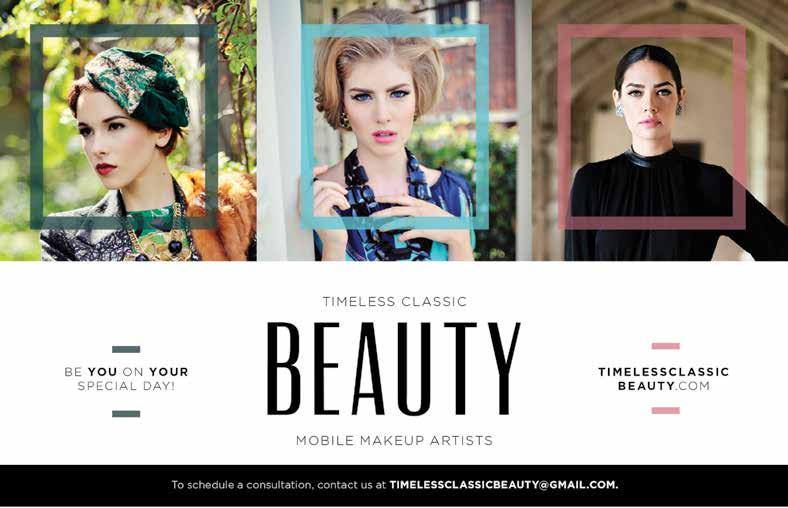
PROMOTIONAL
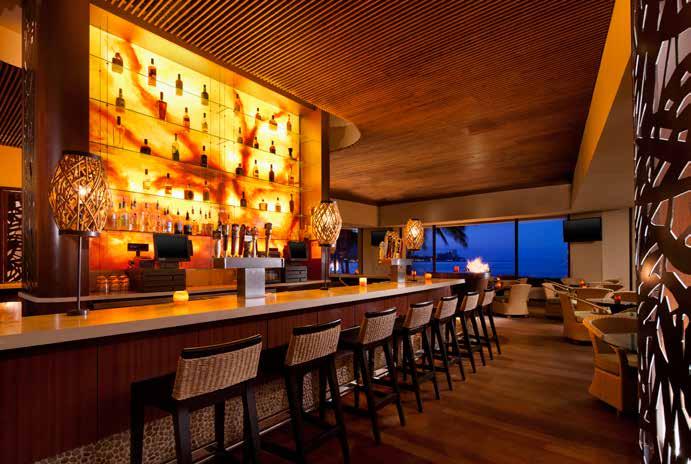
DINE OUT
WITH STARWOOD HOTELS AND RESORTS HAWAII
From fine dining to exotic cocktails, you’ll find an eclectic mix of cuisines to delight your taste buds on O‘ahu at Starwood Hotels and Resorts Hawaii.
RUMFIRE AT SHERATON WAIKIKI
Known for its trendy interior, lively entertainment, and stunning views of Diamond Head, RumFire serves up local favorites with sizzling new twists. Introducing Spiked Afternoon Tea, RumFire “burns up” the traditional
afternoon tea and features bite-sized sliders, delectable desserts, and variations of tea-inspired cocktails.
LEGENDARY MAI TAI BAR AT THE ROYAL HAWAIIAN
Setting the stage for world-class romance and elegant relaxation, the legendary Mai Tai Bar at The Royal Hawaiian has been the destination for Hollywood stars, international jet-setters, heads of state, and kama‘āina for decades. Live local entertainment melds with exotic handcrafted cocktails to provide the perfect atmosphere for winding down from a day at the beach or igniting an evening of island fun. Just steps away from the sands of Waikīkī Beach, Mai Tai Bar will leave you with an indelible imprint of Hawai‘i’s idyllic lifestyle.
VERANDA AT MOANA SURFRIDER
The ambiance at the Moana Surfrider’s Veranda is tranquil and relaxing, evoking memories of yesteryear beneath the Moana’s historic banyan tree. Indulge in a Waikīkī tradition of fine teas, elegant finger sandwiches, and sweet pastries.
KAI MARKET AT SHERATON WAIKIKI
Inspired by the plantation era that brought an influx of ethnic cuisine to the islands, Kai Market offers traditional Hawaiian delicacies using the freshest locally grown products. Nosh on Kai Market’s fare while enjoying the cool tradewinds near the resort’s new infinity edge pool and Waikīkī Beach.
For more information, call 808-921-4600 or visit dininginhawaii.com
106 | FLUXHAWAII.COM PROMOTIONAL
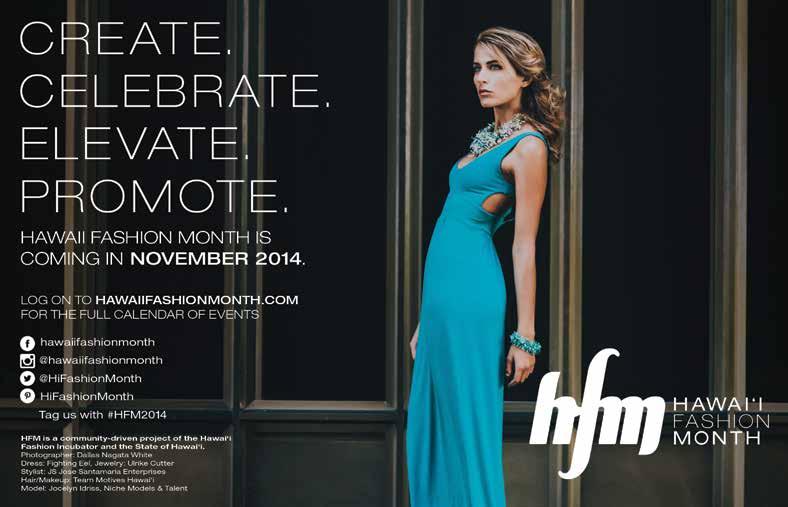

Mention this ad when booking and: Receive a complimentary treatment with any service. *One treatment per person may not be combined with any other offers. While supplies last. EXPIRES JAN 2015 808.533.3200 cs@citizen-salon.com 12 South King Street, #3, Honolulu, HI 96813 citizen-salon.com
Editor’s Note: This is a small sampling of the notable locally owned and operated restaurants and shops that the islands have to offer. These listings are unpaid and independent of advertising.
O‘AHU
TASTE
KEY:
$ INEXPENSIVE
$$ MODERATE
$$$ MODERATELY EXPENSIVE
$$$$ EXPENSIVE
12TH AVENUE GRILL
$$$
1120 12th Ave. (808-732-9469) 12thavegrill.com
The fresh flavors of local produce paired with chef finds like skate and farmed organic New Zealand King Salmon make for bold and interesting tastes and textures at this contemporary American restaurant.
BRASSERIE DU VIN
$$
1115 Bethel St. (808-545-1115) brasserieduvin.com
Channeling many of the cafés found in southern France, this quaint indoor-outdoor patio location serves up rustic dishes with an expansive wine list.
CAFÉ JULIA $$
1040 Richards St. (808-533-3334) cafejuliahawaii.com
Located at the Downtown YWCA, this historic café pays homage to those quiet mid-afternoon hours. Enjoy its simple elegance with friends or a good book.
GUIDES
COCINA $
667 Auahi St. cocinahawaii.com
Enjoy street food-style eats like headcheese carnitas tacos and Mexican-style sandwiches—all made with local, sustainable ingredients—at this James Beard semi-finalist’s nose-to-tail taquería.
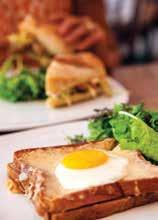
GRONDIN
$$
62 N. Hotel St. (808-566-6768) grondinhi.com
From a juicy, bone-in chuleta (pork chop) with saffron rice to shrimp ceviche with fried plantains, this unassuming French-Latin bistro will surprise you with its eclectic, perfectly prepared fare.
HASR BISTRO $$
31 N. Pauahi St. (808-533-4277) hasrbistro.com
With an impressive lineup of live, local music and a tremendous wine selection via the accompanying wine shop next door, this Chinatown spot is great for lunch, pau hana, or dinner.
JJ DOLAN’S $$
1147 Bethel St. (808-537-4992) jjdolans.com
This Irish pub stands out for its handcrafted New York pizza and hand-poured drinks. Follow it on Twitter for daily pizza specials.
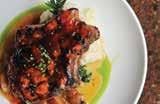
KALAPAWAI CAFÉ & DELI $$
750 Kailua Rd. (808-262-3354) kalapawaimarket.com
This spacious bistro-style stop features an impressive smallplate menu with a focus on clean, seasonal flavors and tidy presentation. The Okinawan sweet potato and goat cheese ravioli in thyme and almond brown butter sauce is a must-try.
KOKO HEAD CAFÉ $$ 1145c 12th Ave. (808-732-8920) kokoheadcafe.com
Recently relocated celebrity chef Lee Anne Wong’s Kaimukī breakfast sensation focuses on the bounty of local foods Hawai‘i has to offer, featured in piled-high hearty skillets and indulgent but balanced sweets.
LUCKY BELLY $$
50 N. Hotel St. (808-531-1888) luckybelly.com
Lucky Belly champions contemporary Asian dining and features a late-night window open Thursday through Saturday until 2 a.m. You won’t regret ordering the belly bowl, a rich ramen with pork belly, bacon, and sausage.
THE MANIFEST $
32 N. Hotel St. (808-523-7575) manifesthawaii.com
This downtown favorite is a modern coffee shop by day and whiskey bar by night, featuring popular deejays, rotating art exhibitions, and small bites.
MOKÉ’S BED
& BREAKFAST $$ 27 Hoolai St. (808-261-5565) mokeskailua.com
From lilikoi pancakes “that will change your life” (they will) to farm-fresh omelets and homemade bread, this family-owned-and-operated breakfast spot is a must when visiting Kailua.
MORNING GLASS $ 2955 E. Manoa Rd. (808-673-0065) morningglasscoffee.com
Featuring some of the island’s best coffee, this cool café also offers playfully innovative eats from artisan sandwiches and baked goods to a full breakfast menu.
MW RESTAURANT $$$ 1538 Kapiolani Blvd. (808-955-6505) mwrestaurant.com
The collective experiences of the husband and wife duo who own this restaurant—who in the past have worked in the kitchens of Alan Wong’s, The French Laundry, and even Zippy’s—inform the contemporary Hawai‘i regional menu.
TASTE
108 | FLUXHAWAII.COM
GRONDIN
KALAPAWAI CAF É
THE PIG AND THE LADY
$$
83 N. King St. (808-585-8255) thepigandthelady.com
Inspired by his mother’s home-cooked meals, chef Andrew Le presents contemporary French-Vietnamese fare that includes traditional dishes alongside those for the adventurous eater (like an entire pig’s head).
PINT + JIGGER $$
1936 S. King St. (808-744-9593)
pintandjigger.com
Escape for a moment at this modern public house, which intertwines craft beers and original cocktails with savory food in a classic social atmosphere.
comfort food made entirely from scratch.
TANGO CONTEMPORARY CAFÉ
$$
1288 Ala Moana Blvd., Ste. 120 (808-593-7288)
tangocafehawaii.com
Enjoy Scandinavian and Asian-inspired cuisine in a contemporary, minimalist atmosphere that makes you feel like you’re picnicking in a park.
TOWN
$$
3435 Waialae Ave. (808-735-5900)
townkaimuki.com
HALI‘IMAILE
GENERAL STORE $$$ 900 Hali’imaile Rd. (808-572-2666) bevgannonrestaurants.com/ haliimaile
Dine at an old plantation-style home converted into a bright, casual restaurant featuring eclectic American food with Asian undertones.
LA PROVENCE $$
3158 Lower Kula Rd. (808-878-1313) aprovencekula.com
Nestled in Kula, this French dining alcove attracts guests from all over the island with a substantial crepe menu and a wide selection of pastries; close your eyes and you could be in Paris.
SALT KITCHEN & TASTING BAR
3605 Waialae Ave. (808-744-7567) salthonolulu.com
$$
With an emphasis on housemade charcuterie, Salt may well have come up with the tastiest small-plate menu in Hawai‘i by being innovative with classics.

SCRATCH KITCHEN
& BAKE SHOP $$ 1030 Smith St. (808-536-1669) scratch-hawaii.com
At this all-day, southern-inspired breakfast joint, enjoy
One of the pioneers of Hawai‘i’s farm-to-table movement, Ed Kenney continues sourcing the best local ingredients and featuring them at his unpretentious American bistro.
VIA GELATO $ 1142 12th Ave. (917-674-5827) viagelatohawaii.com
This charming gelato shop incorporates seasonal produce and Hawai‘i heritage into its rotating variety of flavors, including lilikoi, coconut black sesame, and green tea haupia.
MAUI
CAPISCHE? $$$$ 555 Kaukahi Rd. (808-879-2224) capische.com
This romantic garden-side restaurant serves a fusion of fare from southern France and northern Italy, with impeccable service by a wait staff that’s easy on the eyes.
LEODA’S KITCHEN & PIE SHOP $$
820 Olowalu Village Rd. (808-662-3600) leodas.com
Boasting casual, family-style dining in a comfortable plantation-era atmosphere, Leoda’s features farm-fresh and sustainable ingredients in its handcrafted sandwiches, salads, baked goods, and of course, pie.
MATTEO’S OSTERIA $$$
161 Wailea Ike Pl. (808-891-8466) matteosmaui.com
This traditional Italian eatery with a dash of modern flair serves fresh, regional specialties like house-made pastas and pizzas alongside Maui’s largest by-the-glass wine selection.
 SCRATCH KITCHEN
SCRATCH KITCHEN
MAUI KOMBUCHA $
810 Kokomo Rd.
(808-575-5233) mauikombucha.com
Perfect for the health-food enthusiast, this café serving raw food and freshly made kombucha is the cheaper, healthy alternative to a daytime drunken adventure in case you don’t have the money (or patience) to roam around the lecture-filled wineries on Maui.
MIGRANT MAUI $$
Wailea Beach Marriott, 3700 Wailea Alanui Dr. (808-875-9394) migrantmaui.com
Island flavors and grandma’s cooking inspire this Top Chef finalist’s Wailea restaurant, which includes contemporary takes on Filipino classics alongside Asian-fusion fare.
PACIFIC’O $$$
505 Front St. (808-667-4341)
pacificomaui.com
A dining experience setting the new standard for farm-to-table cuisine, this beachfront restaurant features a contemporary menu from the land and the sea.
RODEO GENERAL STORE $$
3661 Baldwin Ave. (808-572-1868)
They say you find wonder in the most unexpected of places, and the same could be said of this convenience store where you can pick up picnic food for a day at the beach or stop in to gawk at a selection of vegan bread alongside fine wine.
SAM SATO’S $
1750 Wili Pa Lp.
(808-244-7124)
With simple and flavorful noodles dishes, this local favorite hole-in-the-wall is comfort food at its best, with offerings like dry mein, teriyaki beef sticks, and manju.
STAR NOODLE $$
286 Kupuohi St. (808-667-5400)
starnoodle.com
Enjoy fresh, house-made noodles and other Asian specialties like the Filipino bacon and eggs or the Vietnamese crêpe at this renowned contemporary restaurant.
TASAKA GURI GURI $
70 E. Kaahumanu Ave.
(808-871-4513)
Ice cream lovers will want to sample Tasaka’s famous creamy sherbet traditionally served in two flavors: strawberry and pineapple. Around for years, their (low) price is just as novel as the dessert treat they soft-serve.
HAWAI‘I ISLAND
BUNS IN THE SUN $ 75-5595 Palani Rd.
(808-326-2774)
bunsinthesunhawaii.com
This Kona bakery is known for having Kona’s best baked goods, including croissants, breads, cakes, and pastries, in addition to deli options for breakfast and lunch.
DA POKE SHACK $ 76-6246 Dr. (808-329-7653) dapokeshack.com
This is pokē at its best, featuring cubes of fresh fish tossed with a variety of different ingredients, like Hawaiian salt, limu, avocado, furikake, and soy sauce.
ISLAND LAVA JAVA $$
75-5799 Alii Dr. (808-327-2161) islandlavajava.com
Voted “best breakfast in Kona,” this bistro is the favorite coffee house of residents, using only grass-fed Big Island beef, organic goat cheeses, and other locally grown organic produce. Get there early to snag the yummy pull-apart bread.

KA‘ANA KITCHEN $
Andaz Maui at Wailea Resort, 3550 Wailea Alanui Dr. (808-573-1234) maui.andaz.hyatt.com
Featuring old world flavor with new world innovation, this family style restaurant sources from local farmers, foragers, and locavores.
KANAKA KAVA $
75-5803 Alii Dr. (866-327-1660) kanakakava.com
Enjoy a bowl of certified-organic kava grown locally on the Big Island alongside small pupus in an outdoor bar-like setting.
LA BOURGOGNE $$$
77-6400 Nalani St. #101 (808–329–6711)
Run by a husband and wife duo, this quaint French bistro will surprise you and continually have you saying, “Oui, oui!” Try the brie au four; bisque de homard maison; roti de lapin a’la lavande.
MERRIMAN’S $$$
65-1227 Opelo Rd. (808-885-6822); additional locations online merrimanshawaii.com
A fine-dining experience treating you to the freshest local ingredients paired with the finest of wines. Try the Kahua Ranch lamb, Waipi‘o taro and Lone Palm chickpea falafel, or the Hawaiian hogs butcher’s cut.
ON THE ROCKS $$
75-5824 Kahakai Rd. (808-329-1493) huggosontherocks.com
A casual, toes-in-the-sand restaurant and bar, this oceanview hangout showcases some of the most talented musicians from around the island alongside eats like kālua pig nachos, Kona fish tacos, and the Mauna Kea burger.
TASTE GUIDES
110 | FLUXHAWAII.COM
KA‘ANA KITCHEN

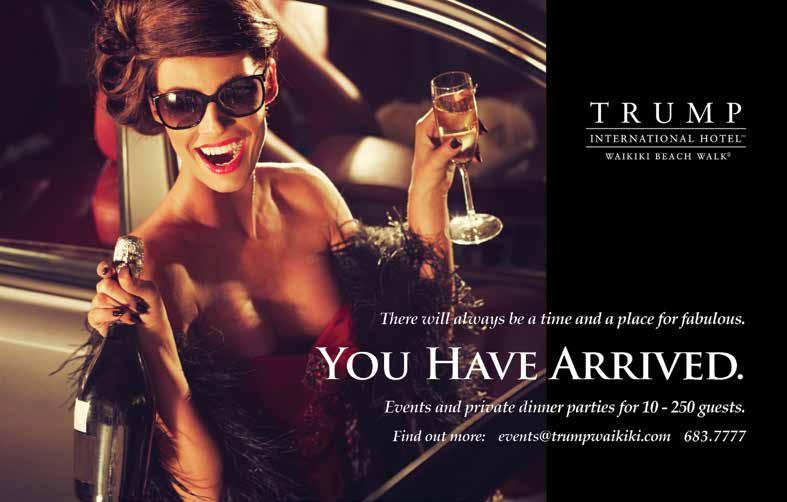
THREE FAT PIGS & THE THIRSTY WOLF $$
69-250 Waikoloa Beach Dr. (808–339–7145)
thethreefatpigs.com
Pairing a restaurant and an upstairs gastropub, this innovative combo offers a lake view with original cocktails and an adventurous style that blends classical European culinary techniques with fresh Pacific Rim ingredients for beautifully created, expertly prepared, and artfully presented dishes.
KAUA‘I
BAR ACUDA
$$$
5-5161 Kuhio Hwy. (808-826-7081)
restaurantbaracuda.com
With cuisine inspired by the Mediterranean regions of Europe, including Southern France, Italy, Spain, and Portugal, this tapas bar is one of Kaua‘i’s coolest places to relax with friends and sip some wine.
DELI & BREAD
CONNECTION $
3-2600 Kaumualii Hwy. (808-245-7115)
Located next to Macy’s in Kukui Grove, this nondescript deli is the place to go for sandwiches made with homemade breads baked fresh daily.
GAYLORD’S AT KILOHANA $$$
3-2087 Kaumualii Hwy. (808-245-9593)
gaylordskauai.com
Using foods found in its backyard garden and from farmers around the island, this farm-totable restaurant pays careful attention to the seasons, tweaking menus each week.
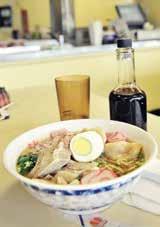
HAMURA’S SAIMIN $
2956 Kress St. (808-245-3271)
Soft, slightly chewy saimin
noodles make this no-frills momand-pop joint a favorite among locals. Don’t leave without trying the barbecue teriyaki sticks and lilikoi pie.
JOSSELIN’S TAPAS BAR AND GRILL $$$
The Shops at Kukui‘ula, 2829 Ala Kalanikaumaka St. (808-742-7117)
josselins.com
This tapas bar features dishes inspired by all parts of the world but uses as many locally grown ingredients as possible.
KALAHEO CAFÉ AND COFFEE CO. $$
2-2560 Kaumuali‘i Hwy. (808332-5858)
kalaheo.com
Nestled in the paniolo town of Kalāheo, where 4,000 acres of coffee fields flow, Kalaheo Café offers lots of breakfast choices and coffee drinks in a breezy, country-market environment.
KOLOA FISH MARKET $
5482 Koloa Rd. (808-742-6199)
The spot for pokē, local style cubes of fresh fish with various seasoning and sauces and other local plate lunch favorites. Cash only.
LIVING FOODS
MARKET & CAFE $$
The Shops at Kukui‘ula, 2829 Ala Kalanikauamaka (808-742-2323) livingfoodskauai.com
Shop at the island’s largest selection of organic, sustainable, and locally grown produce and don’t forget to grab lunch in the market’s café-style restaurant, which serves a simple European menu.
THE FERAL PIG $$
3501 Rice St. (808-246-1100) theferalpigkauai.com
A meat lover’s dream, this pub and diner features breakfast, lunch, and dinner items that read like a shopping list you would bring to a butcher shop.
O‘AHU
FISHCAKE $$$
307c Kamani St. (808-593-1231) fishcake.us
A home furnishings and gallery experience showcasing furniture, accessories, and art for the contemporary home.
IN4MATION $$ Chinatown, 1154 Nuuanu Ave. (808-538-8898); McCully, 2009 S. King St. (808-941-3831); Pearlridge, 98-1005 Moanalua Rd. (808-488-0411) in4mants.com
In4mation’s strength in this niche market is built upon a set of varied experiences, embodying Hawai‘i’s action sports, lifestyle, and retail market. In4mation carries alternative design concepts, eclectic lines, and products for both men and women.
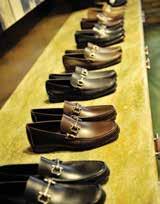
LEATHER SOUL $$$$ Royal Hawaiian Shopping Center, 3rd flr. (808-922-0777); 119 Merchant St. (808-523-7700) leathersoulhawaii.com
This premium retailer of fine leather shoes and accessories keeps gents dashing with handcrafted footwear from such esteemed brands as Alden, Saint Crispin’s, J.M. Weston, and John Lobb.
112 | FLUXHAWAII.COM
/ SHOP GUIDES
LEATHER SOUL
TASTE
HAMURA’S SAIMIN
MANUHEALI‘I $$
930 Punahou St. (808-942-9868); Kailua, 5 Hoolai St. (808-261-9865) manuhealii.com
With new prints every six to eight weeks, this shop is the best place to find unique alohawear that is both comfortable and flattering for everyone.
MARTIN & MACARTHUR $$$
Ward Center Flagship, 1200 Ala Moana Blvd. (808-941-0074); additional locations online martinandmacarthur.com
This retailer of fine koa gifts and accessories carries the widest selection of classic Hawaiian gifts, including koa jewelry boxes, feather lei, and koa bowls, all made by the finest craftsmen in Hawai‘i.

MŌNO $$
2013 S. King St. (808-955-1595) monohawaii.com
Inspired by the careful curation of boutiques in Japan, this lifestyle shop specializes in small design goods for the home and office.
MUUMUU HEAVEN $$
767 Kailua Rd. (808-263-3366) muumuuheaven.com
Each piece is one of a kind at this
eco-conscious boutique, with Hawaiian-style prints and fabrics recycled and repurposed to create fresh apparel that is good to the environment.
OLIVER MEN’S SHOP $$ 49 Kihapai St. (808-261-6587) oliverhawaii.com
A surf-inspired lifestyle boutique, this men’s store features some of the most hard-to-find contemporary brands like Aloha Sunday, Saturdays, Mucho Aloha, and M.Nii.
OWENS & CO. $$ 1152 Nuuanu Ave. (808-531-4300)
owensandcompany.com
Located on a corner in the historic Chinatown Arts district, this bright boutique offers a fantastic collection of home accessories, gifts, and vintage items.
REYN SPOONER $$
Ala Moana Center, Kahala Mall, and Sheraton Waikiki Hotel; additional locations online reynspooner.com
This manufacturer of modern aloha attire has been featuring original patterns and its iconic reverse-print since 1956.
ROBERTA OAKS $$
19 N. Pauahi St. (808-428-1214) robertaoaks.com
With a collection of mod-vibed dresses and sharp aloha shirts, Roberta Oaks is dedicated to supporting ethical practices and a sustainable economy. Expect eco-fabrics like bamboo jersey and organic cotton mixed with bold colors and funky prints.

FLUXHAWAII.COM | 113
M Ō NO
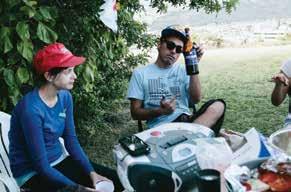
LIFE’S A BEACH [PARK]
TEXT BY BEAU FLEMISTER
IMAGE BY AARON YOSHINO
Some years back, I was going 80 miles per hour down Kamehameha Highway toward the hospital in Kahuku with a friend in anaphylactic shock riding shotgun, his face blue and his hands clutching his throat, when it dawned on me that the entirety of the human experience occurs at a beach park. We had been surfing out at Malaekahana when a Portuguese man o’ war wrapped its tentacle around the forearm of my friend, who had no idea how allergic he was to them. In the ER, it only took a swift shot of adrenaline to the ass and he quickly recovered, but on that mile-long straightaway to Kahuku, I thought he might be a goner.
Love, hope, redemption, death— undeniably, we are a beach-park people. Every single one of us has witnessed or experienced what it is to be human and alive and local at a beach park. At any given time of the day (legally, between the hours of 5 a.m. and 10 p.m.), you will see a celebration of birth. Just watch for the clusters of metallic balloons. You will see
couples taking vows, promising themselves to one another eternally. You will see a mélange of cuisine from all corners of the Pacific served up to mark milestones ranging from graduations to a soldier’s return to a convict’s freedom to an addict’s sobriety to a patient’s remission. You will see a father teaching his son to throw net and a son throwing his father’s ashes out to sea. You will see destitution and homelessness, crews schlepping outrigger canoes, water baptisms, and full-blown political activism and revolution (see Bumpy Kanahele at Makapu‘u circa ’93).
Beach parks are also a place for free, clean water and bathrooms—beachside facilities that are virtually non-existent for citizens in most mainland coastal states. Hell, my communal dorm bathroom at University of Hawai‘i at Mānoa was so filthy my sophomore year that for an entire semester I drove the three miles down to Kaimana Beach Park every night to shower beneath the stars. Beach-park water pressure is fabulous, by the way.
But let’s not forget the most ecstatic of beach-park experiences: flight. And by flight I mean the facilitation thereof by the ubiquitous bouncy castle. From Māili to ‘Ewa to Waimānalo to Kokololio— inflatable empires rise and fall. And you will know them by the trail of giant, puffy-lettered mile markers ushering you toward Bronson’s 6th Birthday Party. What do you get when you encounter a Dora the Explorer slide-palace vis-à-vis a Hello Kitty chateau behind a Toy Story 3 multibounce? The time of your life, that’s what. Sure, these blow-up kingdoms may take up a bit of scenic real estate, but have you any idea what treasures lie beyond the castle gates? Weightlessness, flying dropkicks, gettin’ double-bounced—eternal youth. Momentary lapses in gravity: only at a beach park.
A commonly heard query from mainlanders visiting Hawai‘i after seeing our vibrant beach-park culture is: “Does anybody work on this island?”
Indeed. We’re working on living.
114 | FLUXHAWAII.COM A HUI HOU
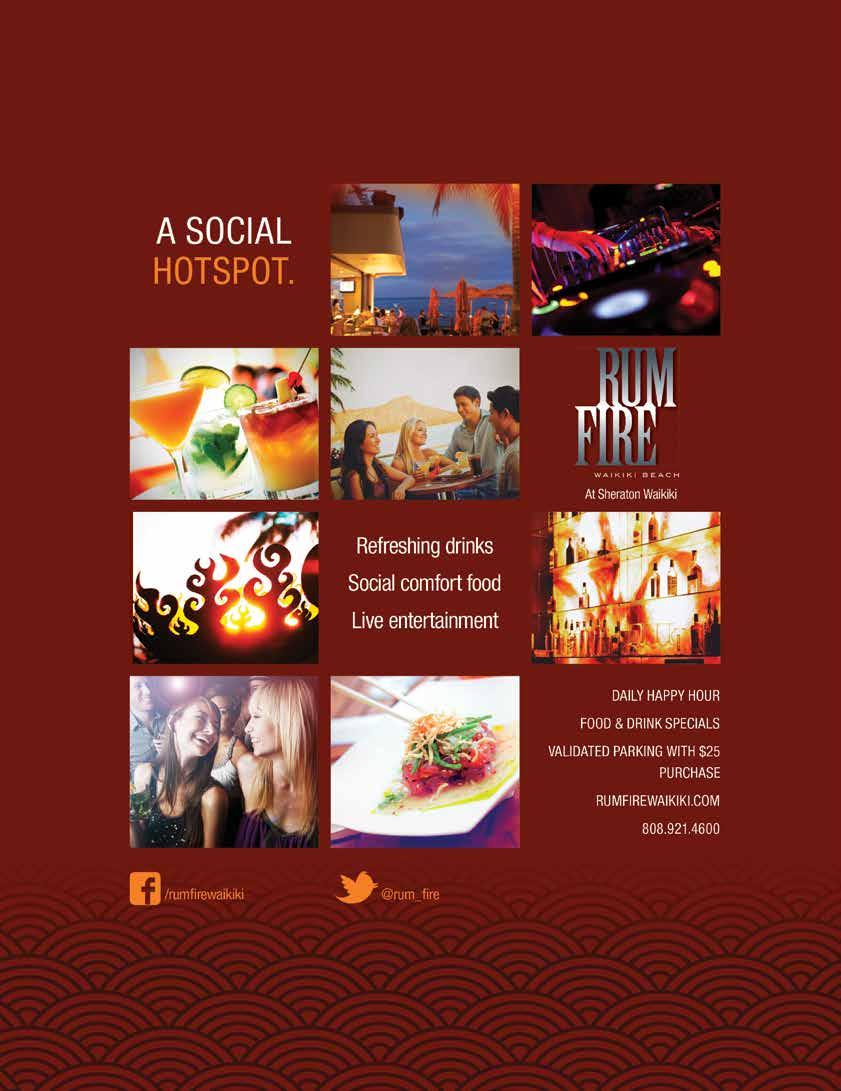
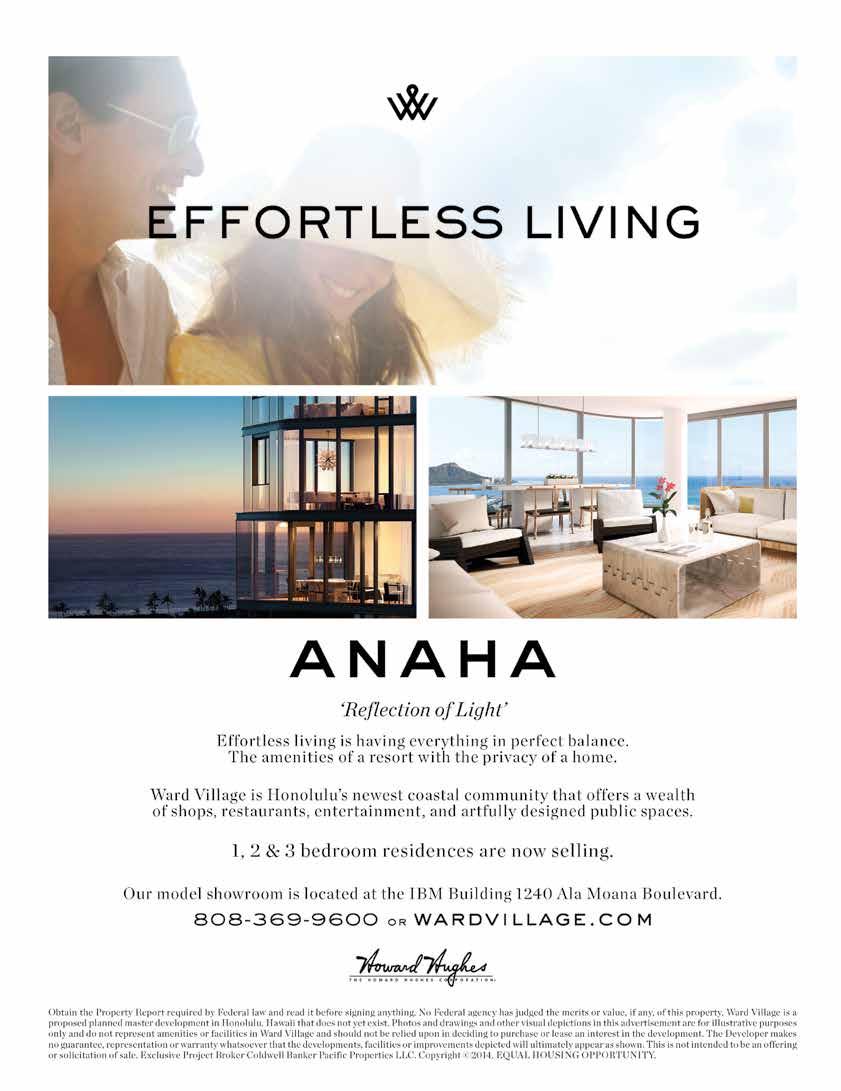




















































 Gaye Chan takes inspiration from 17th-century commoners who engaged in activist planting at the outset of the private-property revolution. “We’re not exactly continuing the work of the diggers, we are the diggers,” she says.
Gaye Chan takes inspiration from 17th-century commoners who engaged in activist planting at the outset of the private-property revolution. “We’re not exactly continuing the work of the diggers, we are the diggers,” she says.



 “Year 7,750, The Wu‘ugone Seed City within the Houdese Womb-World,” 2014, Solomon Enos. Pencil and digital. Opposite: “Year 31,009, A Light-Blood Class Human Seed Ship in transit to the Abūchato‘onalūpapa System via Dream-Space,” 2014, Solomon Enos. Acrylic and digital.
“Year 7,750, The Wu‘ugone Seed City within the Houdese Womb-World,” 2014, Solomon Enos. Pencil and digital. Opposite: “Year 31,009, A Light-Blood Class Human Seed Ship in transit to the Abūchato‘onalūpapa System via Dream-Space,” 2014, Solomon Enos. Acrylic and digital.







 Even in her mid-80s, Alma McGoldrick still hikes to collect the fungus for her exquisite hand-made jewelry.
Even in her mid-80s, Alma McGoldrick still hikes to collect the fungus for her exquisite hand-made jewelry.















 FROM LEFT TO RIGHT: ROBERTA OAKS BROOKLYN BLACK AND WHITE FLORAL SHIRT; REYN SPOONER HAWAIIAN INDIGO BLUE AND WHITE STRIPED SHIRT; ROBERTA OAKS TIKI NIGHTS BLACK AND YELLOW FLORAL SHIRT; ROBERTA OAKS ALOHA TUESDAY BLUE AND PINK FLORAL SHIRT; ROBERTA OAKS PAUAHI PUNCH BLUE AND WHITE FLORAL SHIRT; ROBERTA OAKS NAVIGATION IVORY SHIRT; ROBERTA OAKS SERGIO GREEN AND BLACK FLORAL SHIRT; REYN SPOONER BLUE FLORAL SHIRT; ROBERTA OAKS AUKAI BLUE CANOE SHIRT; REYN SPOONER MUSTARD CANOE SHIRT.
FROM LEFT TO RIGHT: ROBERTA OAKS BROOKLYN BLACK AND WHITE FLORAL SHIRT; REYN SPOONER HAWAIIAN INDIGO BLUE AND WHITE STRIPED SHIRT; ROBERTA OAKS TIKI NIGHTS BLACK AND YELLOW FLORAL SHIRT; ROBERTA OAKS ALOHA TUESDAY BLUE AND PINK FLORAL SHIRT; ROBERTA OAKS PAUAHI PUNCH BLUE AND WHITE FLORAL SHIRT; ROBERTA OAKS NAVIGATION IVORY SHIRT; ROBERTA OAKS SERGIO GREEN AND BLACK FLORAL SHIRT; REYN SPOONER BLUE FLORAL SHIRT; ROBERTA OAKS AUKAI BLUE CANOE SHIRT; REYN SPOONER MUSTARD CANOE SHIRT.

 LEFT, FROM LEFT TO RIGHT: REYN SPOONER BLUE FLORAL SHIRT; ROBERTA OAKS AUKAI BLUE CANOE SHIRT; REYN SPOONER
HAWAIIAN INDIGO BLUE AND WHITE STRIPED SHIRT; THOM BROWNE RED FLORAL SKIRT, PANTS, AND BLAZER AND BLACK
FLORAL DRESS, RESORT 2015. RIGHT, FROM TOP TO BOTTOM: ZAC ZAC POSEN CLUTCH, FALL 2014; ALEXANDER MCQUEEN BLUE FLORAL DRESS, RESORT 2015; J. MENDEL STRIPED DRESS, RESORT 2015; BALLY YELLOW BAG, FALL 2014; CHELSEA
PARIS GRAY BOOT, FALL 2014; KOTUR GOLD CLUTCH, FALL 2014.
LEFT, FROM LEFT TO RIGHT: REYN SPOONER BLUE FLORAL SHIRT; ROBERTA OAKS AUKAI BLUE CANOE SHIRT; REYN SPOONER
HAWAIIAN INDIGO BLUE AND WHITE STRIPED SHIRT; THOM BROWNE RED FLORAL SKIRT, PANTS, AND BLAZER AND BLACK
FLORAL DRESS, RESORT 2015. RIGHT, FROM TOP TO BOTTOM: ZAC ZAC POSEN CLUTCH, FALL 2014; ALEXANDER MCQUEEN BLUE FLORAL DRESS, RESORT 2015; J. MENDEL STRIPED DRESS, RESORT 2015; BALLY YELLOW BAG, FALL 2014; CHELSEA
PARIS GRAY BOOT, FALL 2014; KOTUR GOLD CLUTCH, FALL 2014.

 FROM LEFT TO RIGHT: ALICE+OLIVIA FLOWER PANT AND BLAZER, RESORT 2015; ALEXANDER MCQUEEN RED FLORAL DRESS, RESORT 2015; CHRISTIAN DIOR BLACK AND PINK FLORAL, RESORT 2015; THAKOON FLORAL DRESS, RESORT 2015; ALICE+OLIVIA FLORAL PANT AND CROP TOP, RESORT 2015; THOM BROWNE SKIRT AND SWEATER, RESORT 2015; THOM BROWNE MULTI-FLORAL DRESS, RESORT 2015; THAKOON SKIRT AND SHIRT, RESORT 2015; CHRISTIAN DIOR BLACK AND PINK FLORAL, RESORT 2015; THAKOON FLORAL JACKET AND PANTS, RESORT 2015; CHRISTIAN DIOR SKIRT AND TOP, RESORT 2015.
FROM LEFT TO RIGHT: ALICE+OLIVIA FLOWER PANT AND BLAZER, RESORT 2015; ALEXANDER MCQUEEN RED FLORAL DRESS, RESORT 2015; CHRISTIAN DIOR BLACK AND PINK FLORAL, RESORT 2015; THAKOON FLORAL DRESS, RESORT 2015; ALICE+OLIVIA FLORAL PANT AND CROP TOP, RESORT 2015; THOM BROWNE SKIRT AND SWEATER, RESORT 2015; THOM BROWNE MULTI-FLORAL DRESS, RESORT 2015; THAKOON SKIRT AND SHIRT, RESORT 2015; CHRISTIAN DIOR BLACK AND PINK FLORAL, RESORT 2015; THAKOON FLORAL JACKET AND PANTS, RESORT 2015; CHRISTIAN DIOR SKIRT AND TOP, RESORT 2015.



















































 SCRATCH KITCHEN
SCRATCH KITCHEN









